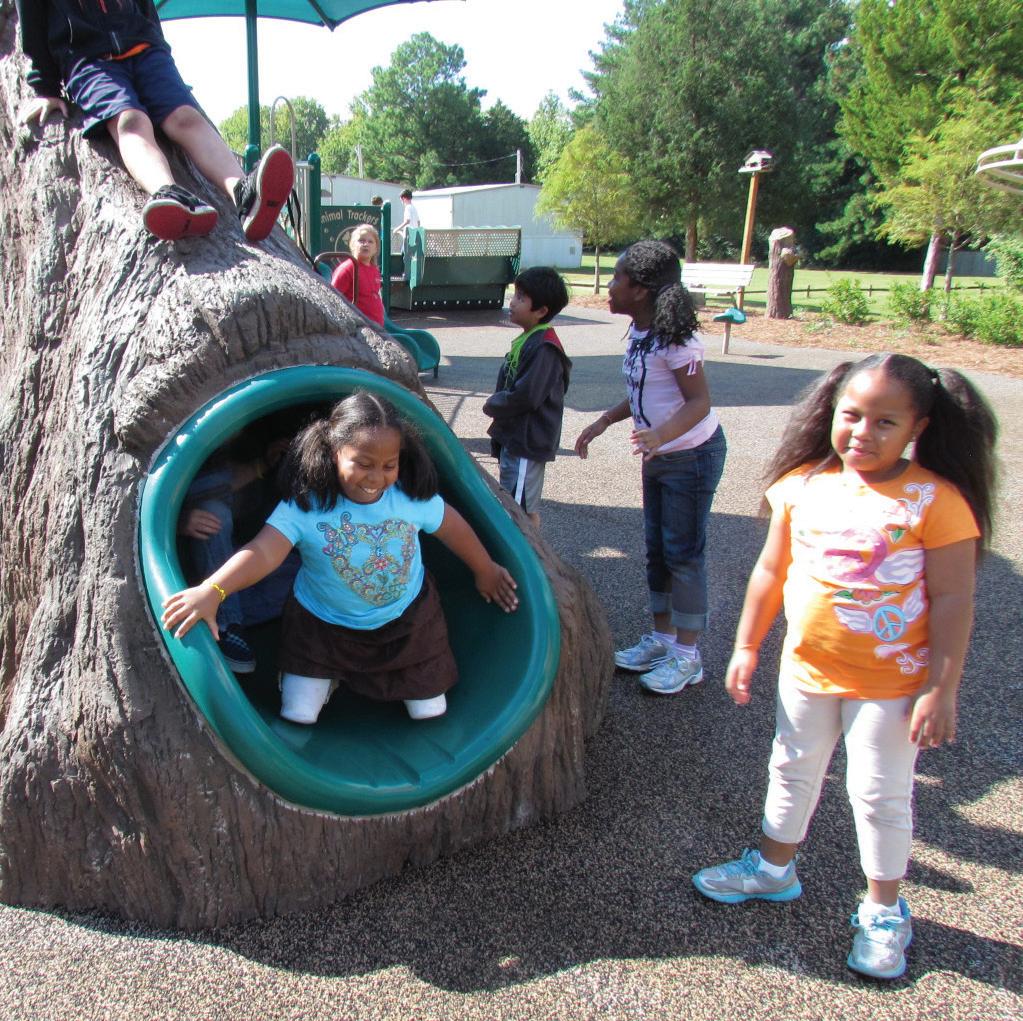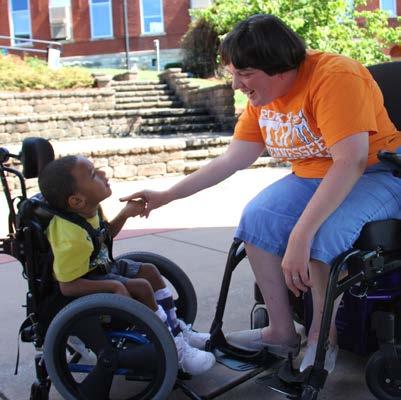

7Principles of Inclusive Playground Design®
A Comprehensive Guide to Best Practice Design for the Whole Child, Whole Environment, And Whole Community

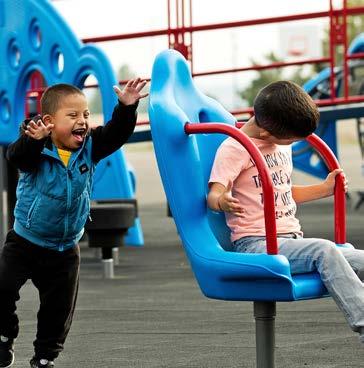
PlayCore’s Center for Outreach, Research, & Education (CORE) is committed to researching and advocating for the impact of play and recreation on a community’s vitality and why it’s valuable to invest in community health and wellness. In collaboration with leaders and scholars, we gather and share knowledge to positively advance diverse community needs through a variety of evidence-based services.
The Institute for Disability Research, Policy & Practice is Utah’s federally designated University Center for Excellence in Developmental Disabilities (UCEDD). IDRPP was established in 1972 by Dr. Marvin Fifield and was the first UCEDD program in the nation to focus on the educational and social needs of children with disabilities. Over its 50-year history, the Institute has grown into one of the largest UCEDD programs in the nation and is recognized as a pioneer in research, training, technical assistance, and services for children and adults with disabilities, families, and the professionals who serve them.
The mission of UCEDD is to create inclusive communities and improve the lives of children and adults with disabilities and their families through sustainable innovation, collaborative research, responsive service, and interdisciplinary training and education.
Special Thanks to the Following Contributors:
Disabilities Studies & Design- Program Author, Keith Christensen, RLA, Ph.D. - Utah State University
Family & Human Development- Audrey Juhasz, Ph.D. - Utah State University
Assistive Technology- Bora Lee, Ph.D. - Utah State University
Inclusion & Accessibility Specialist - Bill Botten - Retired from the U.S. Access Board
Acknowledgement:
To the many inclusion champions, whose expertise and insight have guided and supported this resource. Our deepest respect and gratitude to Jean Schappet, whose passion and advisement helped shape the inclusive playground movement for future generations, and to the many children and families who continue to inspire and amaze us.
PlayCore develops and disseminates high-quality research and publications, and we are unwavering in our commitment to accessibility and the right of all people to learn and participate. For special accommodations or an alternate format of this publication, please submit your request to core@playcore.com
The purpose of the publication is to raise awareness and provide education about inclusive play and recreation environments. It is not considered an all-encompassing resource. Please refer to manufacturer specifications and safety warnings, which are supplied with equipment, and continue to provide recommended safety inspections. While the intent is to provide general information about inclusive play, the authors and program sponsors disclaim any liability based on the information contained in this resource. Utah State University, PlayCore, and its family of brands provide these comments as a public service in the interest of inclusion while advising of the restricted context in which they are given.
7Principles
Table of Contents
Executive Summary
Inclusive Play Matters
- Understanding the Disability Experience: Planning Inclusion for the Whole Child, Whole Environment, Whole Community
- National Partnership for Inclusion & Research Lab
Diversity, Equity, Inclusion & Access in Outdoor Play and Recreation Environments
- Appreciating the Diverse Needs of Communities History and Heritage of Inclusive Playgrounds
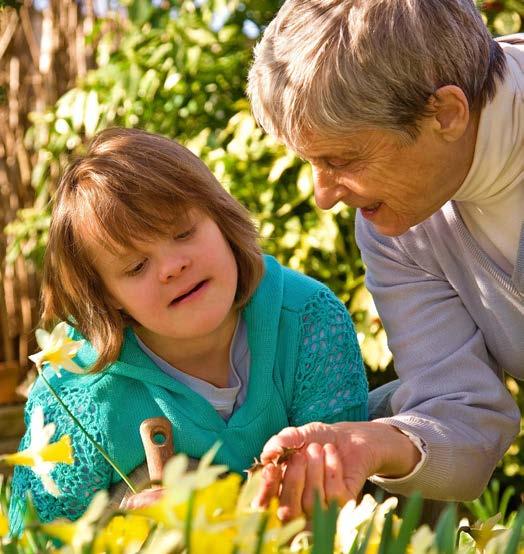
Fostering the Needs of the WHOLE CHILD
- Playground Considerations to Support Child Development
Innovating Evidence-Based Design of the WHOLE ENVIRONMENT
- 7 Principles of Inclusive Playground Design
- Principle 1: Be Fair
-Principle 2: Be Included
- Principle 3: Be Smart
- Principle 4: Be Independent
- Principle 5: Be Safe
- Principle 6: Be Active
- Principle 7: Be Comfortable
- Overview of Evidence-Based Design Best Practices
- 7 Principles of Inclusive Playground Design in Action
Celebrating Inclusion for the WHOLE COMMUNITY
- Language Matters
- Expanding Inclusion Across Park Settings for All Visitors
- Inclusive Play Programming
Projects of Excellence
- Inclusive Play Outcomes Demonstrate Impact
- National Demonstration Site Case Examples
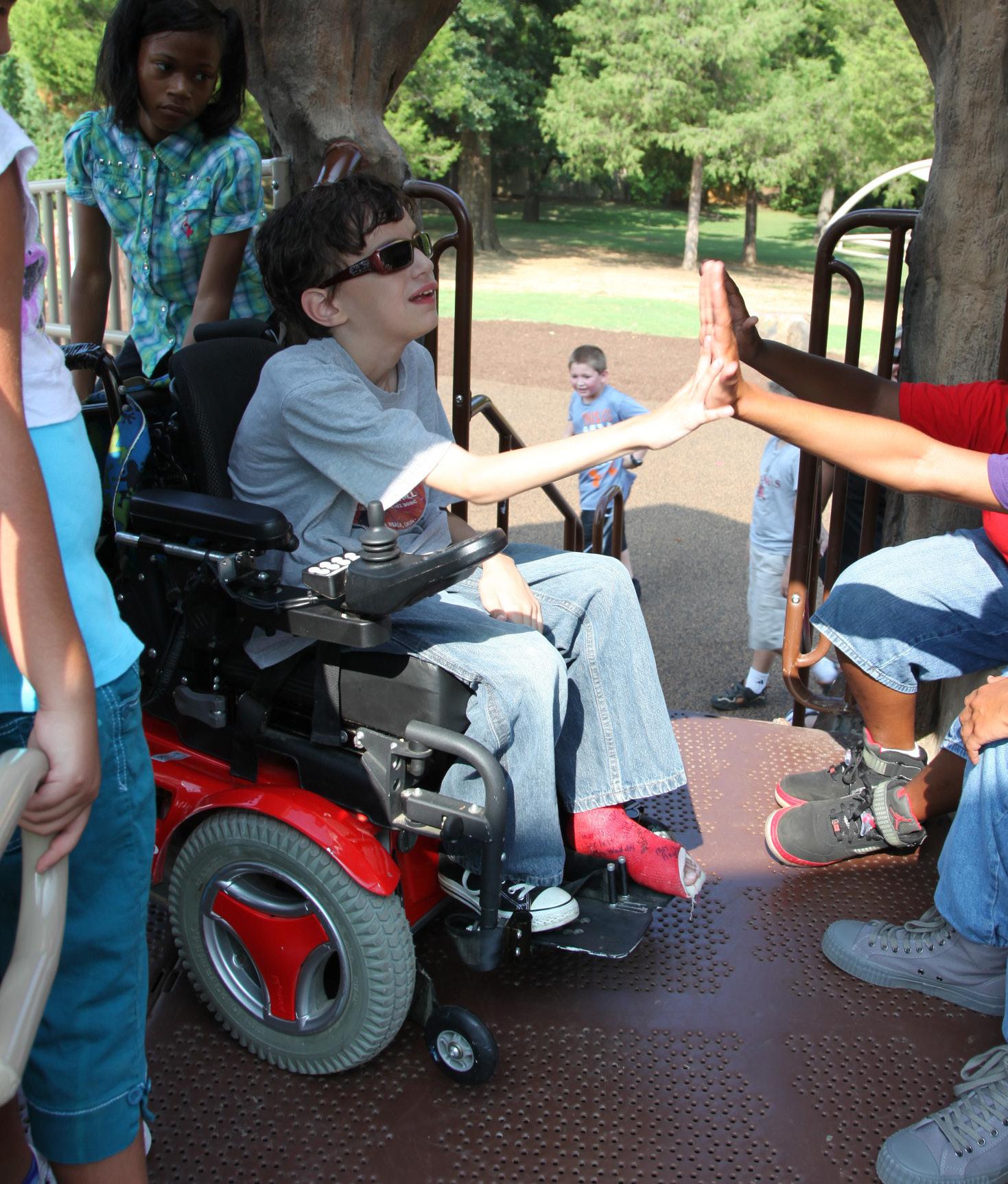

Who is being excluded? This is the question communities should consider when creating inclusive outdoor recreation experiences for everyone to participate in and enjoy. The process must start early in the planning, designing, and programming of these unique spaces. Kudos to communities that choose inclusion and make it top priority.”
- Bill Botten, Retired U.S. Access Board Inclusion Specialist
Executive Summary
Inclusion Matters. Whole communities start with inclusively designed whole environments that carefully meet the needs of the whole child. It is critical that play and recreation environments are intentional in meeting the diverse needs of communities. Active, independent play is essential for the health and wellbeing of every individual, regardless of age or ability. The developmental benefits of play are not limited solely to children but are important throughout one’s lifespan. As opportunities for play and recreation are often limited for people with disabilities, who are among the most vulnerable members of a community, inclusively designed play and recreation environments, programs, and services can serve as excellent catalysts for creating welcoming atmospheres and fostering a more profound sense of belonging. Now more than ever, professionals and advocates are seeking innovative ways to unite children, families, and community members through the power of play and recreation. Understanding and communicating the value, benefits, and positive community outcomes related to inclusive, intergenerational play is a crucial first step. This publication helps communities successfully advocate, champion, and fund inclusive play and recreation destinations that go beyond the minimum requirements for accessibility. By thoughtfully breaking down physical and social barriers, communities can provide high-quality play and recreation experiences, turn research into practice, and support positive community health outcomes.
A Unique and Comprehensive Inclusion Philosophy
As a comprehensive driver of overall community vitality, inclusive play is not solely about physically accessing an environment but is equally focused on the experiences once an individual gets there. Outdoor spaces should not only break down barriers to physical access but also intentionally break down barriers for individuals of all abilities to socially participate. Providing communities with inclusive destinations and opportunities to develop the skills to independently play and recreate together can be profound. Inclusive communities should feel and be welcoming, active, supportive, equitable, and diverse- creating more usable experiences for more people to the greatest extent possible.
Understanding the developmental needs of children and designing inclusive play environments to meet the 7 Principles of Inclusive Playground Design® is the first step in providing a successful foundation for inclusive play to occur. As the industry’s only evidence-based design best practices, the seven principles detailed within this guidebook provide a unique and comprehensive design philosophy for creating inclusive, intergenerational play environments in community parks and schools. Professionals and advocates have used this information for nearly twenty years to support their planning, development, and revitalization efforts.
Hundreds of outdoor play and recreation destinations have embraced the assortment of play activities that thoughtfully address the physical, social-emotional, sensory, cognitive, and communication needs of all children, including those with disabilities to promote whole environments that address the needs of the whole child and the whole community.
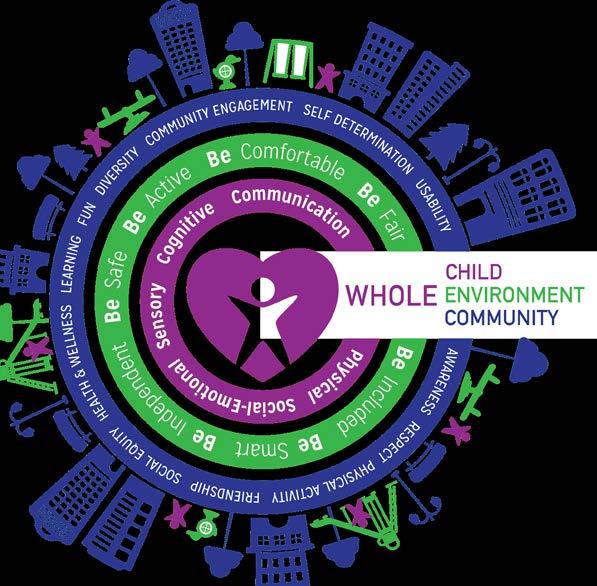
Fostering the Needs of the WHOLE CHILD
Creating genuinely inclusive and welcoming play experiences should start with an understanding and intentional design focusing on the developmental needs of the whole child. Research continues to demonstrate the importance of play across the interconnected domains of child development: physical, socialemotional, sensory, cognitive, and communication. Children, and indeed all individuals, regardless of age, need to be able to be active, exercise self-determination, engage in social interactions, learn and understand, and
experience an appropriate sensory environment to enhance their overall quality of life. Opportunities to be active in play, participate in community recreation, and create positive physical activity patterns continue to contribute to better health outcomes. Some of the many benefits of participating in play are higher self-esteem, positive self-identity, and emotional well-being, which have a lasting effect on an individual throughout their adult life. Play is the natural environment where social interactions occur, contributing to greater acceptance, the breaking down of barriers, and the fostering of friendships.
Innovating Evidence-Based WHOLE ENVIRONMENTS
Inclusively designed whole environments support child development and the unique context of the play environment. The 7 Principles of Inclusive Playground Design® have carefully tailored the original adult-focused Principles of Universal Design, created by the Center for Universal Design at North Carolina State University for indoor environments,1 to what children want to feel and experience during play in outdoor environments. While no two universally designed play destinations are alike, children wish for their play experiences to feel and to “Be” fair, included, smart, independent, safe, active, and comfortable during play. By aligning these evidence-based 7 Principles of Inclusive Playground Design and the specific guidelines and considerations offered in this guidebook to parks and playgrounds, communities can create whole environments that ensure the developmental needs of the whole child and support the active participation of people of all ages and abilities.
Celebrating Inclusion for the WHOLE COMMUNITY
Every community has a distinct personality shaped by the diverse individuals within it, and communities have meaningful opportunities to be enhanced and enriched by this diversity. Our unique backgrounds, abilities, and interests all contribute to the richness of whole communities.
To foster true community inclusion, all people, regardless of their abilities, should be able to participate and engage in a full range of community activities while enjoying feelings of affirmation, celebration, and appreciation. This extends to engagement in every phase of community asset development. If communities plan intentionally, engage diverse stakeholders, and build support for programming and infrastructure they have a deep and meaningful opportunity to build stronger communities that benefit their collective populations.
Advocacy and Companion Resources
Inclusive play is our passion and purpose. Together, we can effectively promote inclusive play and recreation as a pivotal solution to enrich and enhance the quality of life for children, families, and communities worldwide. Join us as we champion, investigate, learn, and collaborate for greater social equity. We invite you to join our mission to turn research into practice and build healthier, happier communities through inclusive play and recreation.
We hope you find this design resource and PlayCore’s companion inclusive play programming guide, 2 Play Together, helpful as you plan, develop, and champion inclusive play initiatives in your community.

Keith Christensen, RLA, Ph.D
Department of Landscape Architecture and Environmental Planning, Utah State Universeity Ph.D Disability Disciplines
“The 7 Principles of Inclusive Playground Design® were founded on the understanding that beyond disability, there are abilities; beyond accessibility, there is inclusion. We are proud of our ongoing partnership with PlayCore to promote inclusively designed play environments where people of all abilities discover unique opportunities to participate in meaningful outdoor experiences to secure the health benefits of physical activity, the developmental benefits of play, and the social benefits of inclusion.”
-Keith Christensen, RLA, Ph.D.
Inclusive Play Matters
Understanding the Disability Experience: Planning Inclusion for the WHOLE CHILD, WHOLE ENVIRONMENT, and WHOLE COMMUNITY
Disability is often understood as an individual’s complex interaction between features of a person’s body and features of the environment or society in which they live. Individuals may experience limitations caused by physical, intellectual, or other disabilities. This perspective, referred to as the medical model of disability, treats disability as an individual issue and places the responsibility on the person to either overcome or accept their difficult situations with the help of medical interventions or assistance from family and friends. It is a mistake to consider disability as a condition that an individual owns and makes them different.
We all have different abilities. Differences in ability are a natural part of the human experience that in no way diminishes an individual’s right to fully participate, including the fundamental right to play throughout our lives. What is not a natural part of the human experience are the barriers we create in built environments, such as parks and playgrounds. Part of designing the built environment is establishing the environmental demands or requirements for who belongs and who can participate in the activities that take place there. When we create places to play and recreate, we decide what individuals must be able to do in order to use the environment to support their active play and participation. Whenever the requirements or unnecessary demands of the environment are greater than the abilities of the user, a disability is created. This is an important perspective shift and mindset. Many individuals with disabilities reside within the built environment of communities, but due to the misalignment of the requirements to use the environment, they may often still not be or feel a part of their community (a social phenomenon); being “in the community, but not of it.”
Disability should not be seen as a condition an individual possesses, but the experience an individual has of being unable to participate, due to the unnecessary or unreasonable demands of the built environment.”
Meaningful outreach and education are required to involve the right people in planning and execution; creativity and innovation are required to ensure the space is universally designed and developmentally appropriate to the greatest extent possible; and most importantly, expertise is required to ensure that the direction, design, and execution result in the desired outcomes. Successful groups, working to achieve greater diversity and increase inclusion by eliminating unnecessary environmental requirements, understand Exclusion Segregation Integration Inclusion
that credible, validated, and scholarly research is required to identify barriers, create evidence-based recommendations, promote intentional approaches to design and measure outcomes and provide clear and measurable guidelines to promote equal opportunities. Implementation of effective practical measures that go beyond minimum accessibility and remove unnecessary barriers to participation to create inclusive, universally designed play and recreation spaces is critical to the health and wellness of communities. Access does not guarantee inclusion. It is simply an important first step that provides the foundation for inclusion to occur. Fundamentally, inclusively designed play environments are a statement about a community’s social values and every child’s right to play. Inclusively designed playgrounds are a microcosm of a community itself and can contribute to greater awareness, break down barriers, and foster friendships. Just like a playground, a supportive community that eliminates unnecessary requirements facilitates participation in everyday activities and relationships, provides opportunities for selfdetermination, and supports individuals to build social capital and a deeper sense of belonging. Whole environments support the needs of whole individuals and foster whole communities.
FUNCTION
A person’s abilities
Physical Psychological Social
Physical Psychological Social Disability Requirements to use the environment
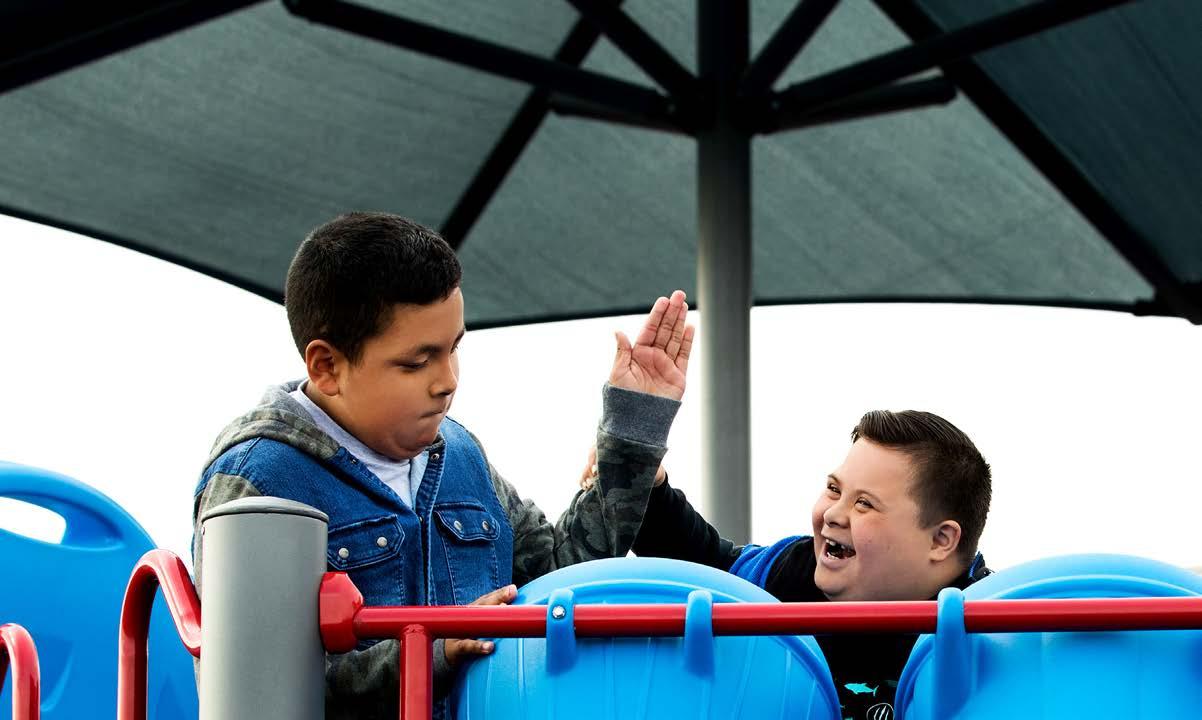
Thomas, C. (2004). How is disability understood? An examination of sociological approaches. Disability & society, 19(6), 569-583.
National Partnership for Inclusion & Research Lab
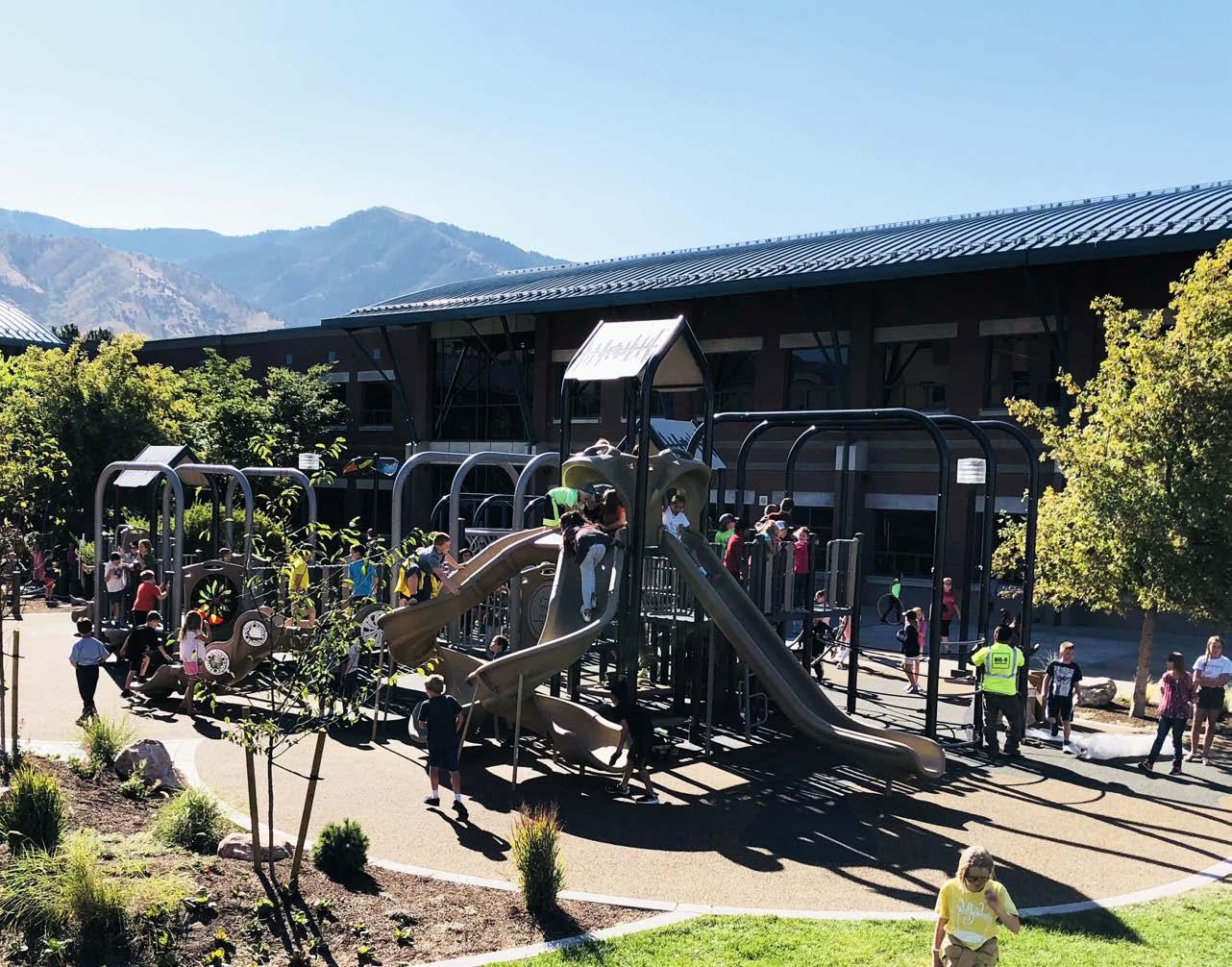
This guidebook and evidence-based design best practices are developed in partnership with Dr. Keith Christensen, RLA, Ph. D and Utah State University’s Institute for Disability Research, Policy, & Practice (IDRPP) to offer a comprehensive design program for creating play environments that celebrate abilities and address the physical and social inclusion of people of all ages and abilities.
The 7 Principles of Inclusive Playground Design® are uniquely positioned to provide specific guidelines for creating inclusive play environments, and while based on the original 7 Principles of Inclusive Design, created by NC State University’s Center for Universal Design, are the only evidence-based guidelines tailored specifically to address childhood recreation experiences on the playground. The IDRPP is a dynamic team working together to create

inclusive communities and improve the lives of children and adults with disabilities and their families through sustainable innovation, collaborative research, responsive service, and interdisciplinary training and education. Over their 50 years, the Institute has grown into one of the largest University Center for Excellence in Developmental Disabilities (UCEDD) programs in the nation and is recognized as a pioneer in research, training, technical assistance, and services for people with disabilities, their families, and the professionals who serve them.
The Edith Bowen Laboratory School, located on the campus of Utah State University, is a unit in the Emma Eccles Jones College of Education and Human Services along with the IDRPP. It has been anexemplary model of elementary school “best practice” for over a century. Their mission is to ensure high levels of learning for all students by providing a positive and engaging environment
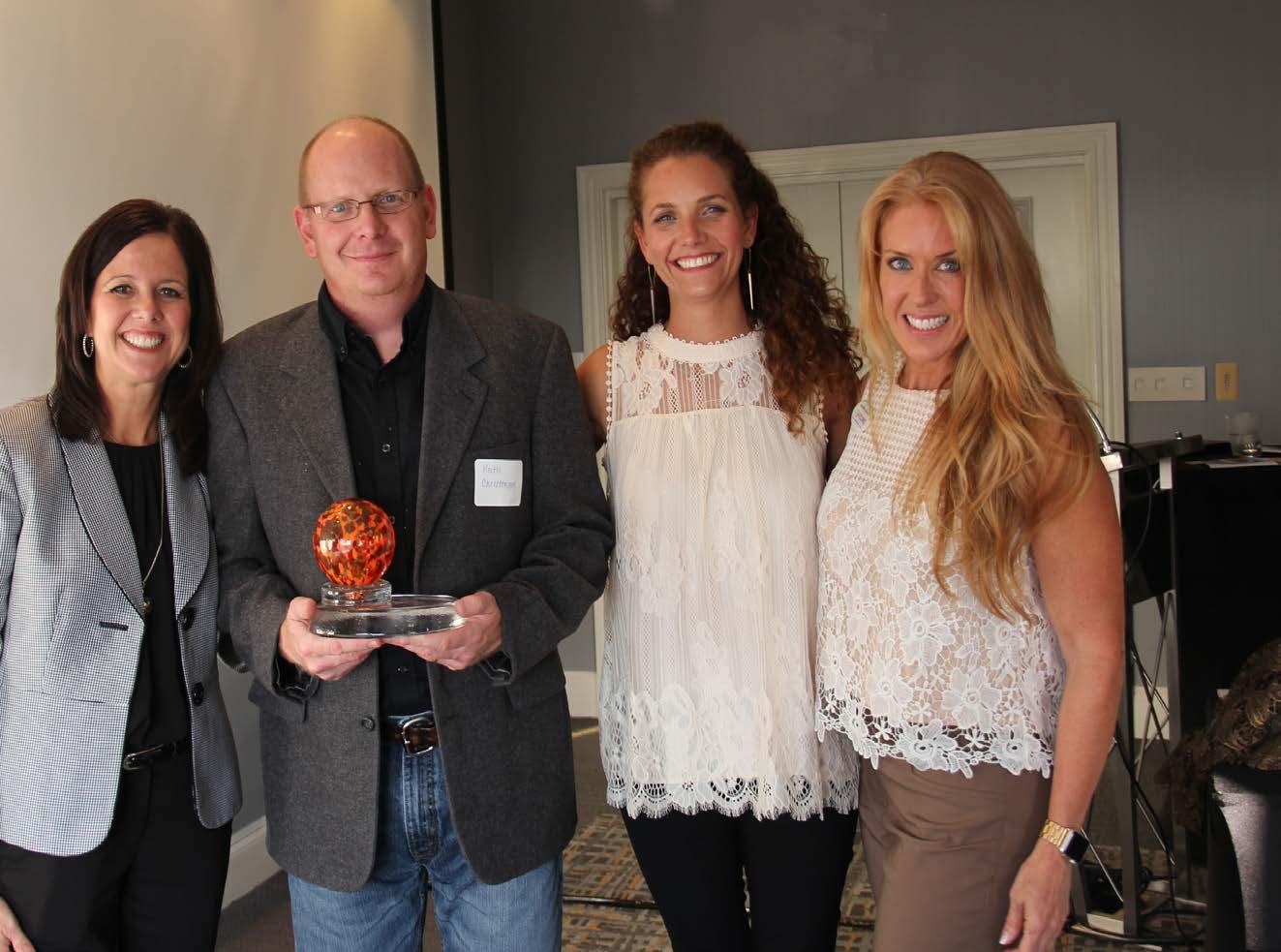

using effective evidence-based practice to mentor pre-service teachers and to review, conduct, implement, and disseminate educational research The K-5 public charter school is committed to providing opportunities for the whole child to explore connections between learning and the world around them to become capable, lifelong learners through developmentally appropriate education, applied research, and innovative educational practices.
PlayCore’s inclusive play environment at the school serves as a National Demonstration Site project of excellence that aligns with the 7 Principles of Inclusive Playground Design® and best practices for playground naturalization. It serves as a laboratory, supporting ongoing research to gain further knowledge and innovate best practices that support physical and social inclusion in outdoor environments.
For close to two decades, PlayCore has collaborated with Dr. Christensen to educate and arm planners, designers, and advocates with tools to create thousands of inclusive play and recreation destinations across the world. The partnership is fueled by our collective passion for true inclusion as we believe all people have a right to play alongside each other and that our purpose is to help ensure this mission is carried out.
PlayCore significantly contributes to ongoing research and learning with our partners at Utah State University to ensure that the best practices shared with the communities we serve are accurate, validated, and support community vitality. We invite you to share our passion and allow us the honor of serving your community, working together to create a place where everyone of all abilities can playto develop the whole child, the whole environment, and ultimately, the whole community.
Diversity,
Equity, Inclusion & Access in Outdoor Play and Recreation Environments
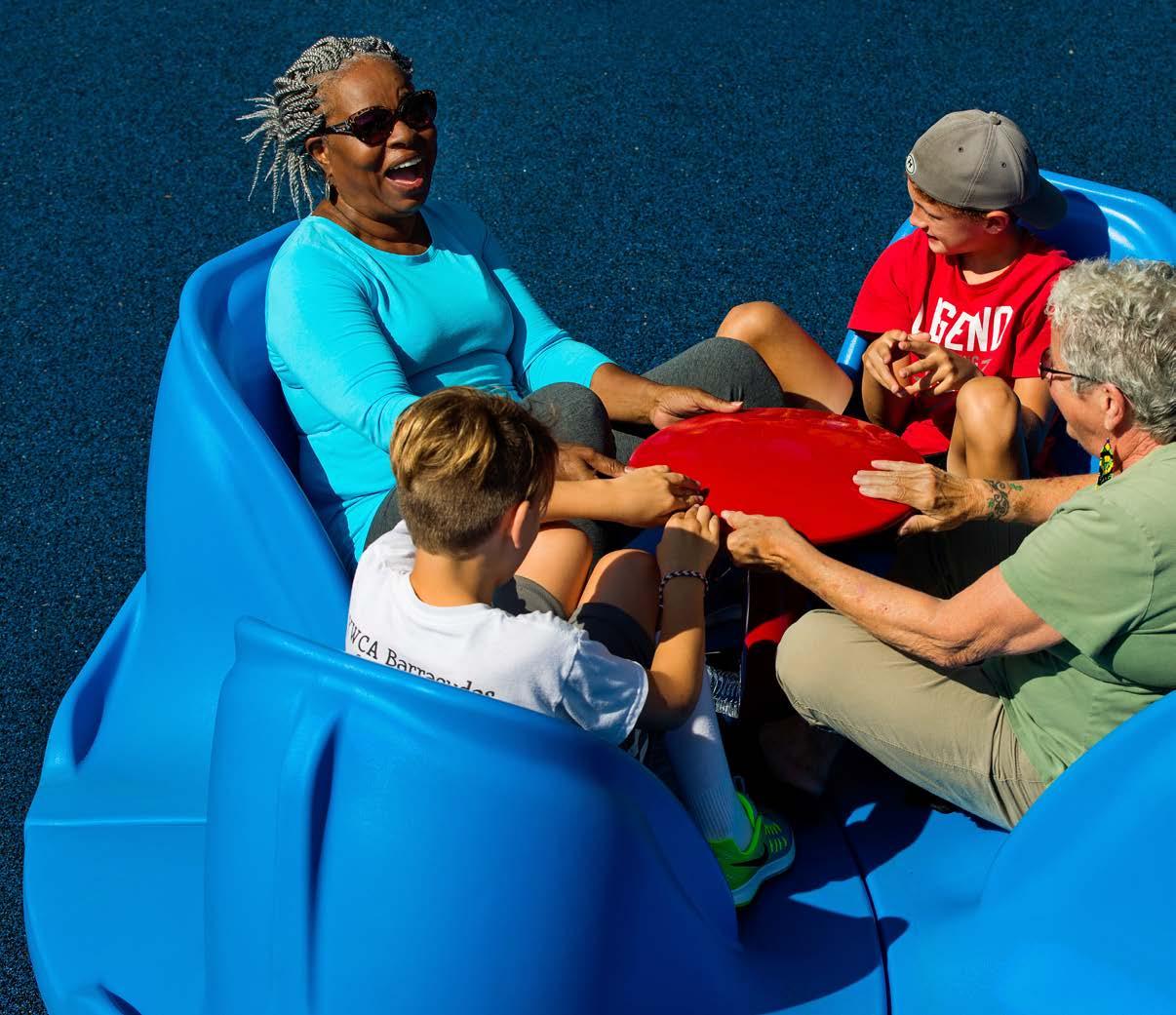
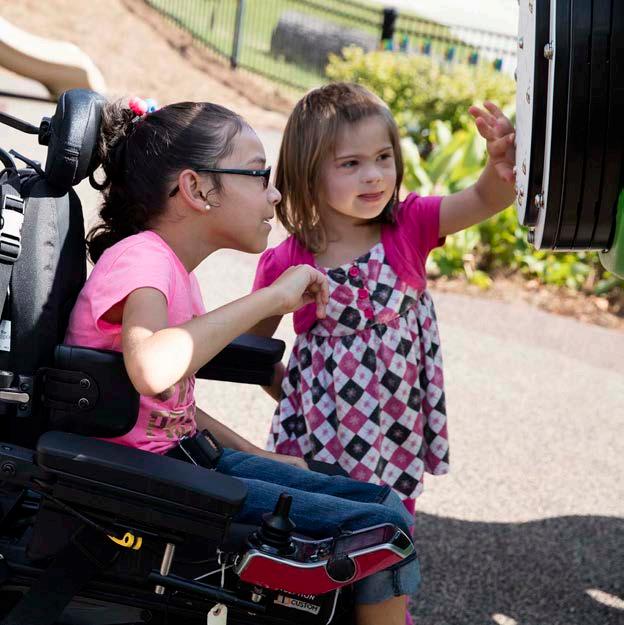
Addressing diversity, equity, inclusion, and access (DEIA) in outdoor play environments demonstrates how a community respects and values all inherent differences we possess as individuals. These differences might be obvious or invisible, slight or profound, and may include age, race, gender, ethnicity, sexual orientation, culture, socioeconomic status, ability, etc. The 7 Principles of Inclusive Playground Design® create universally designed play environments usable by more people, to the greatest extent possible, and therefore better serve a diverse community through outdoor play destinations where everyone feels and is welcome as a valued participant.
Children with and without disabilities will visit playgrounds with family members, caregivers, and friends. They visit the destination as a unique individual with their own lived experiences, interests, strengths, and challenges. Though every child is unique, all children intuitively want to play, make friends, and have fun. They should have the same opportunity to do so regardless of their attributes, differences, and similarities. Although children are typically the primary user group of playgrounds, truly inclusive environments embrace a broader intergenerational design approach. Inclusive play environments are for everyone, providing a place to play and recreate
with family, friends, and their fellow community members. Consider the various needs of park visitors, including adults or adolescents with disabilities, active aging adults, caregivers pushing strollers or with multiple children of different ages and abilities, the neurodiversity of visitors, and individuals with various adaptive equipment such as mobility devices, service animals, etc.
Ultimately, the whole environment should celebrate the diversity of the community. Welldesigned inclusive parks and playgrounds often become a primary attraction for all community members to enjoy, which contributes to a greater appreciation for diversity, social equity, inclusion, and access. Inclusive play and recreation increase healthy behaviors and sustained repeated social interactions that provide a catalyst for increasing civic engagement and cooperation between individuals, growing the social capital of a community. Programs, special events, community engagement, and marketing efforts that promote acceptance and understanding can create a deeper sense of a healthier place to live, work, and play and further increase the usage of community parks and playgrounds. We must collaborate and work together to promote an understanding that all children and families need and deserve access to quality inclusive recreation spaces for play.
Diversity: The attributes that contribute to people having unique life experiences, including but not limited to race, ethnicity, gender and gender identity, age, socioeconomic status, sexual orientation, abilities, educational background, religion, national origin, and political beliefs.
Social Equity: The fair and just access to the benefits of society. Social equity should promote fairness to access livelihood, education, recreation, and full participation in the political and cultural life of the community, as well as self-determination in meeting fundamental needs.
Inclusion: The act of supporting the diversity of people within a society, recognizing their value and importance, and helping them achieve their full potential, and includes the removal of barriers to social equity. Inclusion should not just provide accommodations to simply mitigate the obstacles.
Access: The process of taking action to make sure that individuals have what they need to participate in and be successful in an environment. Access doesn’t guarantee inclusion, but it is necessary for inclusion to occur. Accessibility is a consideration in designing products, services, or environments to be usable by people with disabilities. While access is important, participation and integration are the keys to meaningful experiences in an environment. In the case of play and recreation, this includes focusing on the right to fully participate and contribute to experiences within the environment, giving children and families with and without disabilities integrated play experiences that break down barriers, both physically and socially, and encourage them to embrace the benefits of playing together.
Since playgrounds are where children learn and develop core values that they’ll carry with them throughout life, the best playgrounds cater to “the whole child” addressing the development of physical, socialemotional, sensory, cognitive, and communication skills - for every child of every ability. Play and recreation spaces designed with this broader continuum have inclusion infused throughout the entire space, so children don’t have to disrupt their play just to figure out how to access or use elements within the design. We call this philosophy the 7 Principles of Inclusive Playground Design. It’s immersive, it’s backed by evidence-based research, and it’s used in thousands of playgrounds around the world.
Appreciating the Diverse Needs of Communities
Who are Children with Disabilities?
Out of 1,000 children between the ages of 3 and 21 receiving special education services, approximately 145 will have these disabilities
Sources: 1 U.S. Department of Education, Office of Special Education and Rehabilitative Services, Office of Special Education Programs, 43rd Annual Report to Congress on the Implementation of the Individuals with Disabilities Education Act, 2021, Washington, D.C. 2022.
2 Institute of Education Sciences, National Center for Education Statistics. https://nces.ed.gov/programs/digest/2020menu_tables.asp. Table 204.30 is found at https://nces.ed.gov/ programs/digest/d20/tables/dt20_204.30.asp.
3 American Community Survey (ACS) 5-Year Estimates Data 2020 S1810 Disability Characteristics from https://data.census.gov/cedsci/table?q=disability&tid=ACSST5Y2020.S1810
Who are People with Disabilities?
Speech
Other
Developmental
Intellectual
Emotional
Multiple
Disability Prevalence by Gender:
Disability Prevalence by Race:
Source: Erickson, W., Lee, C., von Schrader, S. (2016). Disability Statistics from the 2014 American Community Survey (ACS). Ithaca, NY: Cornell University Yang Tan Institute (YTI). Retrieved May 09, 2016 from www.disabilitystatistics.org
Examples of Disabilities
Physical4: Physical disability indicates any physical limitations or disabilities that inhibit the physical function of one or more limbs. Includes: Cerebral Palsy, Muscular Dystrophy, Spina Bifida, orthopedic impairments, spinal cord injury.
Sensory5: Sensory disability is a neurological disorder that affects the human brain to process sensory information. Includes: Blindness and limited vision, Deafness and loss of hearing, Sensory Processing Disorder.
Communicative6: A communication disability impacts the ability to receive, send, process, and comprehend concepts or verbal and/or nonverbal language systems. Includes: speech disabilities, stuttering, language disabilities, impaired voice or articulation.
Social/Emotional: Disabilities which impact a person’s ability to effectively recognize, interpret, control, and express fundamental emotions and relationships. Includes: Autism, Depression, Anxiety, Schizophrenia, emotional disabilities.
Intellectual: Intellectual disability is identified by disabilities in both intellectual and adaptive or executive functioning. Includes: Down Syndrome, Fragile X Syndrome, Traumatic Brain Injury, Fetal Alcohol Syndrome, Attention-Deficit Hyperactivity Disorder, general and specific learning disabilities, developmental delay.
Multiple: Represents an individual having two or more areas of significant disabilities across types of disabilities.
Health7: Other health conditions means having limited strength, vitality, or alertness, including a heightened alertness to environmental stimuli. Includes: asthma, allergies, diabetes, epilepsy, heart conditions, significant medical conditions such as cancer.
Neurodivergent: Is a term used to describe the idea that people experience and interact with the world in many different ways; thinking, learning, and behaving differently. Often used in the context of Autism Spectrum Disorder, neurodivergent has come to represent many differences in brain function such as ADHD, Dyslexia, learning disabilities, PTSD, intellectual disabilities, etc.
4 https://kines.rutgers.edu/dshw/disabilities/physical/1060-physical-disabilities
5 https://kines.rutgers.edu/dshw/disabilities/sensory/1061-sensory-disabilities
6 https://sites.ed.gov/idea/regs/b/a/300.8/c/11
7 https://sites.ed.gov/idea/regs/b/a/300.8/c
Disability Definitions
Children 3-21 years: IDEA lists 13 different disability categories under which 3-21 year olds may be eligible for services. These categories are autism; deaf-blindness; deafness; emotional disturbance; hearing impairment; intellectual disability; multiple disabilities; orthopedic impairment; other health impairment; specific learning disability; speech or language impairment; traumatic brain injury; or visual impairment (including blindness). The definition for each also requires that the impairment “adversely affects educational performance”. Therefore, an individual with an orthopedic impairment that requires the use of a wheelchair but has no impact on their educational performance is not defined as a child with a disability under IDEA.
Adults 18+ years: The American Community Survey (ACS) definition of disability is based on six questions.
1. Hearing Disability: Is this person deaf or does he/ she have serious difficulty hearing?
2. Vision Disability: Is this person blind or does he/she have serious difficulty seeing even when wearing glasses?
3. Cognitive Disability: Because of a physical, mental, or emotional condition, does this person have serious difficulty concentrating, remembering, or making decisions?
Disability Anthropometrics
4. Ambulatory Disability: Does this person have serious difficulty walking or climbing stairs?
5. Self-care Disability: Does this person have difficulty dressing or bathing?
6. Independent Living Disability: Because of a physical, mental, or emotional condition, does this person have difficulty doing errands alone such as visiting a doctor’s office or shopping?
A considerable amount of research on the size, shape, stature, and functional capabilities of people with and without disabilities has taken place over the last two decades. Anthropometrics should be carefully considered when planning and designing outdoor play and recreation environments to consider the unique needs of individuals and the functionality of the built environment, equipment, and park amenities.
Source: Kristensen, S., & Bradtmiller, B. Anthropometry for persons with disabilities. Accessed September 22, 2016, from United States Access Board, https://www.access-board.gov/229-research/human-measures-mobility-aids/anthropometry-for-persons-with-disabilities
A History of Inclusive Playgrounds
Play has always been a fundamental part of child development. Play is inherent in all cultures, and while there are many versions of when the first “playground” was built, it is irrefutable that the idea of inclusion took many decades more to take root. Prior to 1990, while playground aesthetics continued to evolve, little consideration was given to children and adults of different abilities having access, let alone successfully using and integrating into a playground environment, and people with disabilities were often excluded from play and recreation.
Clarifying Design Terminology
7 Principles of Inclusive
A design process in which the needs of people with disabilities are considered. Accessible is defined as a site, building, facility or part thereof that complies with the standard.
gain access to recreation facilities including play areas. The Access Board issued supplemental guidelines for the ADA for play areas in 2000 and recreation facilities in 2002. The Board’s guidelines were adopted by the Department of Justice in 2010 and became the enforceable standard, the 2010 ADA Standards for Accessible Design, for all new construction and alterations after March 2012. ADA-compliant play areas meet minimum design criteria that ensures they are accessible via ramps or transfer systems, located along accessible routes of travel, and include a variety of accessible play options. A key component of every accessible play area is an accessible surface connecting each ground level and elevated play component. Additionally, accessibility standards address the connection of accessible routes to all required elements, spaces, and facilities on the site including play areas, site arrival points, parking, toilet rooms, and recreation facilities. Accessible routes have technical requirements for firmness and stability as well as minimum width, running slope, and cross slope. While the required minimums provide physical access to a minimum number of play components this access does not guarantee social inclusion by children and adults with varied abilities, which results in lost opportunities for equitable participation.
Recognizes everyone’s right to fully participate and contribute to meaning play experiences.
- Various Sources
The needs of people with disabilities are considered. A site, building, facility or part thereof that complies with the standard.
- Americans with Disabilities Act, 1990
- PlayCore and Utah State University, 2008
The design of products and environments are usable by all people, to the greatest extent possible, without the need for adaptation or specialized design.
- Ron Mace, 1988
Becoming Accessible
In 1990, the Americans with Disabilities Act (ADA) became law, prohibiting discrimination against individuals with disabilities in all areas of public life including jobs, schools, transportation, and in all spaces open to the general public, including play and recreation environments. After the ADA was passed, the U.S. Access Board was tasked with the responsibility of creating ‘minimum’ accessibility guidelines so that people with disabilities could
The minimums created in these standards were never intended to be maximum. The intention was to create a ‘foundation’ that would provide the opportunity for people with disabilities to gain access, and for designers to begin to develop and produce the diverse ways that inclusive play and recreational opportunities can ensure participation by all people.
In 2001, the Center for Persons with Disabilities at Utah State University began the Beyond Access program to elevate understanding of the importance of inclusion within the social environment of playgrounds. In 2006 and 2007, work to promote accessible playgrounds also began to build in Canada, when the Canadian Standards Association was in the process of updating their Z614-Children’s Playspace and Equipment Standard and had formed a subcommittee to look at accessibility. The work of this sub-committee resulted in the establishment of Annex H, Children’s Playspaces and Equipment that are Accessible to Persons with Disabilities. Annex H, a supplement to the main Standard document, outlines a minimum requirement for developing play spaces that are accessible for children with disabilities. Additionally, in Ontario, the most comprehensive accessibility law in Canada was enacted.2 It was modeled after the Americans with Disabilities Act and has the goal of making the province fully accessible by 2025. In 2012, Part IV.1— Design of Public Spaces Standards (Accessibility Standards for the Built Environment) was introduced to the AODA, which outlines the application, consultation, and design requirements for ‘outdoor play spaces’. In 2016, compliance with this standard was required for the public sector and
Playground Design®
‘large’ private organizations (50+ employees) that are undertaking substantial renovations or construction of a new play space.
During ensuing years, a variety of accessible play areas were built across North America and while standards provided guidelines, usability, and meaningful experiences were often dependent on designers’ ability to interpret and execute, and additional terms were coined to describe design philosophies.
Universal Design
Universal design is a concept most often associated with the Center for Universal Design (CUD), a global movement of inclusive design practice initiated at NC State University College of Design. The CUD was established in 1989 and they developed the Seven Principles of Universal Design so that “the design of products and environments are usable by all people, to the greatest extent possible, without the need for adaptation or specialized design.” While this definition has been used as a framework for designing many types of spaces, the initial idea referred to architecture and interior design.3
One study conducted at Kids Together Playground in Cary, North Carolina, which contained several play areas, found that two-fifths of the total park use occurred on the universally designed play structure. It also received the highest attractiveness score due to having more behavior settings and accessible routes of travel connected to two ramped entryways to the play structure from the primary pathway. The playground structures that met minimum accessibility standards scored considerably lower. The universally designed playground was found to have greater potential to attract a broader range of users of various abilities and skill levels. The design created easy circulation as users moved around the space, and it offered social gathering areas and vantage points for caregivers to supervise children.
Inclusive Design
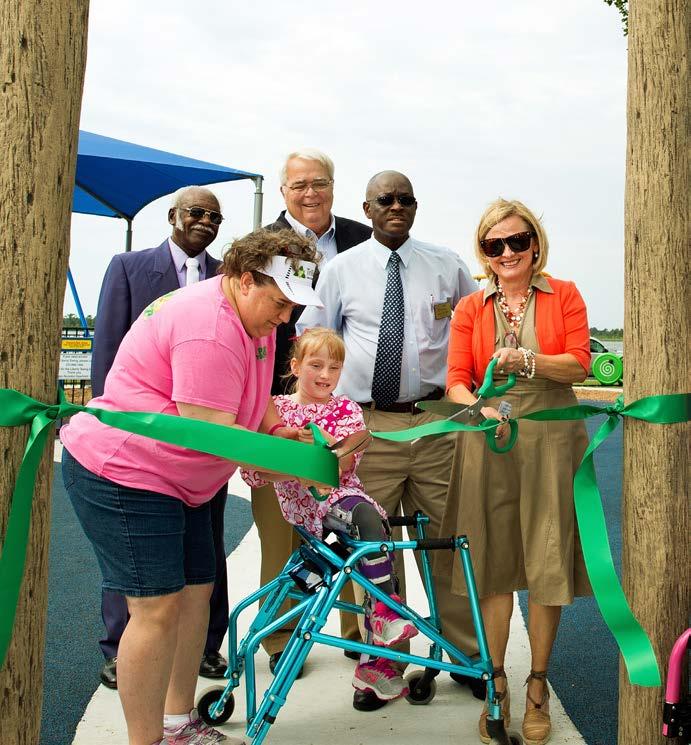
7 Principles of Inclusive Playground Design®
In 2008 PlayCore, working with Utah State’s Institute for Disabilty Research, formerly known as the Center for Persons with Disabilities, developed the 7 Principles of Inclusive Playground Design, elevating the understanding of, and expectations for playgrounds where children with disabilities may fully and independently participate in play.
The 7 Principles are the only evidence-based design principles for play areas and intentionally provide strategies that help remove ambiguity and interpretation from design. They’re based on the idea that disability is a natural part of the human experience, and the inability to experience the play environment is not caused by disability, but by an environment that has not been properly designed and therefore excludes individuals from participating fully.
While the term inclusive design is often used interchangeably with universal design, inclusive spaces offer a broader look at disability, focusing on everyone’s right to fully participate and contribute to meaningful play experiences. While inclusive playground design expands the concept of integrated play, it is inherently dependent on the knowledge of the designer to interpret and construct a space in a cohesive and meaningful way that promotes participation by all. Additionally, it’s important to note that in recent years the term inclusion has been more broadly applied to consider diverse individual attributes in addition to disability, including age, gender, faith, race, socioeconomic status, and more.
In 2014, PlayCore launched the National Demonstration Site program for Inclusion, providing recognition for turning research into practice and data storytelling reports for communities that follow the 7 Principles of Inclusive Playground Design. The design criteria have been widely adopted across the U.S. and Canada, contributing significantly to children and families with disabilities’ opportunities to fully participate in play. Through the program, ongoing research continues to inform innovations for highquality inclusive play spaces that have measurable outcomes and positively impact children, families, and communities.
Fostering the Needs of the WHOLE CHILD
Playground Considerations to Support Child Development
Offer a developmentally robust and balanced assortment of playground activities that meet the diverse physical, social-emotional, sensory, cognitive, and communicative needs of all children, including those with disabilities.
Playgrounds are important community assets where the developmental needs of all children, including those with disabilities, can be secured by intentionally providing opportunities for the physical, social-emotional, sensory, cognitive, and communicative benefits of play. Children with disabilities should be able to explore the whole environment and interact with a robust assortment of playground activities and with their peers to foster and support the needs of the whole child. Investing in inclusive play for children with disabilities offers significant benefits to all children and the whole community.
Truly inclusive play opportunities require planners, designers, and other advocates to thoughtfully support peer-to-peer interactions between children with and without disabilities to develop social learning, problem-solving, social exchanges, cooperation, turn-taking, roles, and the empathy necessary for social and emotional development. The coordination of joint activity, which occurs across the social environment of play, is critical to cognitive development and understanding of cause and effect. The physical development
PHYSICAL DOMAIN
of children is best supported by movement in the context of behavior where children can take healthy risks, develop skills through graduated levels of challenge, and gain mastery through repetitive movement. Positive sensory development requires children to learn how to regulate their sensory input within an environment. Communication development occurs when children can independently model social interactions and effectively communicate with their peers.
Researchers, educators, and early childhood professionals have emphasized the interrelatedness and interdependence of developmental domains and processes. For example, a child’s ability to comprehend language is highly dependent on their cognitive function and capabilities. The developmental domains are linked not only with one another, but also with factors such as culture, social relationships, experience, physical health, mental health, and brain functioning.4 Therefore, the process of creating truly inclusive and embracing play experiences should start with an appreciation and understanding of the five domains of child development.
The physical domain involves biological and physical development, which includes both gross motor and fine motor skills, and addresses growth and physical activity. Motor skills allow children to make purposeful movements and learn the physical characteristics of self and the environment. Further, the motor behaviors involved in active outdoor play with other children are critical to the development of social skills and an understanding of social rules.
Gross motor development involves large muscle groups, such as those in the trunk and legs. Gross motor skills are used in walking, climbing, jumping, etc., and give way to more complex movements that promote physical activity such as biking, dancing, swinging, etc.
Fine motor development involves small muscle groups, such as those found in the fingers and tongue. Fine motor skills are used to grasp and manipulate objects and are critical to developing hand-eye coordination and speech.
Activities to Support the Physical Needs of Children
Movement: Play activities that involve motor planning such as climbing, running, jumping, hopping, and sliding help children develop core strength and coordination skills, while helping regulate their nervous system.
Motion: The rhythmic, slow, full-body motion activities, such as swinging, can have a calming effect. This type of vestibular stimulation is much more accessible to children who are hypersensitive to movement, while simultaneously decreasing hyper-reactive responses to sensory input. In addition, swinging
Inclusive Playground Considerations:
While the specific cause-andeffect relationship between specific disabilities and physical capabilities is multifaceted and nuanced, difficulty with motor skills and coordination in children is often associated with physical disabilities such as cerebral palsy, muscular dystrophy, spina bifida, or other physical disabilities that may have occurred through an injury or health condition. Physical disabilities can also be associated with speech or language disabilities, autism spectrum disorders, and other similar social-emotional and cognitive disabilities. Although play is an important part of motor development, children with motor challenges, and their caregivers, may face specific barriers to engaging in play regularly.5 The following considerations may be helpful in outdoor play environments to support the development of motor skills and coordination.
helps develop sequencing and motor coordination skills development. See-saws, and other rocking activities, provide opportunities to access similar vestibular stimulation, while also requiring cooperation with another child, increasing opportunities for social interaction. Select equipment that offers inclusive features such as molded harnesses, high backs, and handholds.
Manipulative Activities and Loose Parts:
Loose parts or manipulative play panels or activities support fine motor skill development through unstructured play which influences children to experience new sensory stimuli and learn to respond appropriately. Manipulatives also facilitate independent and social play through creative and imaginative play.
Accessible Surfacing:
Surfacing appropriate to the reasonable ambulatory skills of the child prevents gross motor barriers to play participation. Playground designs should be particularly mindful of how surfacing allows for connecting playground activities and spaces. Barriers related to surfacing are not specific to children using mobility or ambulatory devices, such as wheelchairs or crutches, but may impact children with reduced balance, who have vision disabilities, or who lack fine motor skills needed for communication.
SOCIAL-EMOTIONAL DOMAIN
The social-emotional domain includes the child’s experience, expression, and management of emotions, and the ability to establish positive relationships with others.6 It encompasses both intra- and interpersonal processes such as social interaction, cooperation, self-confidence, and community roles. Emotional development includes the ability to identify and understand one’s feelings, to accurately read and comprehend emotional states in others, to constructively manage strong emotions, to regulate one’s behavior, to develop empathy for others, and to establish and maintain relationships.7 Thoughtfully support the development of the following social-emotional skills in outdoor play environments to promote social inclusion and address the diverse emotional needs of all children.
Social interaction during play opportunities allows children to practice responsible decision-making, make constructive and respectful choices about personal behavior and the realistic evaluation of consequences of various actions, and develop wellbeing regarding self and others.
Cooperation supports the development of relationship skills such as communicating clearly, listening actively, negotiating conflict constructively, and seeking and offering help when needed. Cooperative play experiences, rather than competitive activities, offer extremely positive experiences for children with disabilities to interact at similar participation levels as their peers. Self-confidence is promoted when children learn to regulate their emotions, thoughts, and behaviors effectively in different situations through self-management skills. This includes managing stress, controlling impulses, motivating oneself, and setting and working toward achieving personal and academic goals. By accurately recognizing one’s emotions, thoughts,
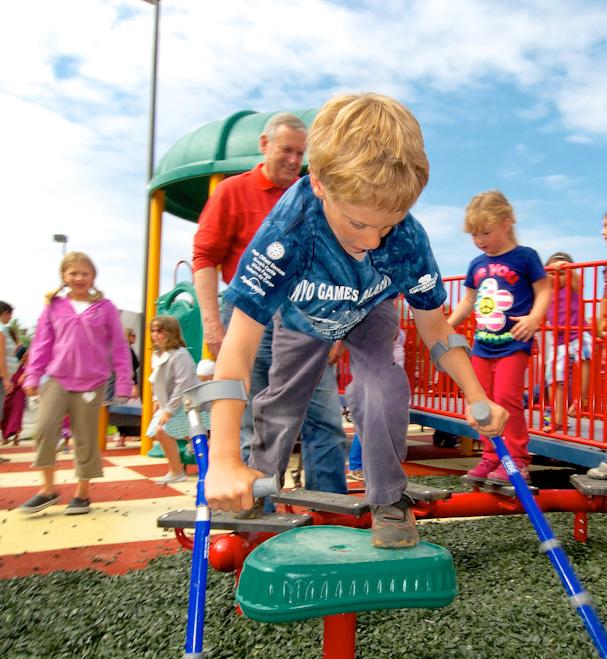
Inclusive Playground Considerations:
Spontaneous, creative play, is vital for social and emotional skill development in children. Children withcognitive, communication, and particularly social-emotional disabilities such as autism may have difficulty initiating and sustaining pretend play because of difficulties in the generation of play ideas and communicating the imagined pretense to peers.14 Integrating the following considerations throughout outdoor play environments can facilitate imaginative and cooperative play to intentionally support social-emotional development.
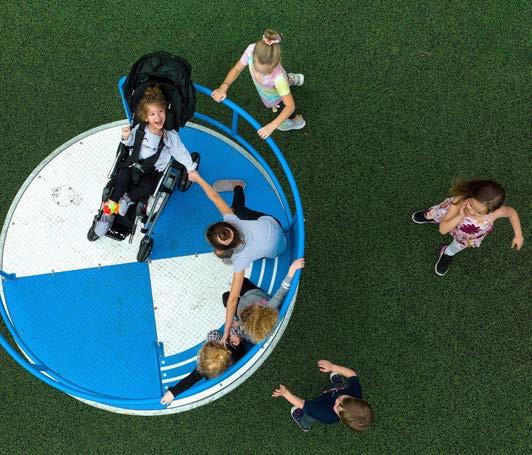

and their influence on behavior, children develop self-awareness and the ability to assess their strengths, limitations, and sense of confidence and optimism.
Community roles and a sense of community occur when children develop an understanding of themselves and others in their social environment or network and gain an understanding of their roles within their families and communities. Inclusive play environments can be a catalyst for creating social awareness, helping others gain perspective of and empathize with others from diverse backgrounds and cultures, and understanding social and ethical norms for behavior. This sense of belonging and social inclusion often leads to recognition of family, school, and community resources, additional support, and even new opportunities to create connections and meaningful relationships. Inclusive playgrounds can be catalysts for supporting social-emotional development and can teach children of all abilities strategies to successfully play together, even if there are differences in how they engage or communicate. Children with and without disabilities should have a variety of opportunities to support their socialemotional well-being through self-awareness, selfmanagement, social awareness, relationship skills, and responsible decision-making.
Self-awareness is the ability to accurately recognize one’s emotions and thoughts and their influence on behavior. By understanding themselves and others, children gain an understanding of their roles within their families and communities and develop confidence.
Self-management is the ability to regulate one’s emotions, thoughts, and behaviors effectively in different situations. This includes managing stress, controlling impulses, motivating oneself, and setting and working toward achieving personal and academic goals.
Social awareness is the ability to take the perspective of and empathize with others from diverse backgrounds and cultures, and to understand social and ethical norms for behavior.
Relationship skills are important to establish and maintain healthy relationships with a variety of individuals and groups. These include communicating clearly, listening actively, cooperating, resisting inappropriate social pressure, negotiating conflict constructively, and seeking and offering help when needed.
Responsible decision-making includes the ability to make constructive and respectful choices about personal behavior based on consideration of ethical standards, safety concerns, social norms, the realistic evaluation of consequences of various
actions, and the well-being of self and others. Activities to Support the
Social-Emotional Needs of Children
Defined Areas for Socialization: Children with disabilities, in particular those with autism spectrum disorders, often have difficulty understanding physical space communication.8 Areas, where socialization is expected, should be designed to bring children together in cooperative types of activities with clearly defined space for each participant. Clear physical and visual boundaries, as well as play cues, can help reduce distress caused by social interaction in children with disabilities.9
Play Cues: The lack of play signals is one of the major inhibitors of social interaction in children with disabilities.10 The design of the outdoor play environments may provide these play cues, as prompts to engage in appropriate play. Gentle themes that are not overly prescriptive are ideal to provide children with cues, while not limiting their creative play. However, abstraction in outdoor play environment design is not beneficial due to the unclear play cues which may be confusing.
Music: Musical components provide developmentally appropriate activities that can reduce self-stimulation, and encourage selfexpression in children with disabilities.11 Reducing self-stimulation increases spontaneous play among children with disabilities.12 A group of musical instruments becomes a place in which children of all abilities can participate without expected outcomes, which can reduce anxiety and frustration in children with disabilities.
Social Side-by-Side Play: Activities and areas intentionally designed for multiple users support social-emotional development. Activities that require more than one person to operate or that are more enjoyable when children work together to make an action happen encourage cooperative play, rather than creating competition.
Large Elevated Platforms: Play platforms support more complex, social play activities when they are elevated, and the incidence of complex, social play increases with elevation. As a result, elevated play platforms need to be physically accessible to be inclusive.
Social Respite Settings: Passive, cozy spaces, in addition to facilitating sensory relief, are important for social relief where children can pace, relax, and regulate their social interactions.
Play Circuits: A circular design or layout with a central open area and with functionally linked or connecting activities promotes social engagement because of the structural boundary that encourages continued social participation.13
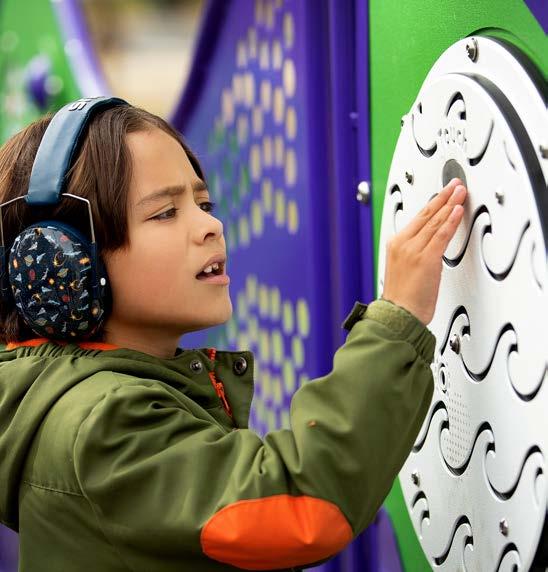
SENSORY DOMAIN
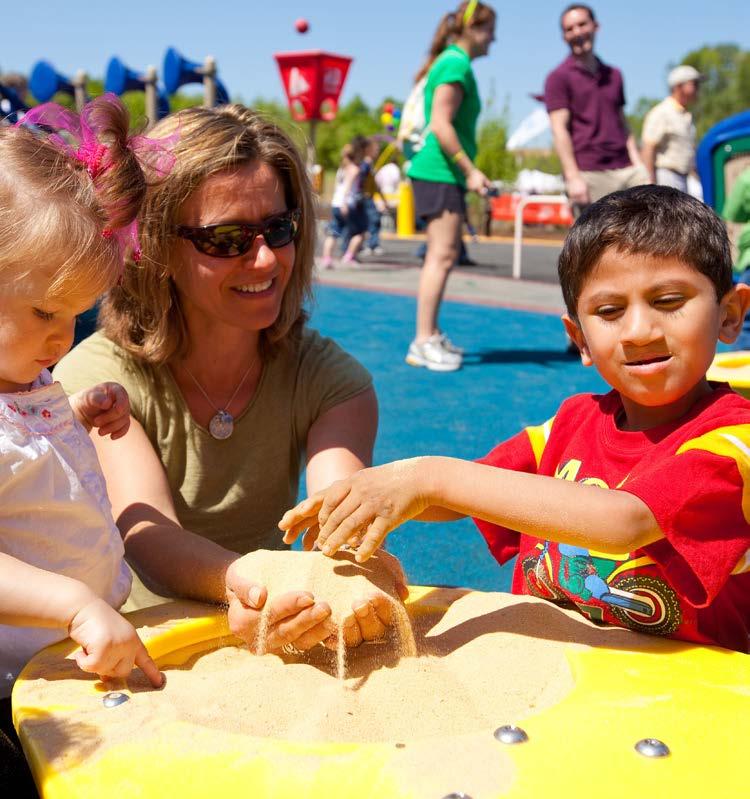
The sensory domain includes the seven senses of sight, touch, smell, hearing, taste, vestibular, and proprioception. Although they are often thought of as separate categories, the senses are an integrated system that overlap and sometimes conflict with each other.15 The ability to recognize and interpret sensory stimuli serves as the basis for understanding, learning, and knowing a particular action or reaction. This in turn plays a major role in the physical, social-emotional, communication, and cognitive development of a child. Sensory-rich outdoor play environments that address the seven senses as an integrated system into the whole environment can effectively provide opportunities for children to seek sensory relief or input.
Sight is the ability to interpret the surrounding environment by the perception of visible light. Vision is not simply a translation of retinal stimuli. It requires visual processing within the visual cortex of the brain, which includes discrimination, sequencing, memory, spatial, and closure. For example, dyslexia is a visual processing impairment.
Smell is the perception of odor through chemical responses to substances through the olfactory system. Smell is considered a ‘near’ sense and an external sense. Child-friendly, nonpoisonous plants can bring interesting and new smells to outdoor environments. Some scents are known to be calming and can be used to support spaces for sensory and social respite. Touch responds to changes to the surface or internal state of the body. The two components of the tactile system are discriminative and non-discriminative (or protective). Discriminative touch allows
Inclusive Playground Considerations:
In addition to children with sensory disabilities, sensory processing disorders are relatively common among individuals with disabilities in general.19 Children with disabilities present varying responses to sensory stimuli, including heightened sensitivity, sensation avoidance, sensation seeking, and poor registration. Inclusive play environments that consider the integration of the seven senses can positively influence the development of the whole child. The following considerations can be instrumental in outdoor play environments to ensure that children can experience multisensory experiences that integrate various sensory stimuli.

individuals to sense and localize touch. Nondiscriminative, or protective, touch does not allow a person to localize where they were touched. The areas of sensitivity are pressure, vibration, temperature, pain, and movement.
Hearing is the perception of sound by detecting vibration. Elements of sound include pitch, tone, volume, frequency, intensity, and hearing acuity.
Taste responds chemically to substances. The five qualities of the gustatory system are sourness, bitterness, sweetness, saltiness, and umami (savory).
Vestibular sensory receptors are located within the inner ear and indicate to the child where the head and body are in relation to the earth, including movement, speed, and direction. Vestibular input is important for developing balance, posture, and sense of gravity. Eye movement is monitored through vestibular feedback and affects reading and language development.16
Proprioception sensory receptors are located within the muscles, joints, and connective tissue throughout the body and communicate body awareness to the child while assisting in motor control and planning.17 When proprioception is functioning properly the position of the body can be adjusted in various situations and the child understands how much force is needed to participate in an activity. Speech production is monitored through proprioceptive feedback.18
Activities to Support the Sensory Needs of Children
Structure: Children with disabilities benefit from structured environments.20 Structure helps emphasize where and how activities are to take place, thereby contributing to reduced stress, anxiety, and behavioral problems in children with disabilities by making things predictable.21
Visual Boundaries: Clear physical and visual boundaries, such as fences, paths, and changes in surface texture or color, can help children with disabilities to understand where each area of the play environment begins and ends,22 in essence increasing the recognizable structure of the play environment. Clear boundaries may assist children with autism in understanding the social boundaries of play within the area when the two are designed to correspond.
Sensory Stimuli: Children benefit from strong multisensory landmarks and activities that will attract the shared attention of all children. To engage the senses, sensory cues need to be organized to reduce overstimulation of the child. This can be achieved by clear boundaries and consistent patterns of color, tone, texture, and
sound that help define specific areas where activities are to occur. Within these areas of sensory consistency, a multisensory landmark may be used to focus shared attention between children with and without disabilities. Opportunities to pace and regulate sensory stimulation should be available within the play environment, preferably located near or adjacent to active areas. These spaces may be child-scaled and partially enclosed.
Sand Play: Sand play, when combined with loose parts to support symbolic play, provides multilayered support for sensory play including social expression. For children with disabilities, the evidence suggests that sand play opportunities provide enough structure to support the development of socialization skills.23
Feedback: Immediate feedback response from actions reinforces appropriate behaviors through sensory stimuli. For example, the positive vestibular stimuli from swinging reinforces the behavior of swinging. Auditory feedback from musical instruments or steering wheels that respond to movement by making noise or vibrating provides similar positive reinforcement.
Color: Solid, bright colors reflect light making them easier to be perceived by individuals with vision disabilities. Individuals who have low vision can benefit from contrasting colors. A dark ground plane with consistent light/contrasting borders indicated can be useful for delineating play settings or changes in height on a structure. In addition, research on color psychology has documented the profound impact of color on children’s mental and behavioral reactions, which suggests that care should be taken to select palettes that are likely to evoke emotions appropriate for the spaces’ intended purpose.24
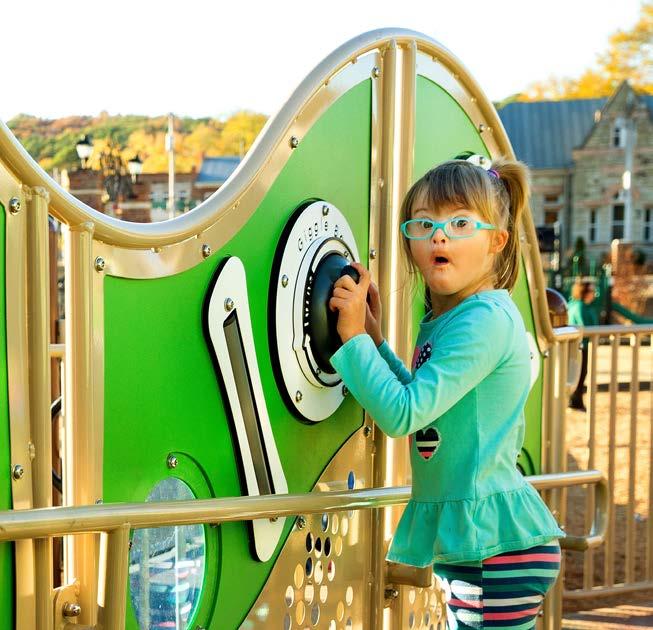
COGNITIVE DOMAIN
Cognitive development refers to the progressive and continuous growth of perception, memory, imagination, conception, judgment, and reason 25 Cognition also involves the mental activities of comprehending information and the processes of acquiring, organizing, remembering, and using knowledge 26 This knowledge is subsequently used for problem-solving and generalization to novel situations.27 Key areas of cognitive development include recent memory, executive functioning such as organization skills, problem-solving, and abstract thinking; understanding concepts such as cause-and-effect, and learning
Memory is the ability to learn and recall recent information.
Executive functioning is the ability to plan and organize, perform abstract reasoning and generalization strategies to adapt and be flexible to concepts, and solve problems by finding solutions to difficult situations or through critical thinking. It also addresses an individual’s ability to focus despite distractions and to shift focus when appropriate.
Cause-and-effect is the understanding that one can create an action or do something that makes something happen, a fundamental skill to understanding one’s ability to notice the effects of others on the environment or the relationship between events.
Imagination and pretend play develop complex social and advanced thinking and communication skills.
Learning occurs through exploration and hands-on experiences. Outdoor environments can provide ideal and unique opportunities to reinforce concepts, support language development, ignite curiosity, and bring learning outdoors to reinforce academic concepts.
Activities to Support the Cognitive Needs of Children
Social and Dramatic Play: Social play activities improve executive functioning skills such as abstract thinking and problem-solving.28 Dramatic play activities require children to develop the ability to transform objects and actions symbolically; engage in social dialogue and negotiation; and participate in role-taking, script knowledge, and improvisation. Many of these cognitive skills are needed to effectively engage in dramatic and imaginative play. Loose parts are effective in expanding and augmenting unstructured play which influences children to respond to phenomena to solve problems.29
Physical Activity and Gross Motor Play: Physical activity, particularly aerobic activity, is associated with the development of executive functioning. Gross motor skill development is also linked to the development of executive functioning, likely due to the need for motor planning.30 Activities with appropriate levels of challenge and skill development for children of all abilities support executive function development potentially through the experience of regulating behaviors to mitigate risks. Include a variety of gross motor play activities such as climbing, swinging, sliding, etc., and offer a developmental progression of skill development that promotes problemsolving, encourages abstract thinking, and provides opportunities for children to plan their activities and how they participate.
Learning and Cause-and-Effect: Play activities that reinforce the understanding of cause-and-effect through effective manipulation of nonverbal, graphic, or geographical information are fundamental to cognitive development. Bring learning outdoors through programming or opportunities designed to reinforce language, math, science, or other academic concepts.
Inclusive Playground Considerations:
Problem-solving, abstract thinking, developing an understanding of causeand-effect, learning, and executive functioning are important aspects of cognitive development. Executive functioning represents critical cognitive skills (inhibitory control, working memory, and cognitive flexibility) which are important to foster at a young age for success in managing daily life.31 Children with disabilities, particularly those with cognitive or socialemotional disabilities such as learning disabilities or autism spectrum disorder, may benefit from opportunities to frequently practice executive functioning skills. The following considerations incorporated into outdoor play environments can support the cognitive and intellectual development of children and support learning through exploration, discovery, and hands-on experiences.
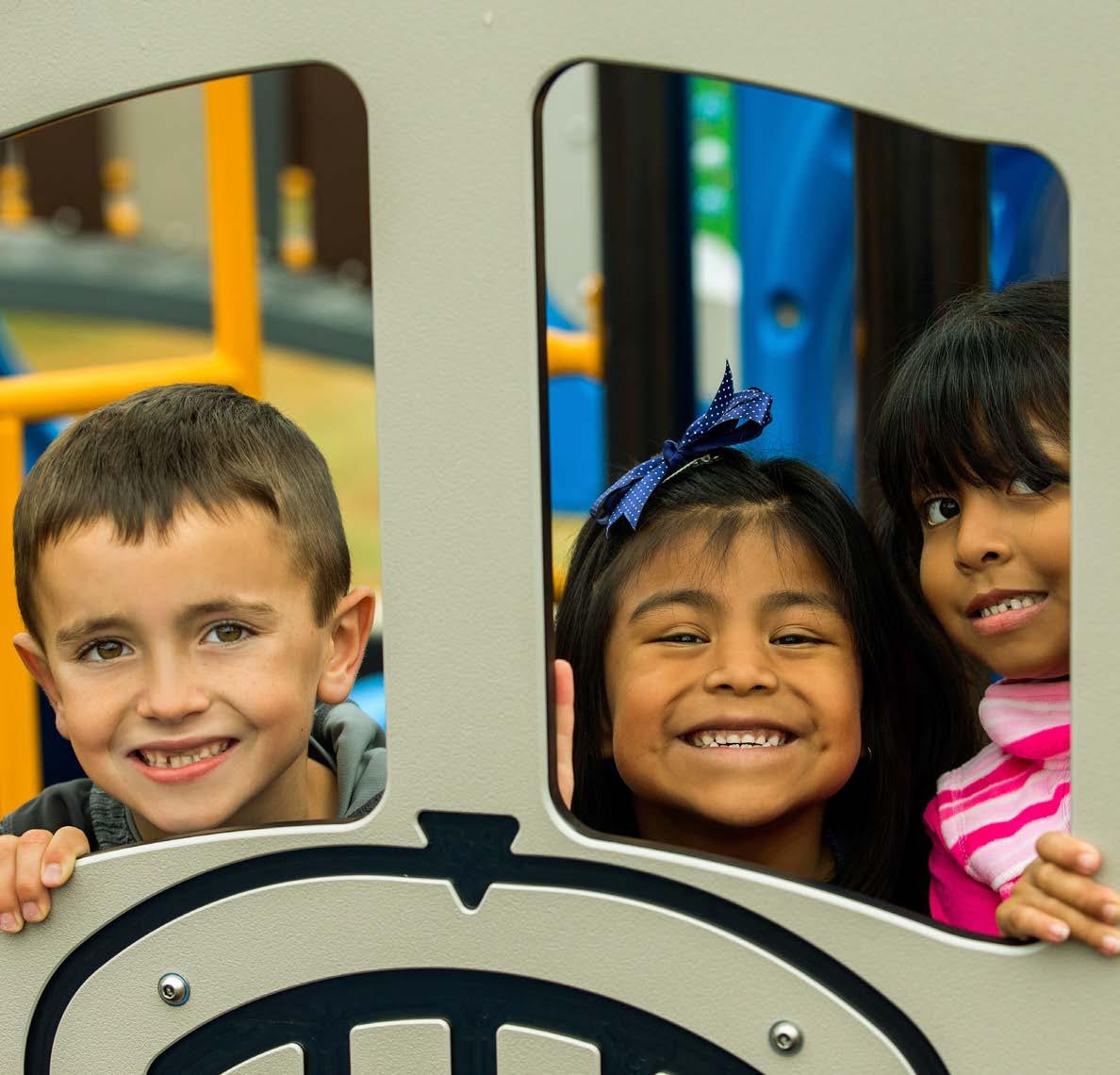
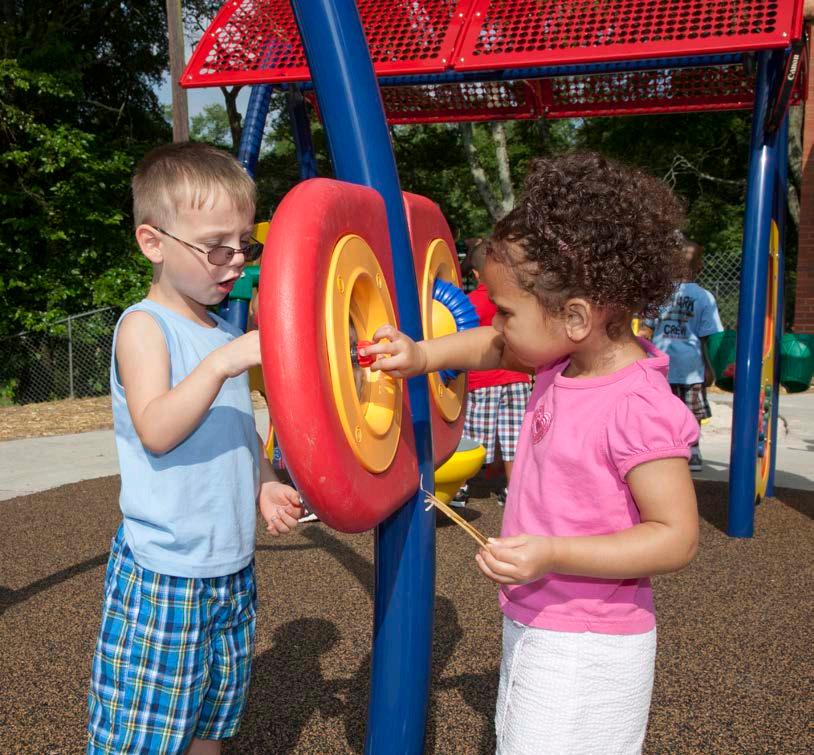
COMMUNICATION DOMAIN
The communication domain refers to perceiving, understanding, and producing language. Language development and effective communication capabilities are highly dependent on other developmental domains. For example, the social-emotional domain involves both verbal and nonverbal communication, and an individual’s cognitive ability will most likely impact their ability to express themselves and/or comprehension of language. Communication includes receptive, expressive, and pragmatic language skills.
Receptive language is the understanding or comprehension of words, sentences, and conversations that comprise a language. Complete comprehension involves attention, listening, and processing the message to gain information. Receptive language often precedes expressive language, as children listen to and understand words before being able to accurately reproduce them. Expressive language is how individuals communicate their wants and needs using vocalizations, gestures, words, and sentences. It encompasses verbal and nonverbal communication skills and how an individual uses language, and it may include individuals utilizing pictures, symbols, and/or augmentative communication devices with voice output.
Pragmatic language involves the ability to use language in social contexts. For example, listening as well as talking, or talking to a teacher differently than to a friend. Incorporating verbal and nonverbal communication, pragmatic skills are the essence of communication. Culture plays an important role in the pragmatic use of language including idioms, jokes, slang, effect, and tone of voice.
Activities to Support the Communication Needs of Children
Communication Boards and Visual Supports: Appropriate play supported by the use of communication boards or visual supports can assist children with disabilities in communicating their needs and playing with non-disabled peers, thus promoting cooperative play and social interaction.32 For example, communication boards that use pictures, symbols, letters, and/or words can be conveniently made available on panels or signage that is nearby play equipment and amenities for children to easily access to communicate with friends and/or caregivers. Assistive technology, augmentative communication devices, or other printed or digital resources that can move with individuals as they explore the environment can be provided through additional services or programming.
Parallel and Cooperative Play: Providing comfortable opportunities for playing in proximity with others, such as in parallel play, where eye contact can be easily made, is beneficial in fostering communication with peers. Increased social interaction occurs in play settings through natural proximity, mutually reinforcing events, and reciprocity.33 Over time, play activities can become increasingly cooperative and include taking turns, sharing materials, or emotional expression which will promote the generation of play ideas and allow the children to share a common focus.34
Inclusive Playground
Considerations:
Effective communication requires shared or joint attention. Joint attention is the use of verbal and nonverbal behaviors to direct attention to share an experience with another person.36 In addition to verbal communication, eye contact, smiles, and other body language or gestures provide people with the ability to interact with others nonverbally. Although commonly associated with communication and socialemotional disabilities such as autism, the inability to maintain joint attention is pervasive across disability types. The following considerations may be used in outdoor play environments to support a child’s ability to communicate, understand language, and develop joint attention.
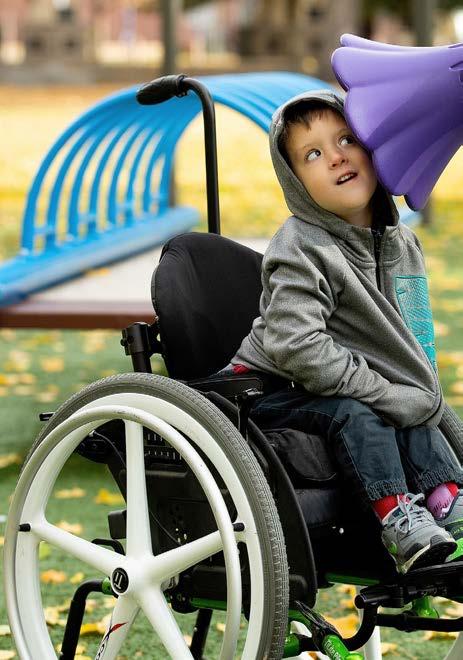
Low Degree of Concentration: Play activities that do not require a high degree of concentration can be beneficial in allowing children with disabilities to produce functional play and interact with others simultaneously. Activities that require low physical effort and encourage the use of natural body positions can make shared communication experiences more enjoyable for children with disabilities.
Imitation: Imitating play behaviors teaches children with disabilities the benefits of shared attention and social interaction.35 Promoting play areas in which reciprocal imitation, such as an inclusive seesaw or whirl, is encouraged and promotes children with and without disabilities to socially interact with others while experiencing a fun motion experience.
Turn-taking: Play activities which include interaction, in particular the idea of turn-taking, are important for developing conversational and interactive play skills. Play activities should be arranged for repetition and turn-taking. For example, a slide fosters repetitive turn-taking. Parallel slides foster more complex and increased interactions which are negotiated through receptive and expressive language.

Pretend Play: Open-ended play settings, (such as a theater panel, storefront panel, playhouses with a kitchen, tables, etc.) support pragmatic, receptive, and expressive language skills, particularly when accompanied by loose parts. In dramatic play, children take on roles (such as being a parent, an animal, or a superhero) and act out imagined scenarios. This type of play promotes the use of speaking and listening skills. Given the potential for development in multiple domains, special attention should be paid to designing these types of settings to be accessible to children with disabilities.
Jump-in Points: Observation areas, within comfortable proximity to socio-dramatic play activities, support children with communication and language disabilities and their ability to negotiate and gain confidence in the social interaction requirements needed to participate. By thoughtfully aligning planners, designers, and stakeholders to the unique benefits of thoughtful inclusive playground design, children with disabilities have greater opportunities to explore the play and recreation environment and interact with playground elements and activities with their peers.
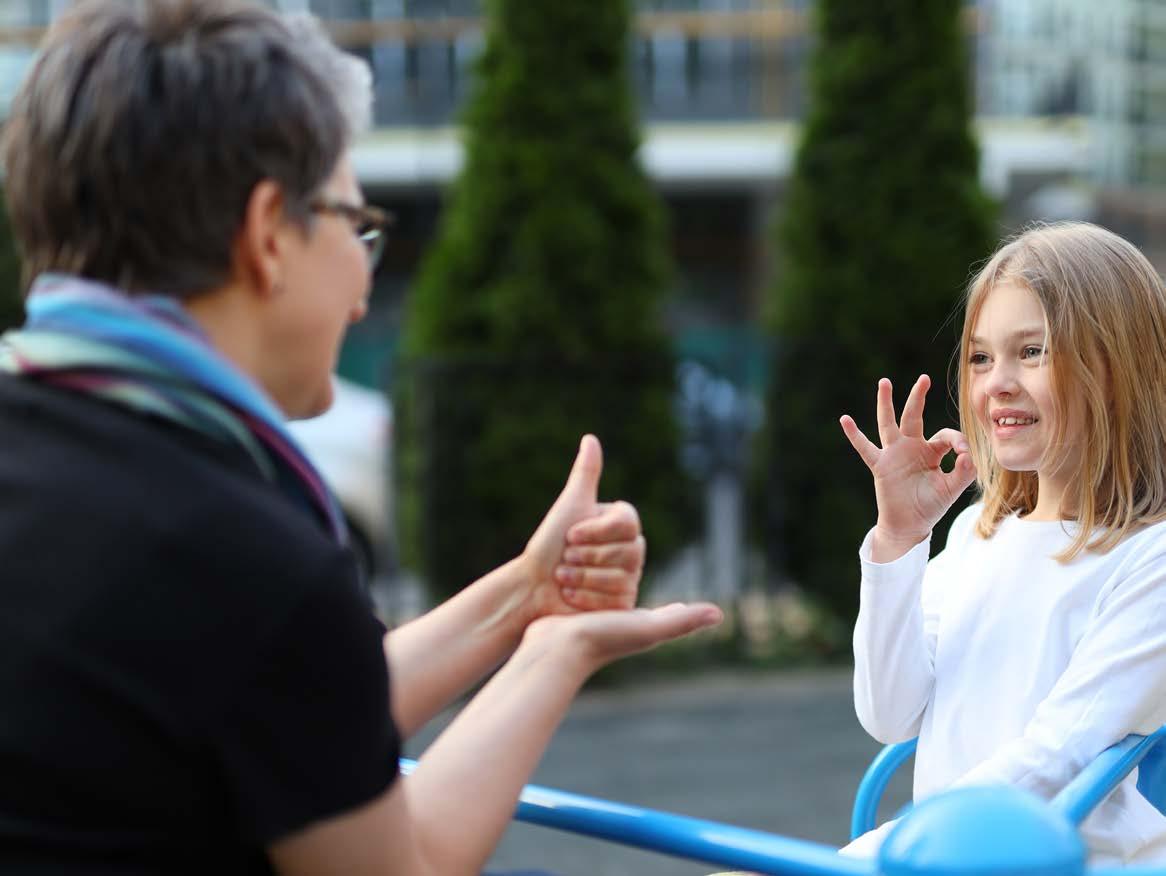
It is important to address the needs of individuals with different minds and to recognize that people think differently. It is a good idea to include more inclusive equipment and to do so, you must have different types of thinkers involved in the creation process.”
- Dr. Temple Grandin, World Renowned Scientist, Animal Behaviorist, Autism Advocate, Author
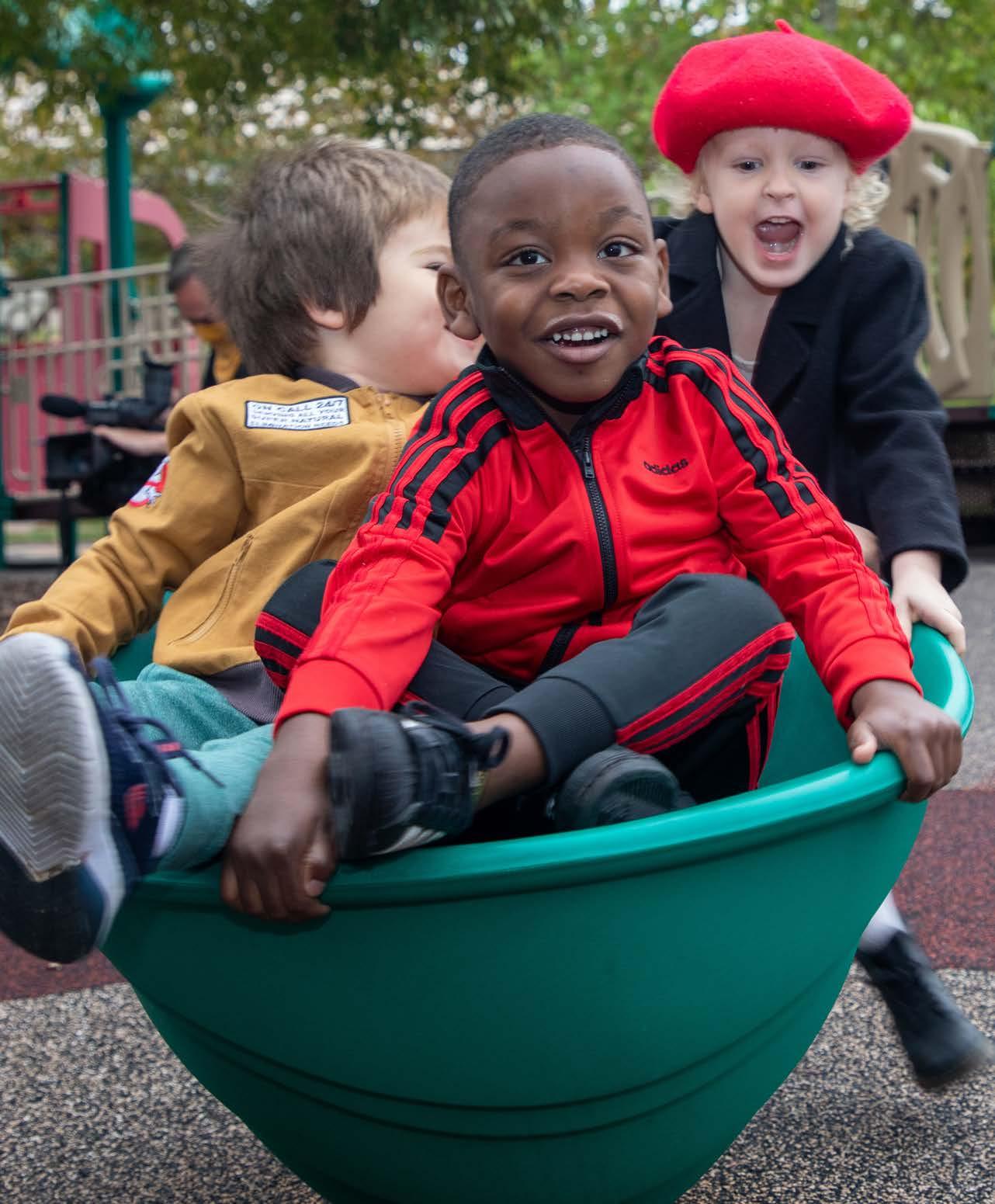
7 Principles of Inclusive Playground Design
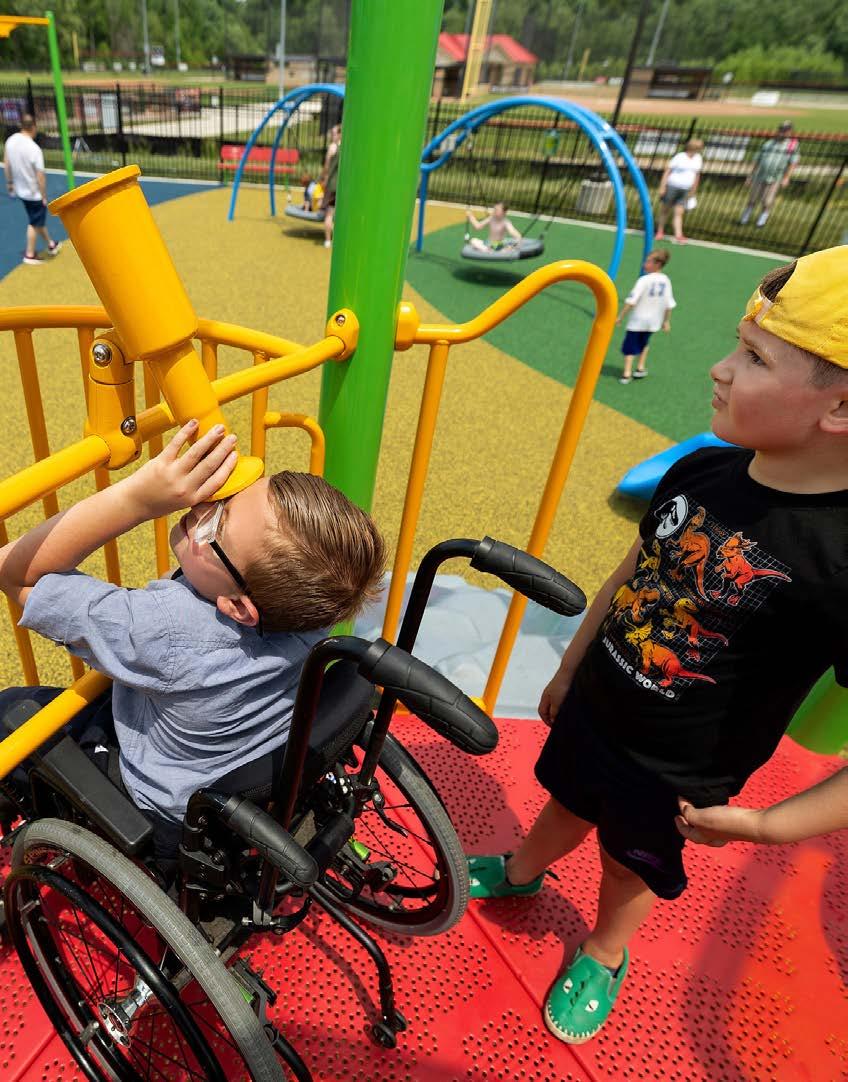
Be Innovating Evidence-Based Design of the WHOLE ENVIRONMENT
Evidence-Based Design Best Practices for Creating Environments that Support Play and Recreation for People of All Abilities Fair
Innovating the Whole Environment to Break Down Physical and Social Barriers
Thoughtfully planned inclusive outdoor play environments can create opportunities to ensure that people of all ages and abilities can be physically and socially active through play and recreation, while dramatically and positively impacting children’s play experiences. While necessary, the removal of physical barriers to access in play environments does not guarantee social inclusion, or the opportunity to actively participate. The 7 Principles of Inclusive Playground Design®, developed in partnership with Utah State University’s Institute for Disability Research, Policy, & Practice and PlayCore, move outdoor play environments beyond minimum accessibility requirements, recognize everyone’s right to fully participate and contribute to meaningful play and recreation opportunities, and foster the lifelong developmental, physical, and socialemotional benefits of inclusion.
The original 7 Principles of Universal Design were created by the Center for Universal Design at North Carolina State University.37 These commonly used principles, which are focused on adult usage of indoor environments, have been uniquely tailored to specifically address outdoor play and recreation environments and what experiences and feelings individuals wish to experience during play. People with and without
disabilities want to “Be” and feel that their play and recreation experiences are fair, that they are included, that they are smart, and that they can be independent, safe, active, and comfortable during physical and social play opportunities. The 7 Principles of Inclusive Playground Design focus on the access and usage of individual play features as well as the context of the overall environmental design to create more usable environments, for more people, to the greatest extent possible.
As the industry’s only evidence-based design best practices for inclusive playgrounds, communities worldwide have embraced this unique design philosophy. Since initially launching in 2007, the 7 Principles of Inclusive Playground Design have continued to evolve based on the latest research, innovations, and diverse needs of communities. These principles are interrelated and interdependent of each other. After many years of implementation, these design best practices help promote and champion the benefits of inclusive play and recreation destinations for parks and recreation, schools, and a variety of outdoor destinations across the world. Together we can turn research into practice and help advocate for inclusive, intergenerational play and recreation experiences that foster a deeper sense of belonging in every community. The following pages outline best practices for implementation, offer a variety of practical examples to consider, and define the inclusion benefits for each principle.
Tailoring the Principles

1 Be Fair
The environment promotes equitable use and does not segregate individuals with disabilities. It encourages developmentally beneficial intergenerational play by supporting the active participation of all people, including those with diverse abilities, needs, and interests throughout the environment.
Evidence-Based Design Best Practices
A. Address Connectivity and Parking
Parking and accessible routes to, around, and within the play and recreation environment that are connected throughout the space create efficient and convenient access.
• Connect the play and recreation destination with community transportation networks and neighborhoods.
• Locate parking areas to create a convenient accessible route to the park entrance(s) and playground.
• Provide more than the minimum required accessible parking spaces that include van spaces with wider access aisles and appropriate signage.
B.
Provide Accessible Pathways and Surfacing
Firm and stable surface materials on connecting routes and unitary fall-attenuating surfacing around play and recreation equipment ensure physical and social inclusion.
• Create accessible pathways and connecting routes using unitary surfaces such as concrete, asphalt, or boardwalk materials.
• Consider wider connecting pathways and routes, with a 60-inch minimum, to provide sufficient width for two individuals using mobility devices to pass or to travel together side-by-side with others.
• Add railings and edge protection on routes with running slopes greater than 5% or where there is a drop-off.
• Provide accessible routes to and around site amenities and the play equipment using unitary, fall-attenuating safety surfacing, such as poured-in-place rubber which provides the most consistent surface for accessibility.
C. Select Play Activities to Support the Developmental Needs of the Whole Child
Diverse play activities that address the physical, social-emotional, cognitive, sensory, and communicative domains of child development meet the developmental needs of the whole child.
• Include elevated and ground-level activities for children, caregivers, and families to gather in groups, both on and around the structure.
• Provide dramatic play activities to encourage imagination, creativity, and social-cognitive skills, and ensure that play elements are realistic and easy to recognize. Equipment designed as common and recognizable objects is more usable for children with vision and cognitive disabilities.
• Add a robust variety of activities that involve motor planning such as climbing, balancing, bilateral coordination/brachiating, dancing, running, jumping, balancing, spinning, swinging, and sliding elements to help children develop core strength, improve coordination skills, and regulate their nervous system through repetitive motion and movement.
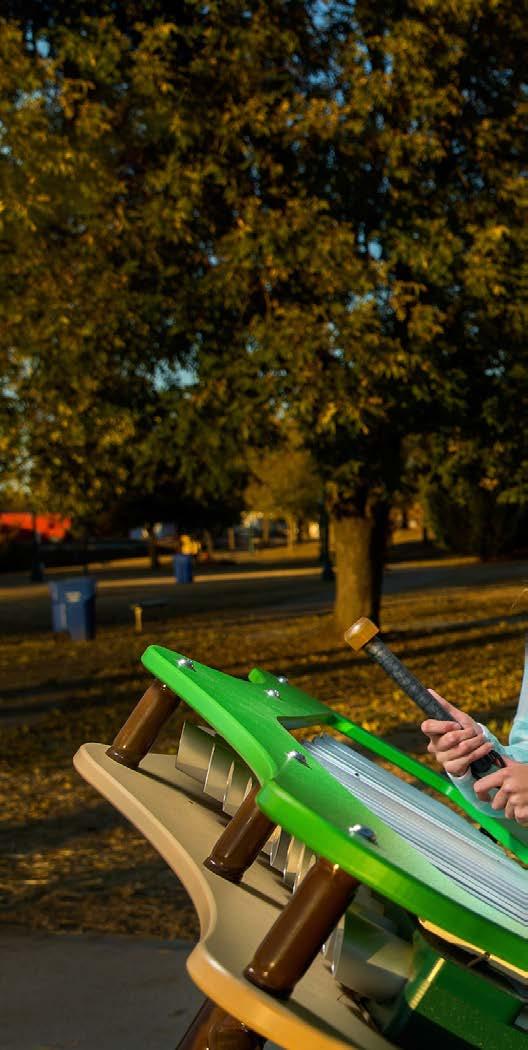
• Choose activities that have inclusive features such as transfer areas, handholds, adaptive switch capabilities, high backs, etc. that can be used by more people to the greatest extent.
• Ensure access and/or the ability to be an active participant in fun areas of the play space that are of high interest.
D.
Promote Intergenerational Play
Activities and programs that encourage people across generations to enjoy developmentally appropriate play experiences together nurture understanding and mutual respect while promoting social-emotional well-being.
• Offer music and auditory activities to encourage self-expression, collaboration, and developmentally appropriate play opportunities regardless of age or ability.
• Select dynamic play opportunities that were thoughtfully designed to encourage visitors of different age groups to interact and play together. For example, interactive games or multigenerational swings designed for children and adults to face each other are fun activities for multiple age groups.
• Use the destination as a catalyst to promote structured and unstructured play between people of all ages and abilities. Host special events and intentionally program the play environment to create awareness, break down barriers, and foster friendships between children, families, and people of all abilities.
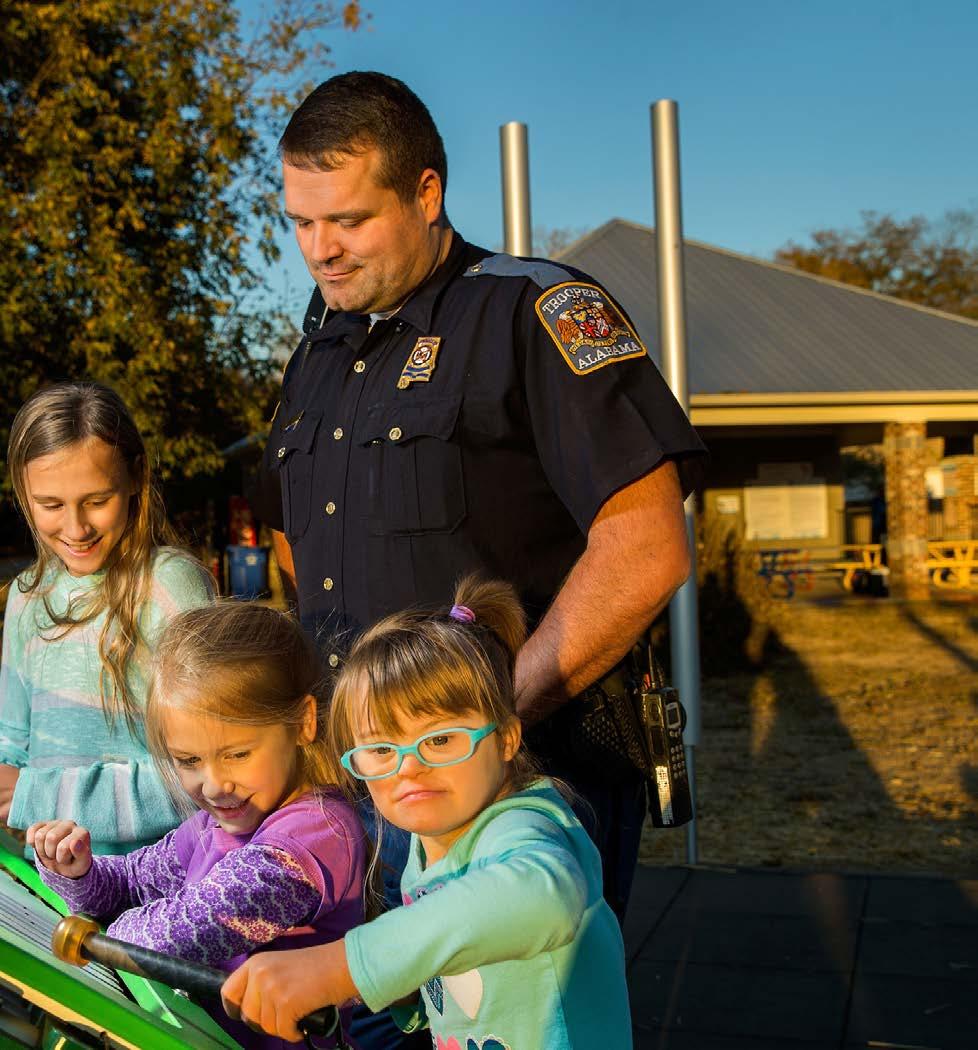
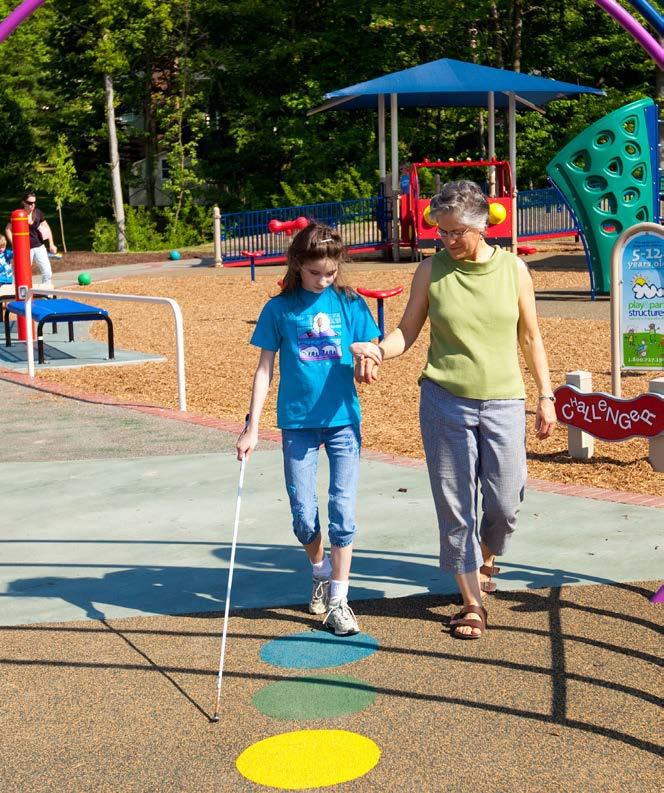
Inclusion Benefit:
Equitable play and recreation environments promote social justice and allow individuals to participate socially and physically in developmentally meaningful play experiences across their lifespan.
2 Be Included
The environment offers flexibility in use by supporting various types and forms of play that accommodate everyone’s right to participate by being more usable, by more people, to the greatest extent possible.
Evidence-Based Design Best Practices
A. Offer Various Types and Forms of Play
Environments that provide various types (physical, social, sensory, construction, dramatic, etc.) and forms (autonomous, parallel, cooperative, etc.) of play encourage play behaviors that meet the developmental needs of all children, including those with disabilities. Diverse environments provide higher play value and abundant opportunities for children to self-select activities that match their unique abilities and interests.
• Include features, equipment, or spaces that encourage cooperative play to bring children into close physical proximity to each other and require peer interactions and cooperation to make a positive action happen.
• Promote reciprocal imitation through play elements such as a multiple-user see-saw or rocking element to encourage children with disabilities to socially interact with others.
• Offer a variety of dramatic play elements that encourage social interaction and allow children of all abilities to demonstrate their creativity through pretend play.
• Incorporate relevant themes to support imaginative play and offer elements of surprise. Themes that are easily recognized or incorporate a community’s culture and heritage can be highly effective in supporting multiple users and/or side-by-side interaction to encourage social interaction between visitors.
• Provide loose parts, props, or natural elements to be used for imaginative play or to support play with equipment such as playhouses or sand/water tables. For example, balls, sand/water toys, musical instruments, and/ or manufactured or natural components designed to move and manipulate can foster various forms of play. Sand play paired with loose parts has been shown to increase and sustain social interaction, especially for children who are neurodivergent.38
B. Provide Choices
A variety of choices of how an individual chooses to play, products that can be used for a variety of purposes, and equitable alternatives help to ensure that there is something fun for everyone.
• Select non-prescriptive equipment that can be flexible in how it is used by children of different ages or abilities.
• Incorporate elements that create awareness about how individuals communicate, participate, and interact to promote diversity, mutual respect, and acceptance. For example, panels or signage with sign language, picture symbols, or Braille may be helpful for communication and to promote disability awareness.

C. Include Activities with Inclusive Features
Products intentionally designed with inclusion in mind are often utilized more by all children than products that do not include inclusive features.
• Provide play equipment that accommodates variations in gross and fine motor control and/or offers adaptations such as adaptive mallets for musical instruments, adaptive switch capabilities for play panels, large knobs for handholds, etc.
• Incorporate ramps, transfer systems, and/or accessible features to support access to elevated components and the opportunity to experience various heights. Social play between children with and without disabilities increases with elevation. Elevated play platforms/ decks need to be physically accessible to be truly inclusive.
• Provide full-body support and features with high backs, molded harnesses or supports to help children maintain a neutral body position, handholds for inclusive swing seats, spinning, rocking elements, and/or other motion/movement activities designed for wheelchairs to roll onto the platform, to join their peers or caregivers in the activity.
D. Promote Expressive and Receptive Language
Play environments designed to support language development offer verbal and nonverbal communication opportunities and provide various ways for people of all abilities to communicate.
• Include various ways for individuals to develop expressive language skills and communicate their feelings, wants, and/or needs to friends and family-whether by speaking, vocalizing, or by using communication boards or voice output devices.
• Support receptive language skills by including opportunities to reinforce vocabulary and comprehension. Panels with images, words, and/or auditory output can help children process messages to gain understanding.
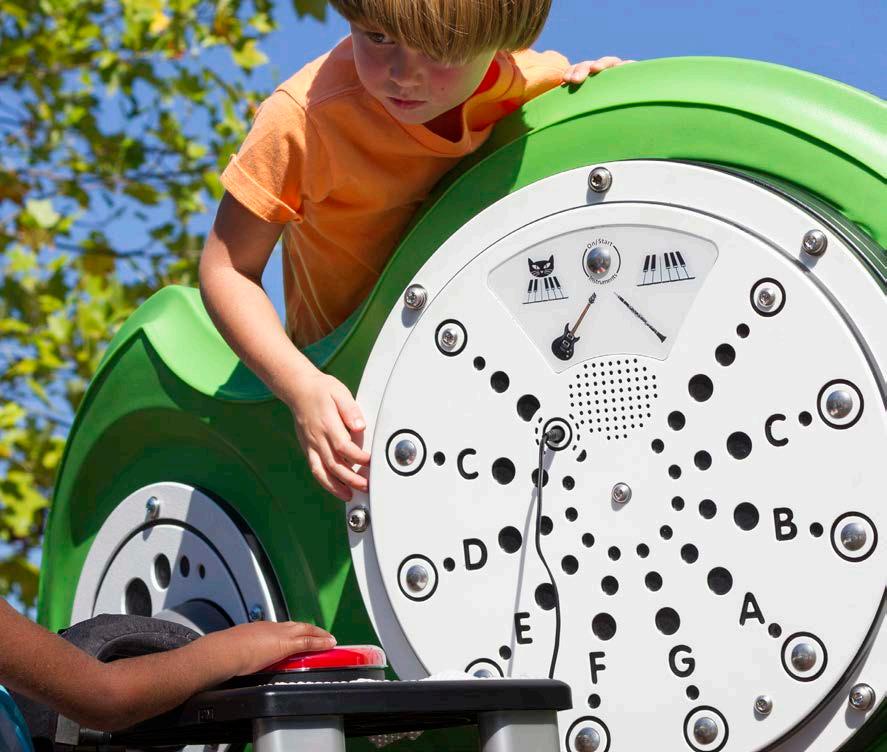
Inclusion
Benefit:
Flexible play environments celebrate the abilities of individuals, encourage full participation in play, and bring communities together through shared experiences with their family members, neighbors, and friends.
3 Be Smart
The design of the environment is simple and intuitive to ensure that individuals feel successful, can demonstrate what they know, and have opportunities to gain confidence through meaningful play experiences.
Evidence-Based Design Best Practices
A. Provide Cues
Behavioral and visual cues, especially with sensory feedback, encourage social inclusion and help visitors understand what is expected, setting them up for greater success and enjoyment.
Cues can provide positive reinforcement and allow individuals of all abilities to demonstrate what they know and what they can do. Diverse environments provide higher play value and abundant opportunities for children to self-select activities that match their unique abilities and interests.
• Utilize various surface materials, textures, sounds, and/or colors to provide visual, auditory, and tactile cues to help organize specific activity areas and the whole environment so that it is easier to navigate and understand.
• Use color, graphic accents, and/or landscaping to provide intentional visual cues in areas with high traffic, motion/movement, or changes in height levels. For example, use contrasting colors on steps and decks, planting pockets outside the use zone of a swing area to create a visual barrier to indicate to play participants to proceed with caution, or graphics on the surface of high-traffic areas, such as slide exit ways to provide a consistent cue throughout the environment.
B.
Support Intuitive Play Patterns and Behaviors
Being consistent with individuals’ expectations, intuition, and naturally occurring developmental play behavior helps avoid unnecessary complexity and keeps children engaged in more meaningful play experiences for longer periods of time.
• Incorporate “looping” patterns throughout the environment by intentionally designing slide exits near climbers, transfer points, and ramp entryways so that children can successfully engage in repetitive play designed to build confidence and support the developmental progression of skills.
• Consider designing the layout of the fixed play equipment in a circle, leaving the middle open for cooperative play. Circular playground designs that link activities to complementary activities encourage repetitive skill-building behaviors.
• Incorporate auditory, visual, tactile, and olfactory opportunities to positively reinforce and naturally promote developmentally appropriate play behaviors and sensory-rich experiences.
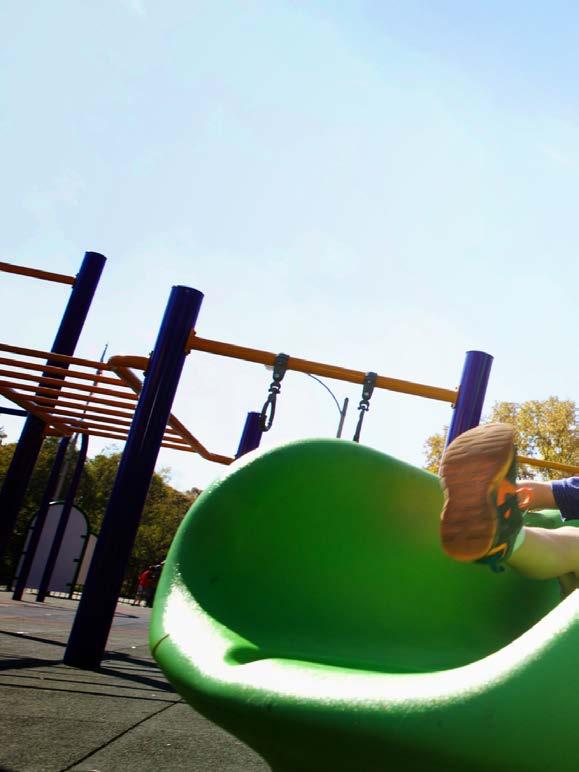
C. Develop ‘Jump-in Points’
Intentionally placed observation areas allow children to sit watch, learn, and process the play behaviors of others and support social engagement between children with and without disabilities as they feel ready.
• Provide comfortable and convenient areas for children to sit, process, observe, and gain confidence in play by using seats at ground level and on play structures.
• Incorporate ‘jump-in points’ adjacent to or within activity areas designed for dramatic play, interactive games, or elements such as music. Research shows that this helps children understand the activity so they are naturally drawn into social-cognitive play experiences with others when they feel emotionally ready.
D.
Define Activity Settings
Thoughtfully defined settings allow children to remain immersed in play, expand on play opportunities, and avoid user conflict. Children with disabilities often benefit from more structured environments that are more predictable.
• Create a well-organized environment, within the play area and throughout the whole environment. Establish, easy-to-recognize areas that intentionally reinforce appropriate play patterns and set clear expectations.
• Organize active vs. passive areas and design these spaces near other similar areas that can further enhance play behaviors. For example, a dramatic playhouse or store play panel positioned near a sand/water play area or by natural loose parts can support imaginative play.
• Define heavy/active use areas such as swings and slide exits to avoid user conflict and to indicate the area that visitors should use caution in high-activity areas. For example, various playground safety surfacing or colors can provide a contrast between activity, and circulation zones.
• Divide larger play environments into defined areas that allow for the tion of activities with recognizable boundaries and locate similar
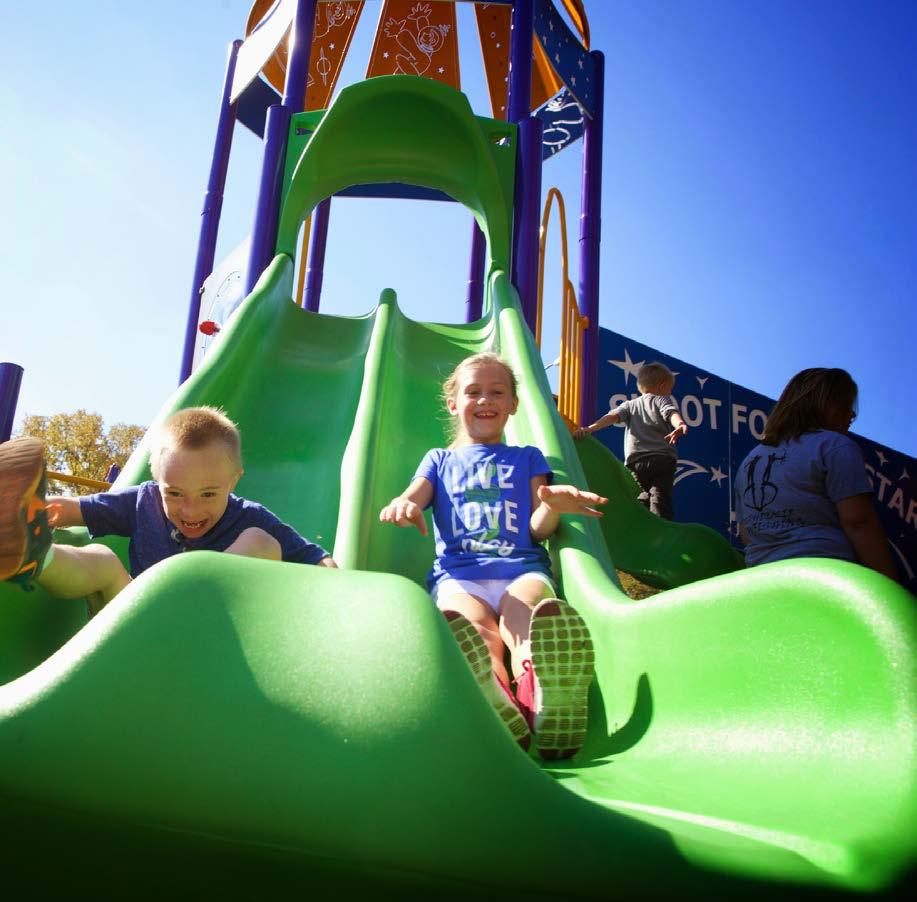
Inclusion Benefit:
An intuitive play environment allows people of all ages and abilities to discover and demonstrate that they are capable, able to take risks, and can be successful in engaging in both physical and social play opportunities.
4 Be Independent
The design communicates perceptible information and allows individuals to effectively explore, interact, and participate in sensory-rich play as independently as possible.
Evidence-Based Design Best Practices
A. Create a Sense of Belonging and Community
Providing accessible and alternative formats when communicating information about the park or special events promotes diversity, fosters acceptance, and demonstrates mutual respect. Considering the needs of individuals of diverse abilities, ages, races, genders, ethnicities, cultures, sexual orientations, and socioeconomic statuses ensures that people feel welcome, arrive equipped with needed information, and have a better understanding of the expectations needed to participate.
• Provide detailed website information about the park and the inclusive features offered and tactile 3D site models when possible.
• Create a formal entry point that is accessible and linked by an orientation path. Include areas to sit and observe the layout so people can become familiar with the space and decide where to go.
• Offer wayfinding features and visual signage that is welcoming and identifies accessible routes and facilities within the site. Signage should be easy to understand and child-friendly. Consider offering picture symbols with raised images, words, and/or Braille. Signs with QR codes can provide bilingual options or videos in different languages.
• Provide the ability for individuals to make requests for special accommodations such as sign language or bilingual interpretation at special events or printed materials in alternative formats.
B. Support Navigation and Participation
Opportunities for individuals using mobility devices, older adults, caregivers pushing strollers, people with service animals, and others should access play as independently as possible. Caregivers should be able to supervise and facilitate children’s participation in play when necessary, without overly interfering.
• Provide ramp access to accommodate multiple users, equipment, and caregivers. Wide ramps allow an individual using a mobility device to move up the structure alongside a peer or caregiver or pass another person using a mobility device going down the structure. Consider sensory features that provide tactile, visual, and/or auditory features to ramps for additional play value.
• Utilize slide transfers, especially on slides that are accessible via a ramp. This supports the independence and safety of individuals who choose to transfer out of their mobility device to access the slide entrance. It also provides additional height and support to caregivers who may be assisting others.
• Incorporate universal design features such as handholds in transfer platforms, adapted handholds on climbers, handrails, etc. to support independent exploration to build self-awareness, self-esteem, and self-confidence through play.
Inclusion Benefit:
A play environment that communicates what to expect, what to do, and how to participate supports self-determination and independence, builds confidence, and fosters self-esteem.

C. Offer Multisensory Experiences
All children should have opportunities to explore through coherent sensory experiences such as auditory (hearing), visual (seeing), tactile (touch), olfactory (smell), gustatory (taste), vestibular (balance and movement), and proprioceptive play (body position and motor planning) to comprehend and discover the world around them.
• Select interactive play panels, music elements, and/or manipulative activities that provide visual, tactile, and auditory feedback to increase understanding of cause and effect, promote learning, and facilitate social interaction.
• Organize and plan a multisensory environment by incorporating manufactured and natural elements that use color, light, pitch, tone, textures, movement, and even smells.
• Carefully consider the location of sensory stimuli to avoid creating a chaotic sensory environment of haphazard stimuli and create sensory consistency. For example, use color carefully to avoid over-stimulation or confusion.
• Offer sensory-rich feedback through a variety of inclusive motion and movement components such as swinging, rocking, and spinning to provide vestibular and proprioceptive opportunities to support balance and motor planning.
• Define multisensory landmarks and activities to attract the attention of all children. Within a sensory-consistent play environment, a multisensory landmark may be used to focus shared attention between children with disabilities and their peers.
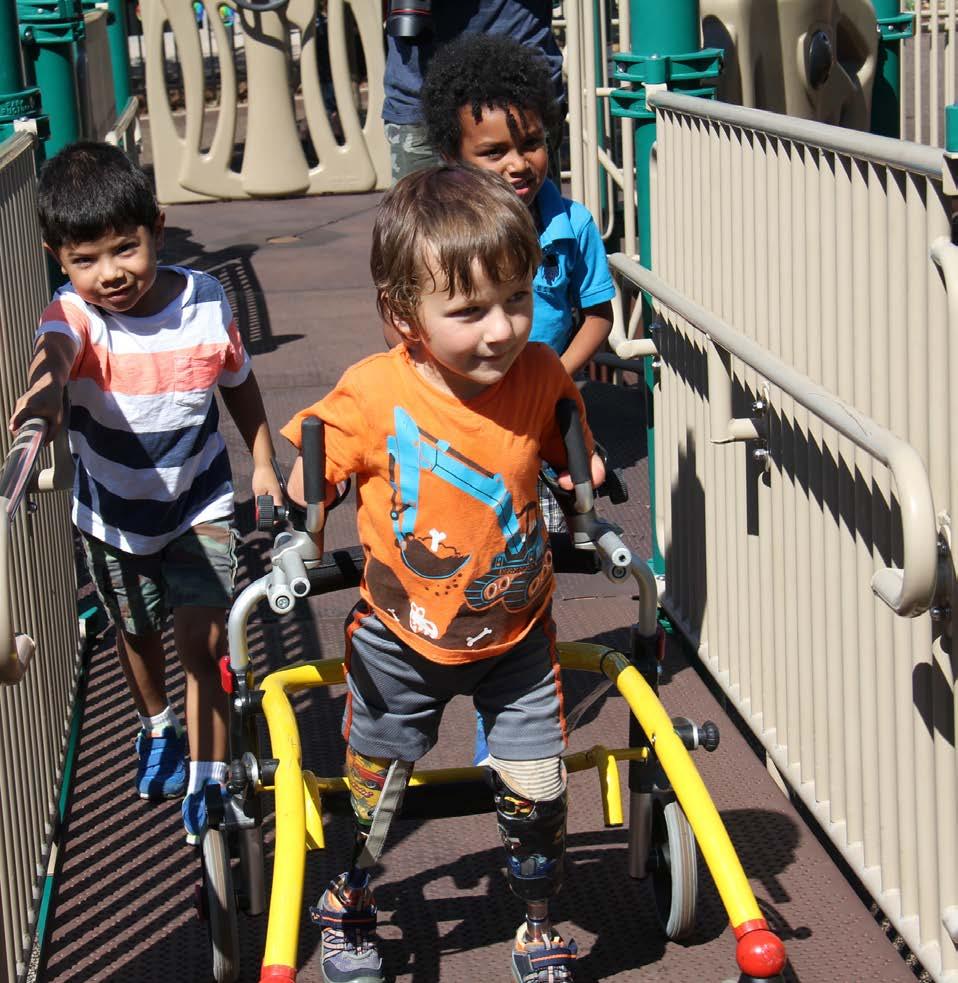
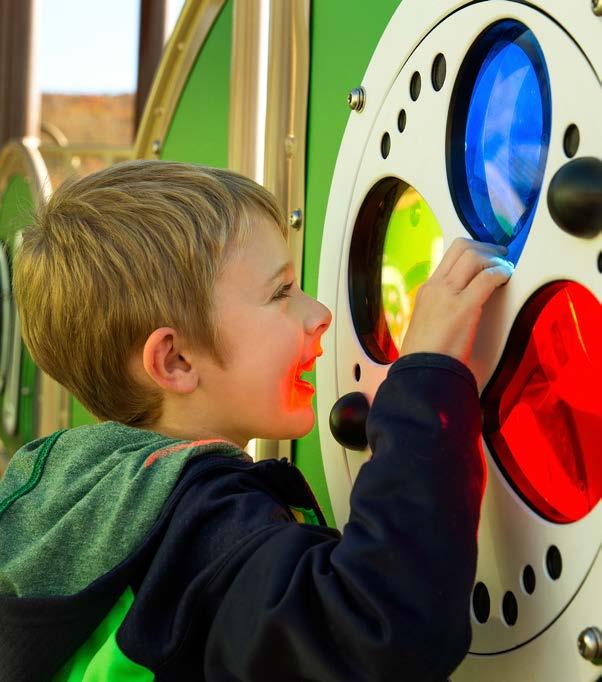
Be Safe
The play environment is tolerant of error by meeting current safety standards, considering unintentional actions, and promoting emotional security for personal growth and development.
Evidence-Based Design Best Practices
A. Meet Safety Standards, Address Potential Hazards, and Promote Healthy Risk
Age-appropriate play equipment with inclusive design features supports multigenerational use, addresses ongoing maintenance needs, and promotes safer play.
• Define age-specific equipment clearly in designated areas with signage to indicate the developmentally appropriate user groups.
• Ensure an ongoing maintenance plan and routine inspections with timely corrective action.
• Establish visual (color and graphics) and tactile (various surfaces or materials) cues throughout the playground to identify pathways and active areas.
• Handholds, barriers, and guardrails allow children to feel emotionally secure as they explore the area and developmentally appropriate risks.
• Minimize the risk of children leaving the play area unsupervised by considering the distance of the play environment from the roads and parking areas. When necessary, utilize manufactured or natural barriers such as fencing, landforms, or landscaping to create boundaries and barriers to traffic.
• Ensure that the environment and support facilities are properly lit.
B. Design to Support Emotional Well-Being
The feelings and individual needs of children and adults should be addressed to provide the emotional security needed so that they are more likely to engage in play for longer periods of time. Incorporate cozy areas for sensory relief, provide areas to retreat until emotionally ready to participate, or create spaces for observation to process the environment until ready to engage with others. These neutral spaces, in addition to facilitating sensory relief, are important for social relief where users can pace and regulate their social interactions.
• Establish comfortable or ‘cozy’ settings where children can go for sensory relief to regroup or relax in a quiet space, and/or play alone if desired. Cozy spots should be intentionally designed in quiet, semi-enclosed areas or can be manufactured equipment designed to provide a quiet space under, on, or outside the active play area, but in close proximity to the play environment. For example, seats placed under decks, crawl tubes, tunnels, or sensory nooks can create calming areas throughout the environment.
C. Integrate Areas for Comfortable Supervision
Thoughtfully lay out the environment for easy supervision and reduction of unintended hazards so caregivers and family members remain confident and secure while children are independently engaged in play.
• Allow for accessible seating and observation spaces for caregivers, including individuals using mobility devices. Carefully consider adult sight lines and shade to support safe and comfortable supervision and to facilitate children’s participation in play when needed.
• Design sitting areas and install benches to include adjacent wheelchair spaces or parking areas for strollers on an accessible surface. Adequate space should be provided so that wheelchairs and/or strollers do not block circulation patterns or routes of travel, and these areas should be oriented to provide clear vantage points for caregivers to supervise.

Inclusion Benefit:
Play settings should provide an emotionally, socially, and physically secure environment and allow children to explore, engage in developmentally appropriate risks, and gain skills and confidence through safer play.
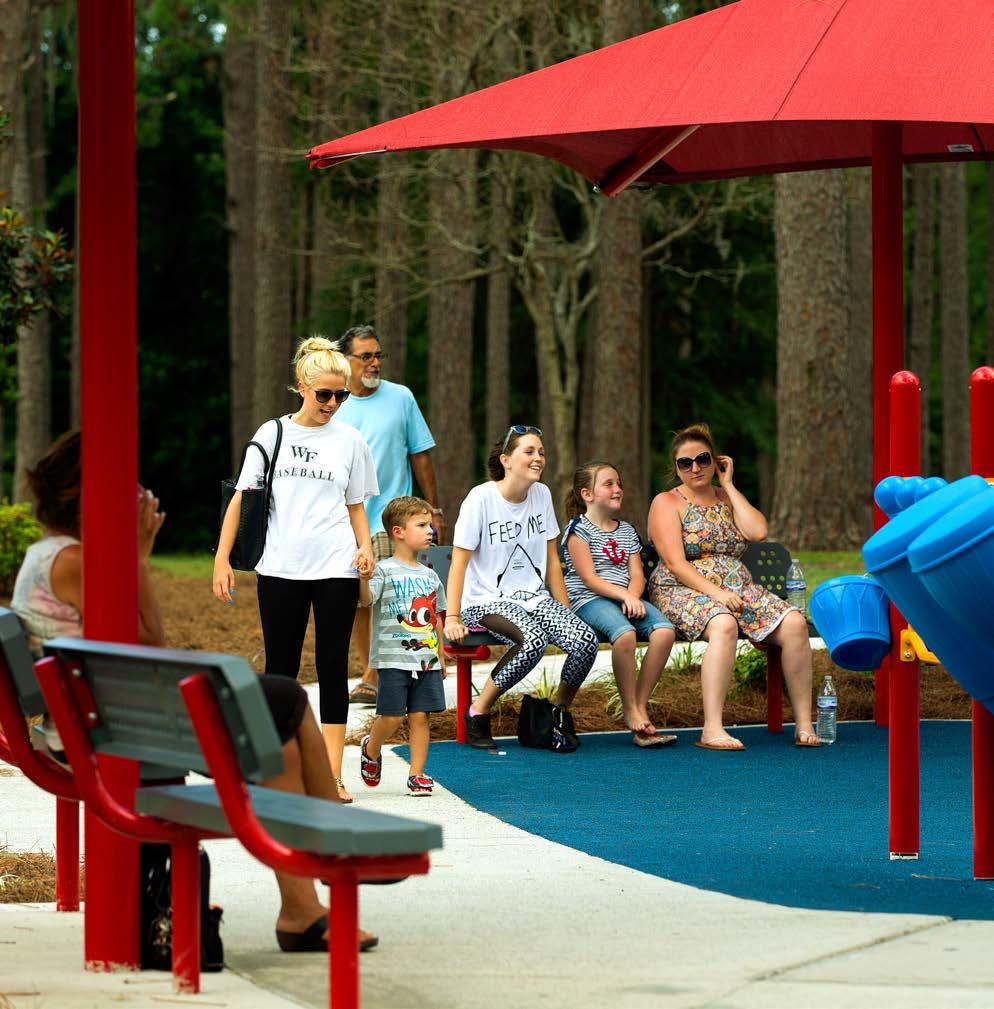
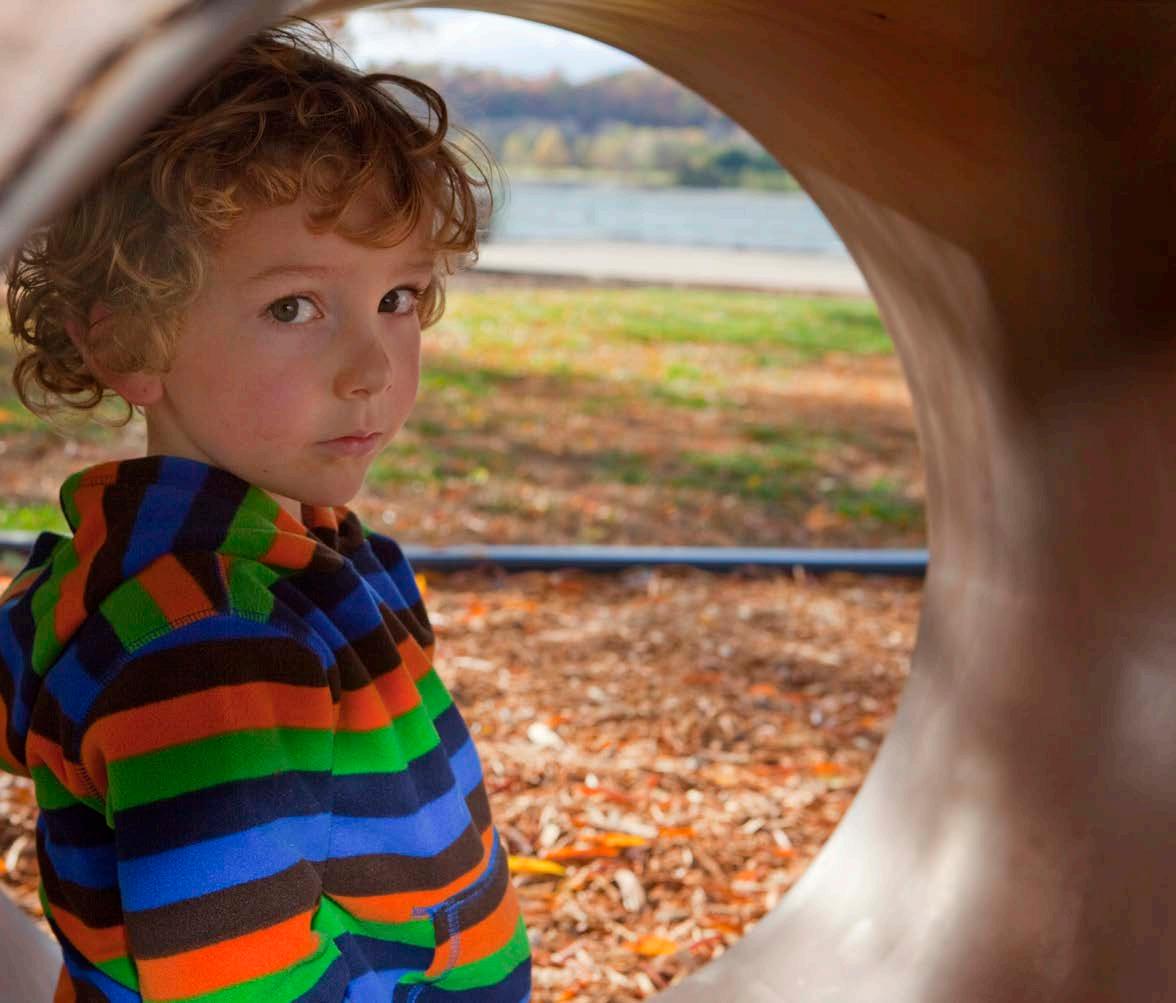
6
Be Active
The play environment can be used efficiently, supporting diverse opportunities for individuals to engage in sustained, healthy physical activity with an emphasis on social participation and cooperation.
Evidence-Based Design Best Practices
A. Ensure Variety and Graduated Levels of Challenge
Opportunities for individuals to explore, interact, and engage in developmentally appropriate risks that are not typical of their daily routine provide a continuum of skills, increase play value, and encourage physical activity.
• Increase play value by providing a diverse assortment of play opportunities through swinging, sliding, spinning, rocking, crawling, climbing, brachiating/upper body bilateral coordination, and balancing.
• Offer gross motor play equipment that provides a developmental progression of skills through beginning, intermediate, and advanced levels of challenge. Play environments that simultaneously support multiple activities, link to complementary activities, and offer graduated challenges are more valuable than those that do not.
• Configure the layout of the environment to encourage active movement and exploration by offering balanced opportunities for social and physical play at both ground level and on the play structures.
B. Integrate Equitable Alternatives
Diversify play opportunities by offering activities that require a reasonable operating force to sustain physical effort or repetitive actions.
• Provide equitable alternatives in close proximity to similar physical activities such as climbers and upper body/brachiating equipment to offer equitable fitness experiences designed to promote gross motor skills and physical activity. Activities such as ground-level hand cyclers, therapeutic rings, or chinning bars installed adjacent to more advanced upper-body activities provide side-by-side upper body events that address various needs and skill levels.
C. Accommodate Diverse Physical Needs
Selecting universally designed activities that require low physical effort and encourage the use of natural body positions can make shared play experiences more enjoyable, especially for children with physical disabilities.
• Consider children’s diverse physical characteristics and needs by including swinging, rocking, and/or spinning components that offer inclusive features such as molded seats, high backs, and/or adjustable harnesses to provide supports to help individuals maintain a neutral body position so they can sustain their engagement in active physical and social play.
• Choose inclusive products that don’t require an individual to transfer out of their mobility device to enjoy motion/movement activities. Spinning, rocking, and/or swinging elements that are level with the ground and designed for multiple users, including individuals using mobility devices, ensure that everyone can enjoy movement experiences that support the vestibular and proprioceptive senses, important to the development of gross motor skills.

D. Encourage Cooperation and Socialization
Reciprocal and cooperative interactive experiences integrated throughout the environment provide a balance of opportunities for individuals of all abilities to be and feel socially included and successful. Choosing activities that naturally encourage social interactions or that were intentionally designed for multiple users offer higher levels of play value.
• Select activities that encourage cooperative play versus competitive play. For example, many freestanding activities work even better when two or more children are participating rather than competing with one another, such as inclusive whirls, multi-user swings, inclusive rocking elements, see-saws, interactive games, etc.
• Include activities that do not require a high degree of concentration for sustained periods of time. Simple, intuitive play activities can be beneficial in allowing children with disabilities to engage in functional play experiences and interact with others simultaneously.
Inclusion Benefit:
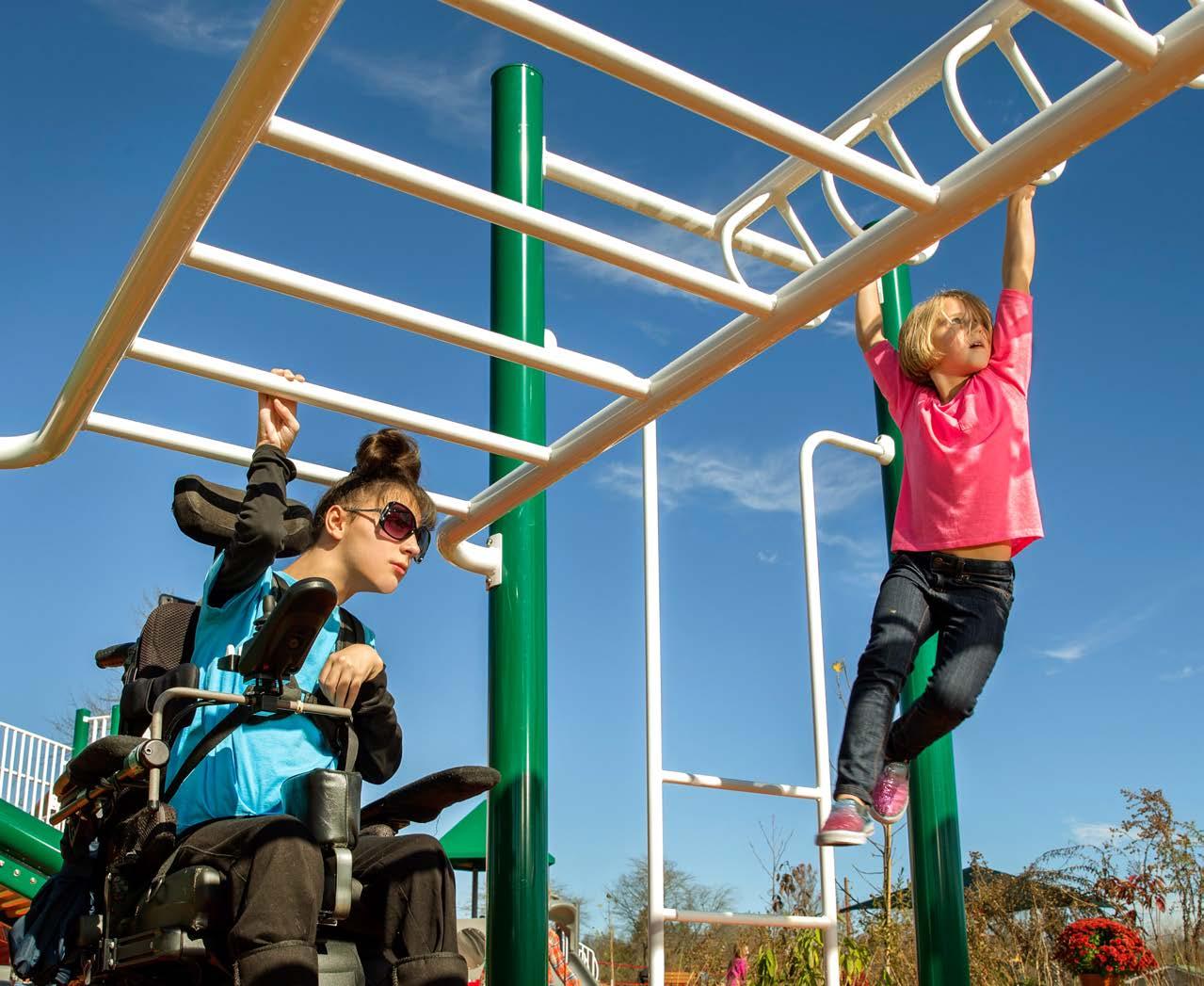
An efficient play environment designed to promote active play improves the overall health and well-being of society and minimizes fatigue, so people of all abilities can engage in and enjoy active play for longer periods of time.
Be Comfortable
Appropriate size and space are provided for approach and use so that the play environment is comfortable for individuals with diverse sensory needs, body size, posture, mobility, environmental sensitivity, and motor control.
Evidence-Based Design Best Practices
A. Address Approach and Reach Ranges
Play activities and panels that provide open space at the bottom allow individuals using mobility devices the ability to interact while facing forward, important for supporting people with various reach range capabilities. Freestanding components should be easily reached by children and adults at different sitting and standing heights and abilities.
• Provide half panels at ground level and on the structure so that individuals using mobility devices can easily reach play activities in a forward-facing direction. Clear ground space at the bottom allows the footrests of a wheelchair or wheels of other mobility devices to slide underneath the activity, increasing reach ranges for diverse users.
• Install music activities, talk tubes, and other freestanding components at appropriate heights that meet the variety of anthropometric needs of visitors and ensure that everyone can comfortably interact with the activity.
B. Provide Adequate Space for Movement and Gathering
Multiple users, individuals using assistive devices, adaptive equipment, and/or requiring personal assistance from caregivers or service animals should be able to move freely and with ease on the play structure and around the whole environment to access park amenities.
• Utilize wider ramps, decks, pathways, parking spaces, and accessible routes inside and outside the play environment to increase comfort, avoid user conflict, and encourage multiple users to explore and gather on or around the space.
• Add a ‘parking’ area immediately inside the entry for visitors to park strollers, wheelchairs, or other adaptive equipment.
• Provide accessible surfacing and sufficient space for maneuvering between, around, and on play equipment, site amenities, and park features. Accessible routes that are wide enough for two people using wheelchairs to pass each other with ease are ideal.
C.
Offer a Balance of Environmental Conditions
Integrating a balance of exposure and relief to environmental conditions such as sunlight, shade, water, and wind considers the needs and preferences of individuals with sensitivities or special medical conditions. The more comfortable the environment, the more likely visitors will stay and engage in play for longer periods of time.
• Offer a combination of integrated shade or shelters (manufactured) and natural (tree canopy) to provide relief from elements and increase overall comfort during their visit.
• Shade, shelters, and pavilions should be located on an accessible route and provide a firm and stable surface throughout.
• Misters for cooling, water fountains, and aquatic play areas can provide cooling options and additional relief from heat.
D. Plan for Amenities
Accessible amenities designed to meet the various needs of users of all ages and abilities should be incorporated throughout the environment to positively enhance play and recreation experiences and promote social inclusion.
• Provide accessible restrooms, including a family/unisex toilet facility with at least one adult-sized changing table and at least one infant-sized changing table. Restrooms should provide accessible sink(s) with touchless operation, hand drying features within accessible reach ranges, signage with Braille charactersand raised pictorial symbols at toilet room doors, and easy-to-operate restroom door locks.
• Select picnic tables or other seating/gathering amenities that have wheelchair spaces integrated, preferably in the middle, and allow space for multiple individuals who use mobility devices to comfortably gather at the same table.
• Accessible benches and picnic tables should be installed on firm and stable surfaces along accessible routes, preferably under shade structures, shelters, or trees for increased comfort. Seats with back support and armrests provide additional support.
• Drinking fountains and water bottle filling stations should be accessible and available at different heights. Switch/bar or automatic touchless sensors are preferred accessible features.
• Locate trash and refuse receptacles along accessible routes away from benches and seating areas designed for supervision. Receptacles should be easily operated with one hand and should be near picnic/ eating areas if applicable.
• Provide universally designed adult outdoor fitness equipment for adults or caregivers using mobility devices to have the opportunity to engage in aerobic and musclestrengthening activities alongside others.
Inclusion Benefit:
A play environment that provides appropriate size and space recognizes the diversity of individual abilities and creates an environment that encourages visitors to stay longer and visit often.
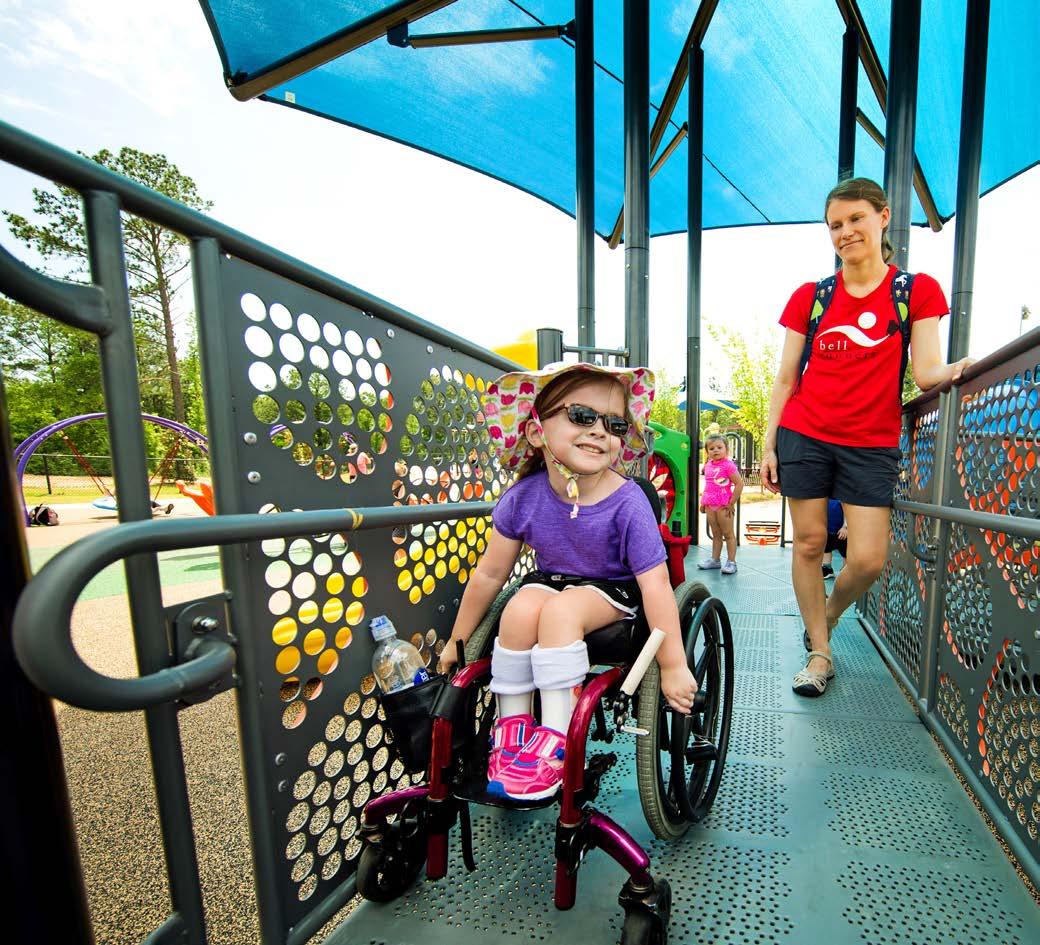
Overview of Evidence-Based Design Best Practices
Understanding the unique features and benefits of inclusive play activities can thoughtfully support the development of the WHOLE CHILD and the WHOLE ENVIRONMENT. Align inclusive play destinations with the following design best practices to intentionally ensure a developmentally robust and balanced assortment of playground activities that meet the diverse physical, social-emotional, sensory, cognitive, and communicative needs of all children. The following essentials demonstrate how applying the 7 Principles of Inclusive Playground Design® turns research into practice to create high-quality inclusive play destinations.
Inclusive Play Essential
Accessible Routes & Safety
Surfacing
Music & Sound
Dramatic Play Elements
Opportunities for Expressive & Receptive Language
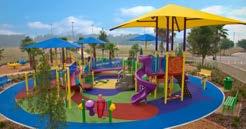
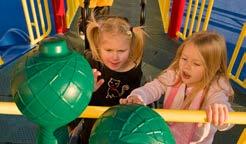
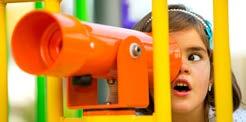
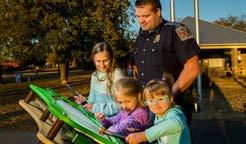
Promotes physical and social inclusion for visitors to travel to and throughout the environment
Encourages collaboration, creativity, and an age-appropriate activity for intergenerational users at any developmental stage
Fosters imagination, creativity, symbolic thinking, learning, and social dialogue through pretend play
Looping Patterns
Jump-in Points
Defined Activity Settings
Ramp Access

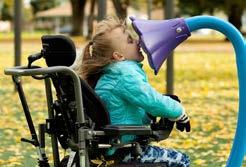
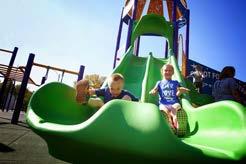
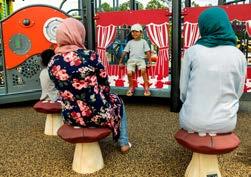
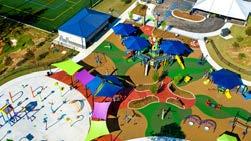
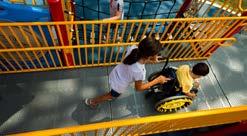
Encourages communication and understanding of language through motivating, collaborative, and reciprocal experiences
Supports intuitive play behaviors to avoid unnecessary complexity and encourage children to engage in repetitive, active play to support skills development
Provide a passive area adjacent to a social-cognitive activity for children to observe and gain understanding and confidence to engage with their peers
Organizes active and passive spaces so that it is easy to understand, enhance play opportunities, and avoid user conflict
Allows diverse users, adaptive equipment, and caregivers to access a play structure and experience various heights
Inclusive Play Essential
Slides w/ Slide Transfers
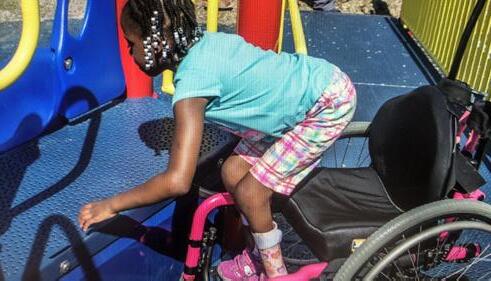
Motion Activities w/ Inclusive Features
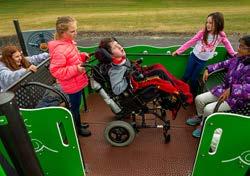
Cozy Spots
Seating & Areas for Adult Supervision
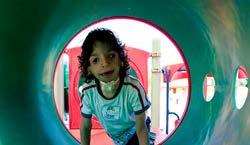
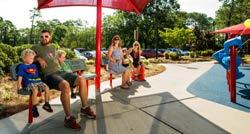
Graduated Levels of Physical Challenge
Accessible Upper Body Events
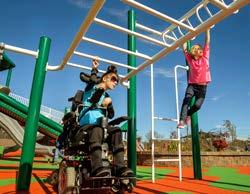
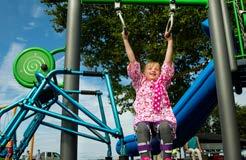
Cooperative Play
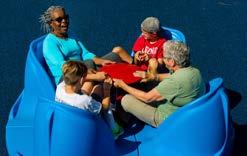
Half Activity Panels
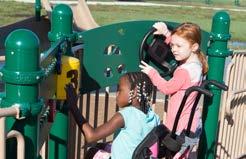
Shade
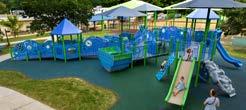
Supports the independence and safety of individuals who choose to transfer from their mobility device onto the slide entrance
Provides sensory-rich experiences for children to engage in spinning, swinging, and/or rocking for vestibular and proprioceptive input to support balance and motor planning
Offers semi-enclosed, quiet spaces where children can retreat for sensory and social relief
Provides clear visibility of activity areas and adequate space for caregivers using wheelchairs or other assistive equipment
Fosters a developmental progression of gross motor skills through climbing and upper body events through beginning, intermediate, and advanced levels of challenge
Offers rewarding and equitable alternatives to climbing or horizontal ladders for individuals using mobility devices or who are developing upper body strength
Reinforces positive interactions between children through dynamic and fun experiences as they work together to drive or complete an action
Provides adequate space underneath the panel or equipment for individuals using mobility devices to comfortably approach and reach the activity while facing forward
Integrates a balance of exposure and relief to environmental conditions
7 Principles of Inclusive Playground Design in Action
Turn research into practice! Play environments that address the developmental needs of the WHOLE CHILD throughout the WHOLE ENVIRONMENT break down barriers to physical access and ensure that people of all abilities can socially participate.
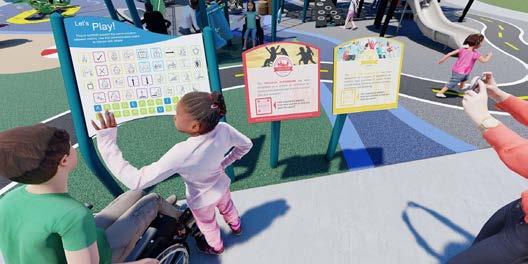
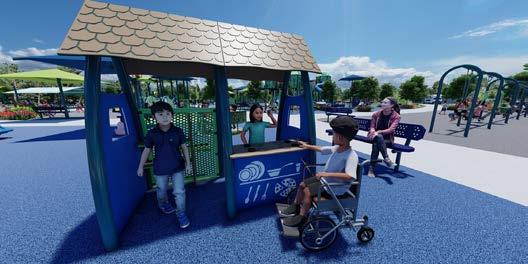
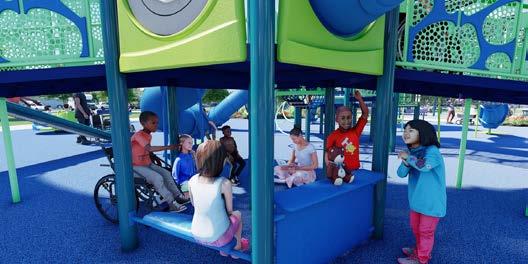
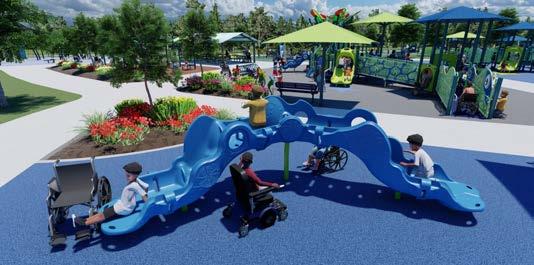
Inclusive Playground Best Practice Key
Accessible Routes & Safety Surfacing
Music & Sound
Opportunities for Expressive & Receptive
Language
Dramatic Play Elements
Looping Patterns
Jump-in Points
Defined Activity Settings
Ramp Access
Slides w/ Slide Transfers
Motion Activities w/ Inclusive Features
Cozy Spots
Seating & Areas for Adult Supervision
Graduated Levels of Physical Challenge
Accessible Upper Body Events
Cooperative Play
Half Activity Panels
Shade
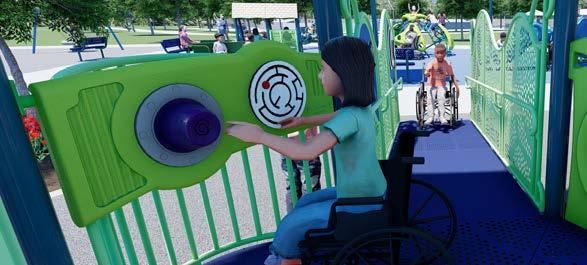
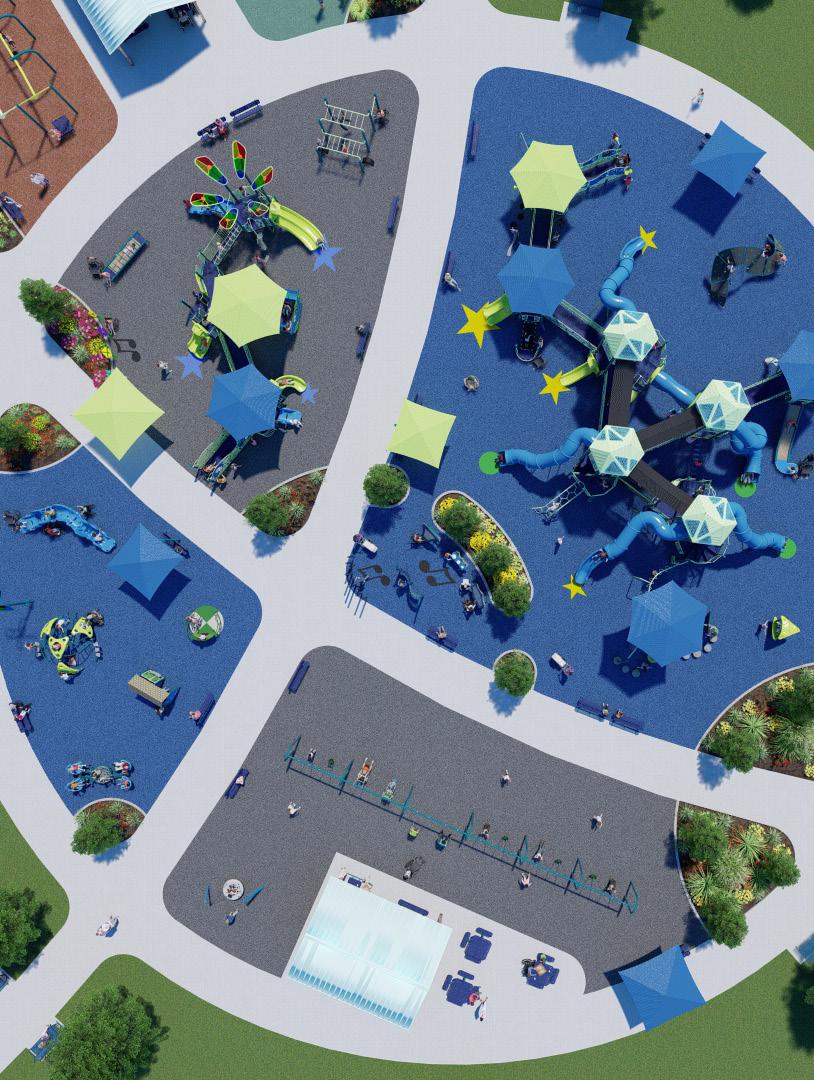
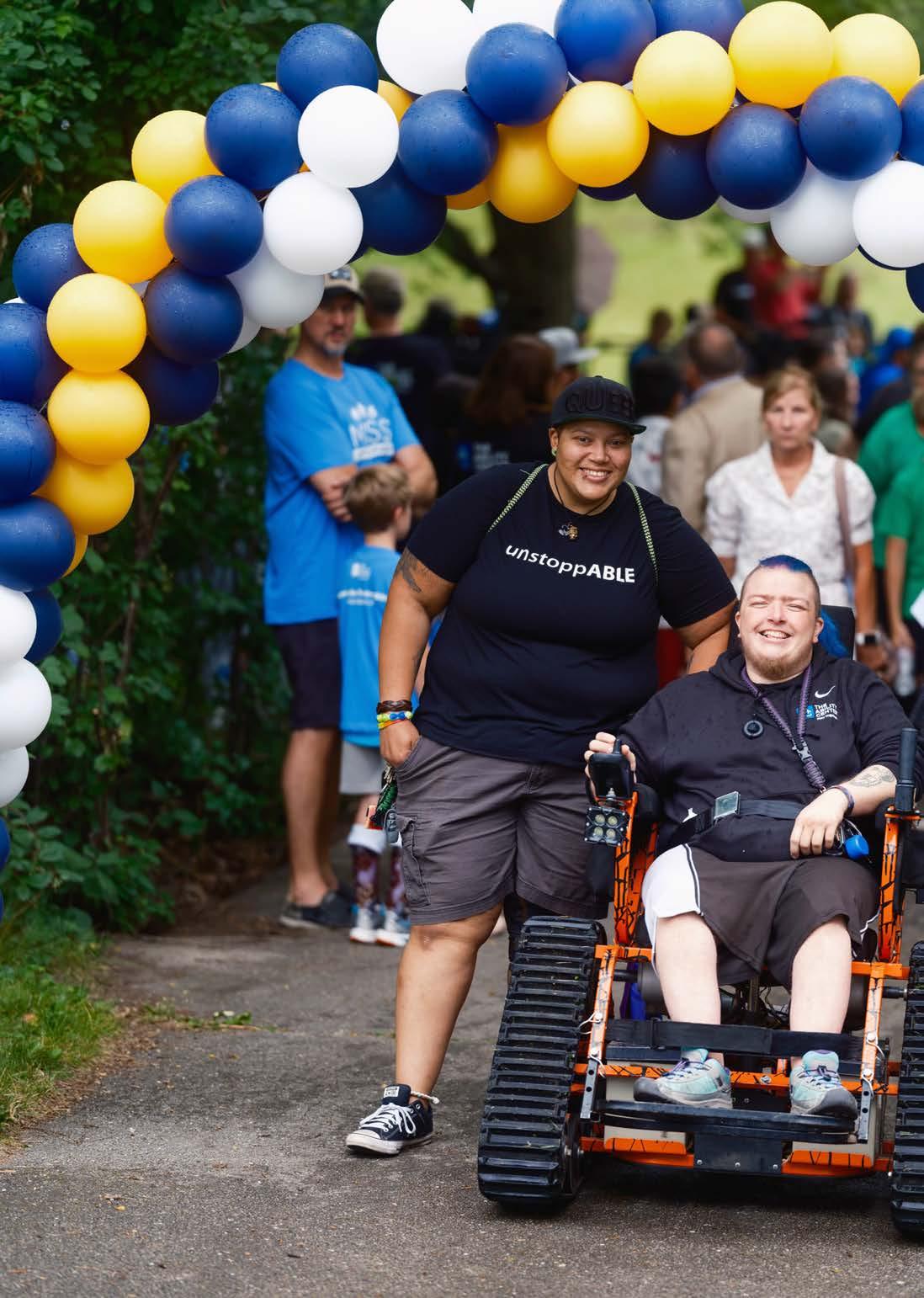

Think about everybody, all human experiences, and what people’s needs are as individuals.
That’s what being universal is all about.”
- Damian Buchman,
Executive Director, The
Ability Center
Celebrating Inclusion for the WHOLE COMMUNITY
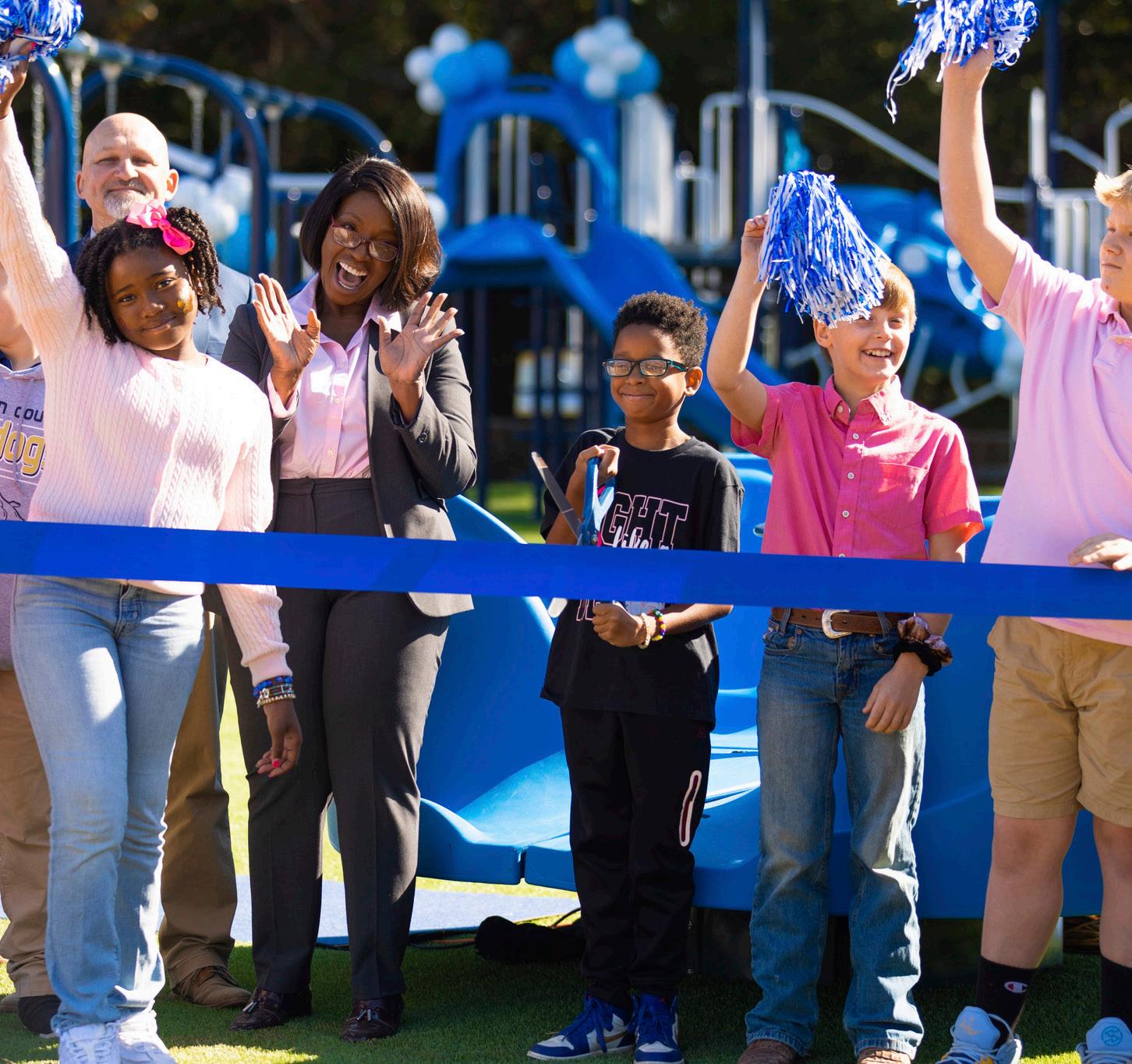
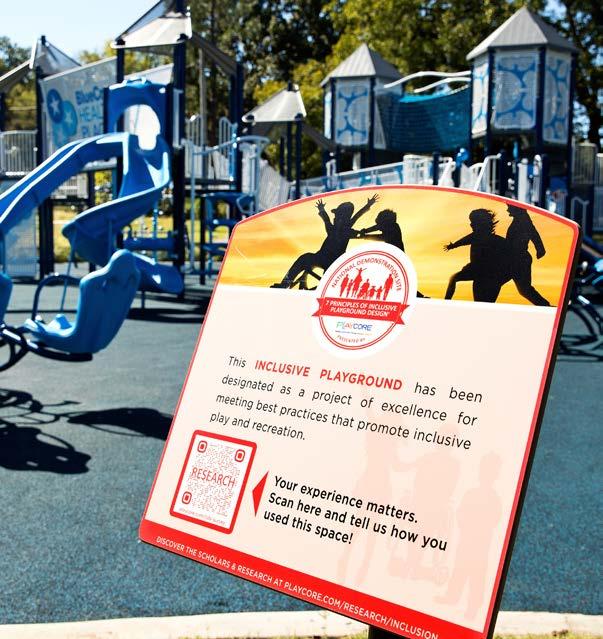
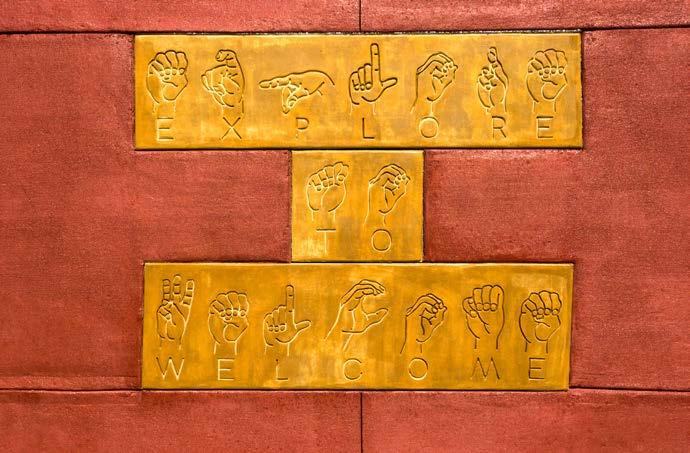
Planning an inclusive play destination begins with approaching the project understanding the developmental needs of the whole child, and the 7 Principles of Inclusive Playground Design® to inform the whole environment. What’s next? Maximizing the opportunity to engage the whole community for a truly inclusive experience! Make the case for inclusive play by following these steps to develop a comprehensive plan with community advocates, experts, and a variety of stakeholders.
Inspire
Communities that champion inclusive play make a fundamental statement about a community’s social values and commitment that every individual deserves the right to healthy play and recreation opportunities. By recognizing the diverse needs of society and taking innovative approaches to planning and design, community stakeholders embrace diversity, equity, and inclusion as part of their community culture and values. Inclusive play and recreation destinations offer a multitude of benefits that positively impact community outcomes, supporting diversity, fun, health and wellness, learning, friendships, social equity, physical activity, community engagement, selfdetermination, usability, awareness, empathy, and respect. Make the case for inclusion and fuel these conversations with passion and personalization.
Share
Sharing state, county, and local data is powerful when making a data-driven case for inclusive play and recreation destinations. Research and share relevant data that can validate the community’s needs and demonstrate why inclusion is critical to community health and wellness. Data about a community’s obesity levels, disability statistics, aging populations, and access to high-quality parks can help strengthen your case as you advocate for new or renovated park destinations.
Champion
Inclusive play and recreation brings communities together in a variety of meaningful ways while building social capital through planning and
engaging stakeholders. Community engagement should be prioritized and incorporated throughout the planning process as one of the most important aspects of your inclusive play project. Ensure you’ve asked for community input, addressed local priorities, created awareness, and enlisted community partners, volunteers, and potential funders who share your mission, purpose, values, and goals. Consider hosting events both in person and virtually, offer options on different days or times, provide necessary accommodations, and provide a broad way for individuals to contribute or participate. Be sure to recruit, invite, and include community members who have a variety of disabilities, care for individuals with disabilities, and/or work with or teach individuals with disabilities in these conversations. By maximizing the very process itself as a pivotal opportunity to bring stakeholders together, communitybased initiatives can refine planning so that it is user-focused, creates robust funding campaigns, designs unique play spaces that meet community goals, celebrates and capitalizes on community members’ talents and expertise, and implements a comprehensive plan for using and sustaining the space. Effective engagement helps ensure a wise investment and leaves a lasting legacy for years to come.
Equip
Educate and align members of your community and key stakeholders so that individuals involved in advocating for the project are relaying consistent messages that align with your purpose and goals.
Offer training and resources for committee members to gain confidence in relaying key information to potential funders, council members, partners, media, and others. For example, you may create a document or presentation with key information to share your unique story and script the message to the public or you may share resources about disability language or terminology that would be appropriate to use when referencing the project.
Implement
Validate and maximize your community’s investment by utilizing evidence-based design best practices for inclusive play. Adopting the 7 Principles of Inclusive Playground Design® is the ultimate demonstration of how your organization is committed to research-based decisions and sharing community outcomes. Often inclusive playgrounds are part of larger park settings that include a variety of amenities and settings. Careful consideration should be given to parking, pathways, surfacing, wayfinding, and amenities such as restrooms, benches, shelters, etc. found within activity settings beyond the playground. Inclusion and access should be top of mind in the master planning of park destinations that include aquatic play, dog parks, adult fitness parks, universal fields, and more!
Through thoughtful design, every play and recreation environment can offer more meaningful inclusive experiences for the diverse members of the community. From large destinations to urban pocket parks, from public to private schools, from early childhood settings to senior centers, from hospitality to rehabilitation hospitals, and small to large budgets, every play and recreation destination can tell a community’s unique story and provide the critical benefits of inclusion. Communicate the inclusive features and benefits of the park during meetings, grand openings, and celebrations, and through onsite signage, press releases, websites, and other marketing materials to further create awareness about your leadership and commitment to inclusion.
Activate
The best measure of an inclusive play destination’s success is how the community uses it. Thoughtful attention should be given in the early planning phases about how the space will be utilized after the project installation is complete. This can generate ongoing excitement and momentum, promote memorable experiences that support acceptance and belonging, and positively impact outcomes. Programming the space will maximize the overall value and increase social equity. Designing a space is a critical first step in creating spaces where rich and diverse play experiences can happen, but for communities to fully take advantage of the many benefits inclusive play
spaces have to offer, special events, activities, and programming should occur in and around them. An in-depth review of the literature indicates that social intervention strategies positively impact the inclusion of children with disabilities in play activities with peers and is cited as a key strategy to promote social inclusion. Children with and without disabilities need strategies that help them understand how to effectively play together. Research shows that disability awareness intervention has significant and positive effects on children’s understanding of and attitudes toward people with disabilities.39 Educators and programmers who use strategies to promote disability awareness provide children with the tools to ask questions, get accurate information, explore their feelings, and learn how to positively interact with their peers.40
Use inclusive play programs such as PlayCore’s inclusive play guidebook, 2 Play Together®: Fostering Friendships Through Inclusive Play, to teach and arm children with a greater understanding of how to include each other and play together successfully!
Celebrate
Through thoughtful design, every play environment can offer more meaningful inclusive experiences for the diverse members of the community. Don’t forget to celebrate the grand opening and ongoing utilization of the park as an effective strategy to continue to advocate for inclusion. Special events and data collection are effective strategies to document impact and continue to fuel ongoing stories about the benefits of this type of investment. Ongoing awareness can help community members and visitors alike engage in the space while also supporting future investments in other inclusive spaces.
USABILITY = More usable, by more people, to the greatest extent possible!

INSPIRE: Fuel with Passion & Personalization
CHAMPION: Plan & Engage Stakeholders
SHARE: Make Your Data-Driven Case
EQUIP: Educate and Align Advocates
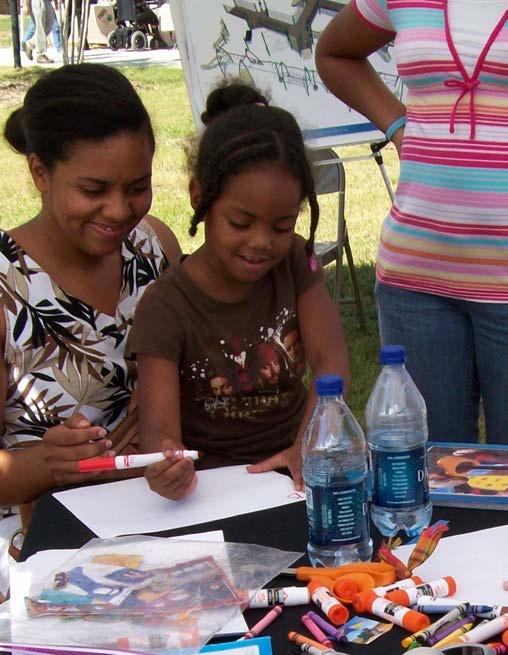
IMPLEMENT: Validate with Evidence-Based Design Practices
CELEBRATE: Document and Share Success
ACTIVATE: Plan for Inclusive Play Programming
Language Matters!
Create a positive, welcoming environment and raise everyone’s comfort levels when interacting with people who have disabilities. Use these disability terminology tips to raise awareness and champion inclusive programs and spaces in your community!
Disability Language Tips:
• A simple approach is to use person-first language. This puts the person before their disability to recognize that the person is not defined by their disability or condition, for example ‘a person with a disability’.
• An important exception to the rule of person-first language is Identity-first language. This is a way some individuals with disabilities prefer to emphasize what they consider to be an inherent part of their identity. In this case, a person may choose to put their condition or disability first as a positive label, for example, ‘autistic person’.
• Language should focus on the abilities of the individual and the accommodations that support them.
• Avoid making statements that reinforce negative stereotypes or that generalize characteristics of individuals with specific disabilities. No two individuals are alike.
• Only refer to the person’s disability if it is relevant.
• Language is complicated and always evolving. The language you choose to use may depend on your audience, whose experience you are trying to capture, and to honor the individual’s unique language preferences and rights to decide how they wish to be described.
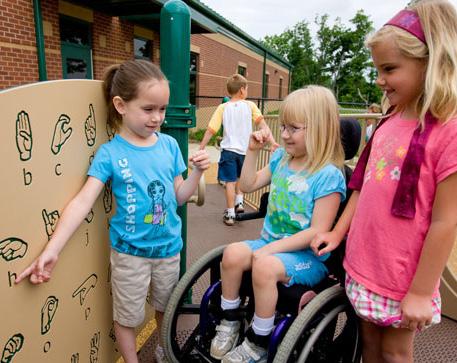
Disability Language Examples
Do Say
A person with a disability, special needs
An individual with Down syndrome
A person with autism or autism spectrum disorder is a safe bet, however many in the autistic community strongly prefer identity-first language, such as autistic people
People who use wheelchairs, other mobility devices, adaptive equipment
People with a communication, language, or speech disability
People with cognitive, intellectual, learning, or developmental disabilities
Person with traumatic or acquired brain injury
Child who is non-disabled or children without disabilities
Person with a congenital disability
People who are deaf (use with profound hearing loss), have a hearing loss, or hard of hearing
Person with physical disability
Persons of short stature
People with emotional or psychiatric disabilities
People with cerebral palsy, autism, diabetes, Tourette syndrome, dyslexia, epilepsy
People with health/medical needs or specific related conditions
A person who is blind, has low vision, or has a vision disability
Instead of
Handicapped person, disabled individual, special needs child
A Down’s child, Down’s syndrome
Asperger’s syndrome
A person confined/bound to a wheelchair, wheelchair-bound
People who are nonverbal, can’t communicate/talk, have a speech impairment or disorder
Mentally challenged, mentally retarded, slow, low-functioning
Brain damaged
Healthy, able-bodied, normal, typically developing
Birth defect, abnormality
The deaf, deaf person, deaf and dumb, hearing impaired
Person who is crippled, handicapped, deformed, has an abnormality, or that is physically challenged
Midget, dwarf, vertically challenged
The mentally ill, emotionally disturbed, bipolar, crazy
Suffering from, afflicted with, victim of, or stricken with cerebral palsy, autism, diabetes, Tourette syndrome, dyslexia, epilepsy, etc
Medically fragile, sick
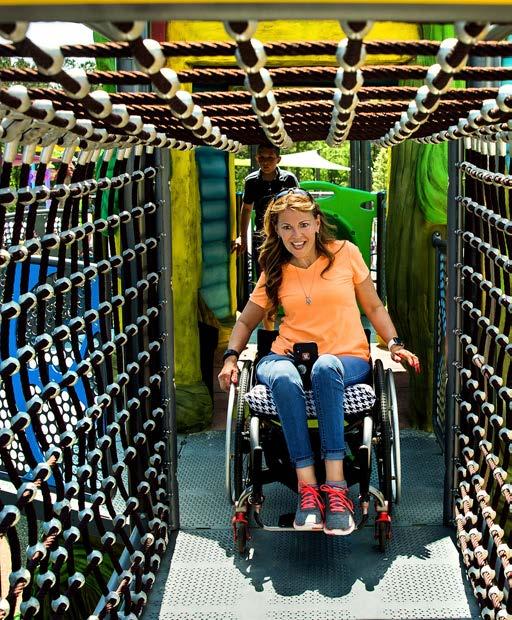
Other Language Considerations:
Therapies vs treatments
General education vs regular education
Students receiving special education services vs special education students
Service dog or assistance animal vs seeing eye dog
Accessible bus, parking, or restrooms reserved for people with disabilities vs handicapped parking, restrooms, bus
The playground structure is not accessible/inclusive vs the individual can’t access the structure because they use a wheelchair (place the issue and emphasis on the issues related to the design of the environment, not the individual)
The blind, blind person, visually impaired
For more disability specific etiquette tips and resources, visit the United Spinal Association www.unitedspinal. org/disability-etiquette.
Expanding Inclusion Across Park Settings for All Visitors
In order to create inclusive community park experiences, considerations must include the needs of the whole environment and the whole community. Use this comprehensive park checklist to thoughtfully create a welcoming atmosphere and outdoor play and recreation destinations that are more usable, by more people, to the greatest extent possible.
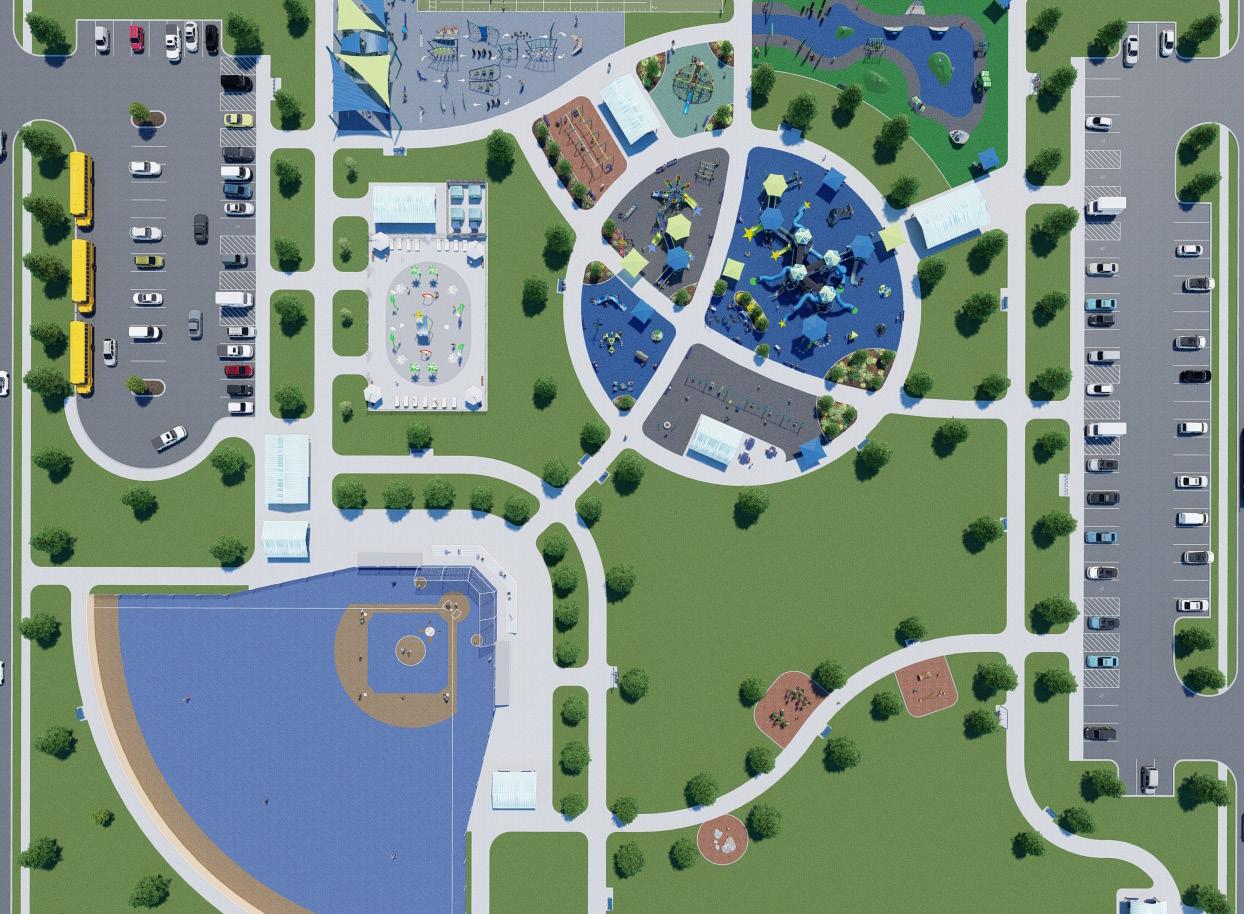
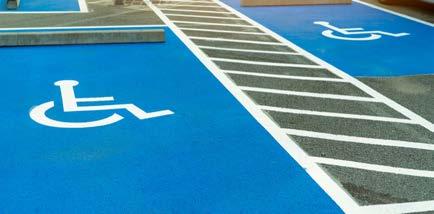
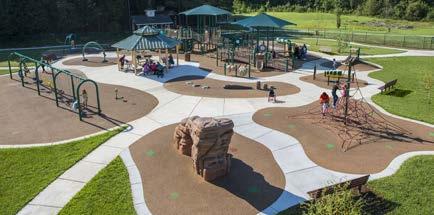
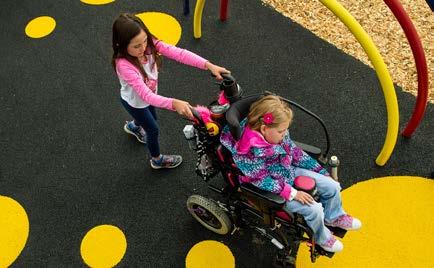
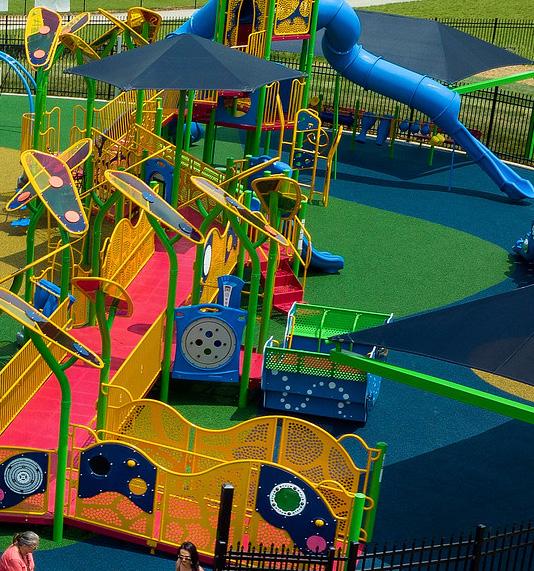
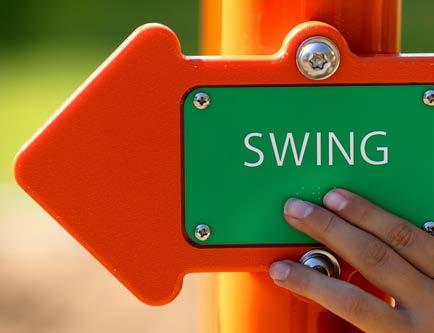
1. Parking
• More than the minimum required accessible parking spaces that include van spaces with wider access aisles and appropriate signage.
• Parking areas conveniently located to create an accessible route to the park entrance(s).
2. Pathways
• Firm and stable surface materials along accessible connecting routes (concrete, asphalt, or boardwalk preferred).
• Railings and edge protection on routes with running slopes greater than 5% or where there is a drop off.
3. Surfacing
• Unitary, fall attenuating safety surfacing, such as poured-in-place rubber provides the most consistent surface for accessibility in play and recreation environments.
• Various surface materials, textures, or colors to provide cues to help visually organize the environment so that it is easier to navigate and understand.
4. Playgrounds
• Robust assortment of activities that thoughtfully meet the physical, social-emotional, communication, sensory, and cognitive needs of all people, including those with disabilities.
• Go beyond the minimum ADA Standards for Accessible Play Areas to meet the 7 Principles of Inclusive Playground Design®, the only evidence-based design best practices for inclusive play environments. Visit playcore.com/inclusion to request the design guidebook.
• Selection of playground equipment that has intentionally been designed to provide additional gross motor and fine motor supports for more active, independent play.
• Accessible routes to, around, and on the play equipment, using unitary safety surfacing and accessible ramps.
5. Wayfinding
• Accessible visual signage that identifies accessible routes and facilities within the site.
• Picture symbols to identify equipment with raised images, words, Braille, etc.
• Bilingual options on signage, QR codes with videos, or options to download in different languages.
• Detailed website information about the park and inclusive features.
• Tactile 3D site models where possible.
• Various surface material textures or colors to provide behavioral cues and help visually organize the environment so that it is easier to navigate and understand.
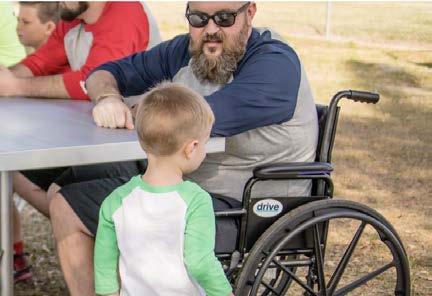
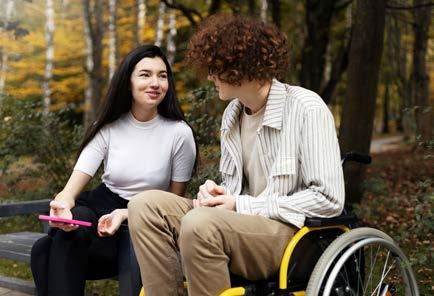
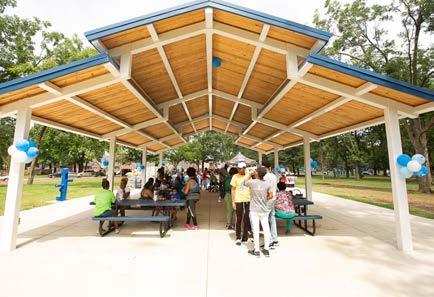
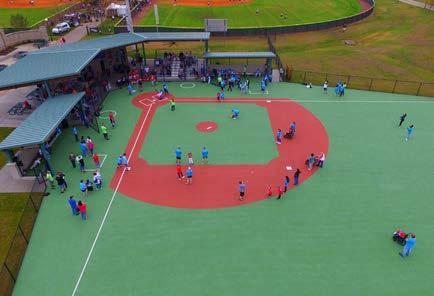
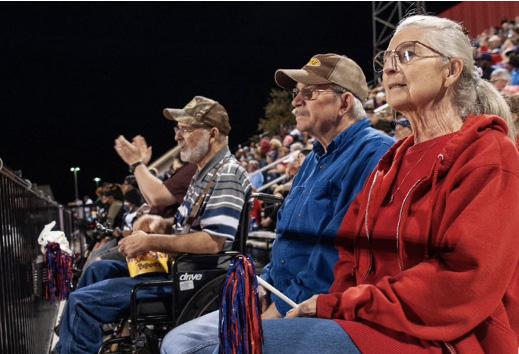
6. Site Amenities
a.
Accessible Toilet and Bathing Facilities
• Accessible sink(s) with touchless operation.
• Paper towel/hand drying features within accessible reach ranges.
• Family/Unisex restroom with at least one adult size changing table
• Signage with Braille characters and raised pictorial symbols at toilet room doors.
b.
Benches/Sitting Area
• Adjacent accessible wheelchair spaces/areas near benches with a firm and stable surface.
• Shade trees or shade structures surrounding seating areas to increase comfort.
• Back and armrests on benches when possible.
• Benches with charging ports for personal electronic devices and mobility devices.
c.
Picnic Tables
• Tables positioned on an accessible route and protected from weather by using shade or shelters where possible.
• Wheelchair spaces integrated into picnic tables which allow space for multiple individuals that use mobility devices to comfortably gather at the same table and offer choices of where to sit.
d.
Shade and Shelters
• A combination of integrated shade (manufactured) and natural shade (tree canopy) offers relief from elements and increased comfort.
• Shade shelters and pavilions on an accessible route and provide a firm and stable surface throughout.
e.
Drinking Fountains & Water Bottle Filling Stations
• A wheelchair accessible and a standing height drinking fountain provided at each location.
• Stations to include accessible features such as switch/bar or automatic touchless sensors.
f.
Universal Fields
• Each area of sport activity is connected with at least one accessible route.
• Unitary surfacing on fields that permit wheelchair access and play.
• Wheelchair accessible dugouts with a wheelchair space adjacent to team benches.
g.
Customer Service Areas
• Wheelchair accessible sales and service counters no higher than 36 inches.
• Accessible point of sale systems.
• Condiment stations within accessible reach ranges.
• Menus with large print, pictures, and Braille.
h.
Bleachers/Spectator Seating
• Wheelchair spaces integrated within each spectator seating area.
• Circulation paths are behind the designated wheelchair spaces to avoid obstructing the view.
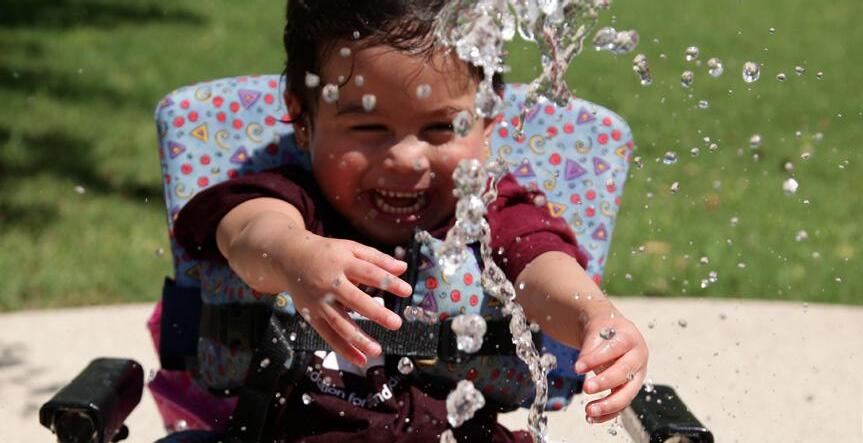
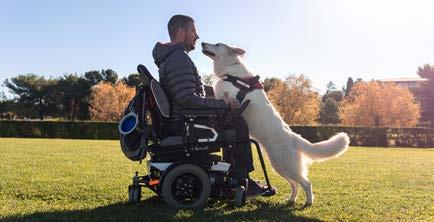
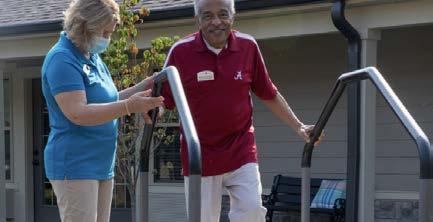

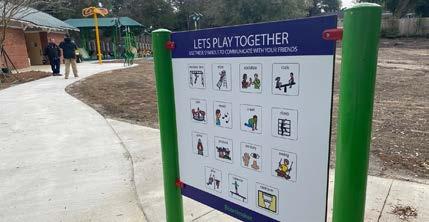
i. Aquatic Play Environments
• Aquatic access wheelchairs of varied sizes for adult and child visitors are available to use.
• Changing/bathing facilities include an accessible changing bench.
• Showers provide a handheld shower device and a shower bench for transfer in each accessible shower.
j. Adult Outdoor Fitness Parks
• Universally designed equipment that provides individuals using mobility devices the opportunity to engage in aerobic and muscle strengthening activities alongside others.
• Accessible routes of travel to and around the equipment and include safety surfacing when appropriate.
• Signage with simple graphics and verbiage for instruction or QR codes to provide video instruction.
k. Musical Instruments
• Musical elements installed on an accessible route with a hard surface, and at an appropriate height so that individuals of various sizes and individuals using wheelchairs can comfortably approach and reach the activity
• Adapted mallets to promote independence and usability for individuals who need additional fine motor support.
l. Dog Parks & Pet Amenities
• Pet waste, water stations, and gate latches are positioned at an accessible approach, reach heights, and operation for individuals using mobility devices.
• Accessible route and surface to and throughout the environment.
m. Communication Boards
• Opportunities for visitors to communicate through pictures and/or symbols that are easy to recognize, paired with the written word, and are organized using color-coding to represent different parts of speech.
• Communication boards installed on an accessible route with a hard surface, at an appropriate height so that individuals of various sizes and individuals using wheelchairs can comfortably approach and point to or gaze at picture symbols.
• Printed communication boards for download or available to check out for visitors and/or their caregivers to use in preparation for and during their visit.
`
Special Events & Programming
• Activities located on accessible routes and with accessible surfacing.
• Accessible portable toilet facilities and parking at temporary events.
• Sign language or bilingual interpretation at special events.
• Special events designed and marketed to ensure people of all abilities can play and interact meaningfully.
• Adaptive equipment such as all-terrain wheelchairs, adaptive swing harnesses, adaptive switches for play panels that offer switch capability, and adaptive sports equipment available for visitors to check out or to use during programs/events.
• ‘Sensory Kits’ that include noise cancelling headphones, fidget toys, communication board or picture symbols, or other adaptive tools available for visitors to reserve/check out.
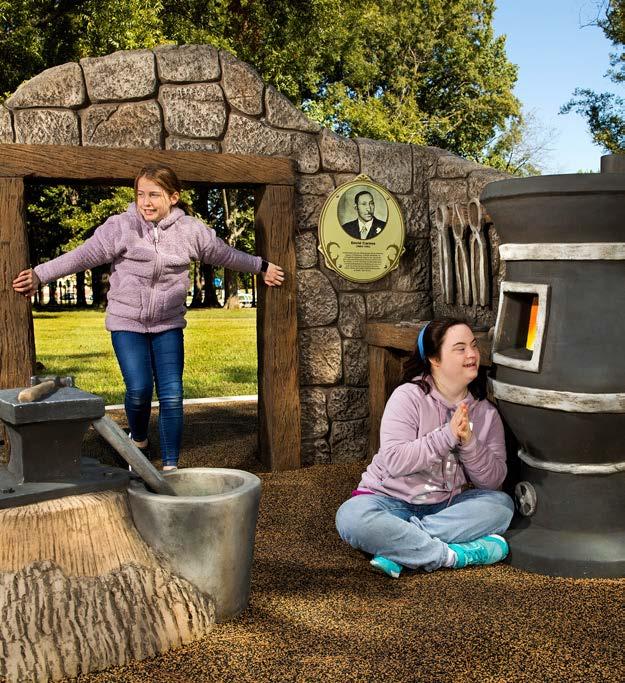
Inclusive Play Programming
Inclusive Community:
When planning an inclusive destination, it is important to consider the various ways the community can program the space by marketing it as a community resource and activating it through a variety of special events, after school programs, summer camps, and more. Programming can greatly increase the usage of the space and further promote social equity in your community. Schools, parks, and recreation programs can support inclusion by intentionally bringing children with and without disabilities and their families or caregivers together through unique playground programming and events.
Often children with and without disabilities need to better understand how to play with their peers successfully, even if there are differences in how others might play, communicate, or participate. Educators and programmers should use intentional strategies to help children with and without disabilities understand how to successfully play together and equip children with the tools to ask questions, get accurate information, explore their feelings, and learn how to positively interact with their peers.41 High-quality inclusive play programs include access, support, and participation by using a variety of instructional approaches to promote engagement in play and learning activities to create a sense of belonging for every child.42 The 2 Play Together® program was specifically designed for educators and recreation
programmers to help children of all abilities gain awareness of their individual strengths and challenges, adjust their play when needed to ensure that they can include one another, and utilize strategies to create a deeper sense of belonging. The fifteen inclusive playground activities in the resource teach children how to celebrate similarities and differences, support character education, and offer tips for programmers to model strategies and create awareness.
With thoughtful planning and programming, inclusive play environments that align with the 7 Principles of Inclusive Playground Design® can be transformative. These destinations and experiences create awareness, break down barriers, and foster friendships to create communities that care.
Program Highlights
• Disability Awareness Resources
• Character Education Tips
• Inclusive Playground Activities for PreK-5th Grades
• Inclusion Resources for Educators, Programmers, & Advocates
• Supportive Research
Download your copy of 2 Play Together Playground Programming to Foster Friendships Through Inclusive Play by visiting playcore.com/inclusiveplay

Playground Activities that Promote Character Development
A balance of free, guided, and facilitated play is important for child development. The inclusive playground activities in 2 Play Together are not designed to replace children’s free play on the playground, but can provide opportunities to promote character development and create a sense of belonging for all children, regardless of ability, at your school, camp, place of worship, park, or special event. Each activity card indicates the appropriate grade level, focuses on a disability awareness category, and promotes a specific character education trait.
Each activity card includes:
1. AGE-APPROPRIATE ACTIVITY AND DISABILITY AWARENESS CATEGORY:
The Inclusive Playground Activities are divided into three sections, each containing five activities that promote awareness of physical, social-emotional, sensory, cognitive, and communication disabilities or grades PreK-1st, 2nd-3rd, and 4th-5th.
2. INTRODUCTION:
The introduction provides facilitators with key information to promote awareness about the specific disability category that the activity addresses. By promoting understanding, facilitators can encourage inclusion and provide and model strategies to show children can play with each other.
2 3 4 7 5 6
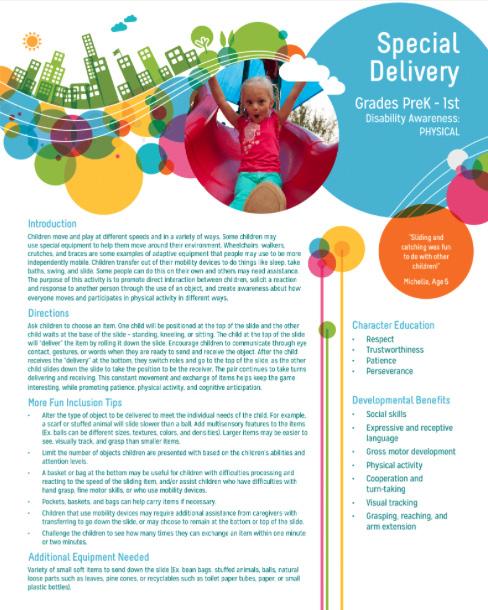
3. DIRECTIONS:
Simple directions for facilitators to use that introduce activities to children, encourage inclusive play, and are easy to follow and implement.
4. MORE FUN INCLUSION TIPS:
Most importantly, each activity provides several additional activities that further address individualized needs and provide various levels of challenge for different players. These tips also offer adaptations and modifications to address the unique needs of every child and expand learning for all children through inclusive play.
5. CHARACTER EDUCATION:
Each activity is designed to promote important character development traits that can tie into play and learning experiences.
6. DEVELOPMENTAL BENEFITS:
The developmental benefits for children of all abilities occur naturally through each inclusive play activity and are located on the sidebar of each activity card to reference.
7. ADDITIONAL EQUIPMENT NEEDED
Some of the activities encourage the use of additional equipment or loose parts to further support social interactions between peers.
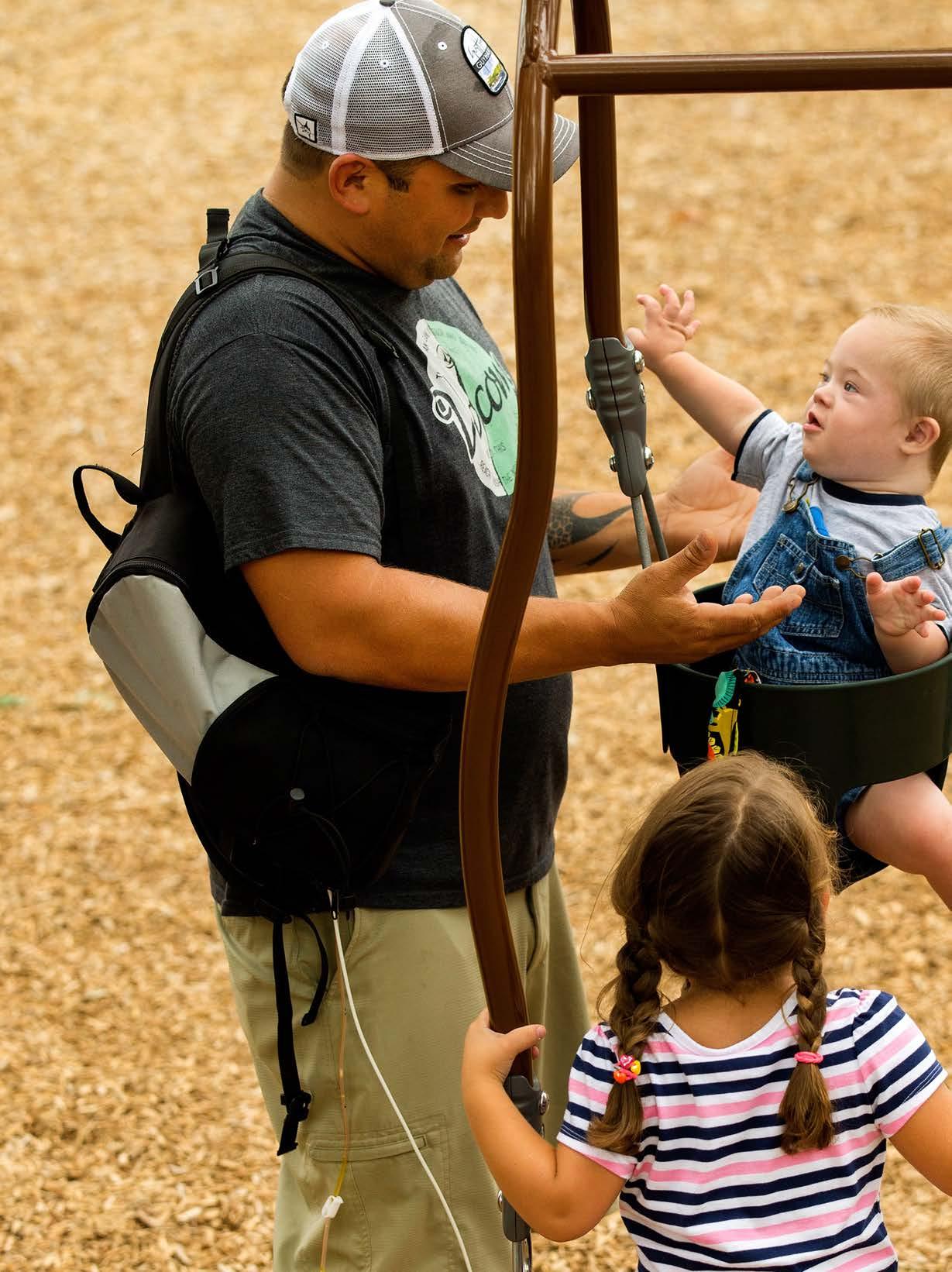

Providing intergenerational, inclusive play ensures that all people experience the satisfaction of contributing to meaningful play and reap the lifelong developmental, physical, and social benefits of inclusion.”
- Dr. Keith Christensen, RLA, Ph.D Utah State University
Projects of Excellence
Inclusive Play Outcomes Demonstrate Impact
The research is clear! Thoughtfully implementing the evidence-based design best practices outlined in the 7 Principles of Inclusive Playground Design® positively impacts health and wellness. Data and visitor sentiments collected across hundreds of inclusive playgrounds demonstrates that advocating and investing in inclusive play and recreation environments is critical for children, families, and communities.
National Demonstration Sites for Inclusive Play
Join us in celebrating inspirational case examples of communities that have turned research into practice to create high-quality inclusive play destinations. The projects of excellence on the following pages are stellar examples of National Demonstration Sites that have embraced and implemented the 7 Principles of Inclusive Playground Design®. These visionary leaders and inclusive play champions have thoughtfully implemented best practices during the planning, implementation, programming, and sustainability phases of the development of their inclusive play destinations. Projects recognized as National Demonstration Sites inspire others and demonstrate positive community outcomes that support health and wellness and enjoy the benefits of location specific data reports that showcase the outcomes and impact of their parks to fuel advocacy efforts.

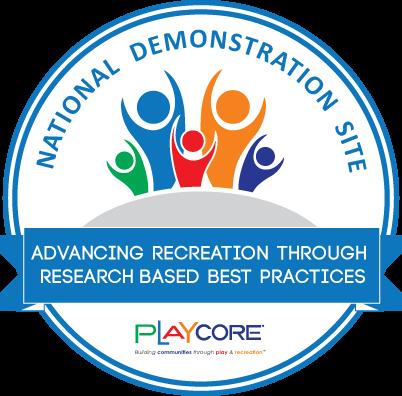
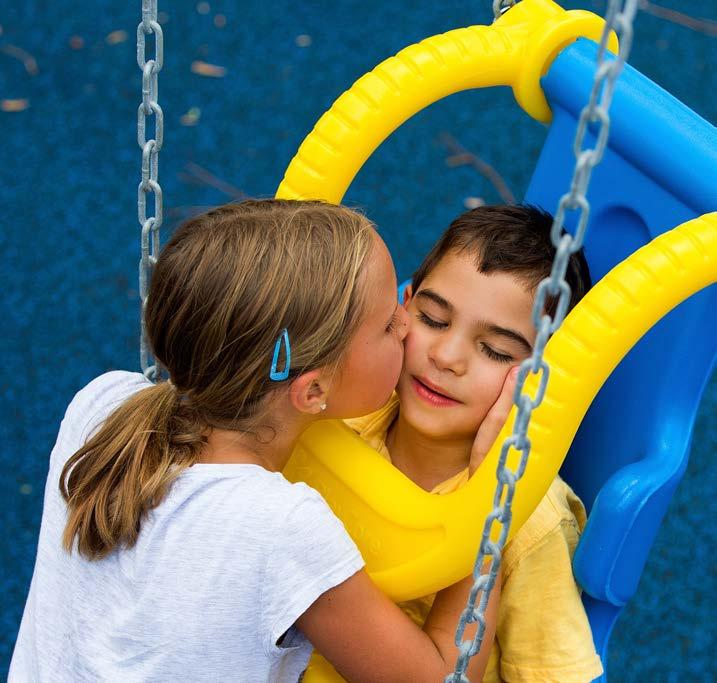
Data collected at PlayCore’s National Demonstration Sites for
Inclusive Play:
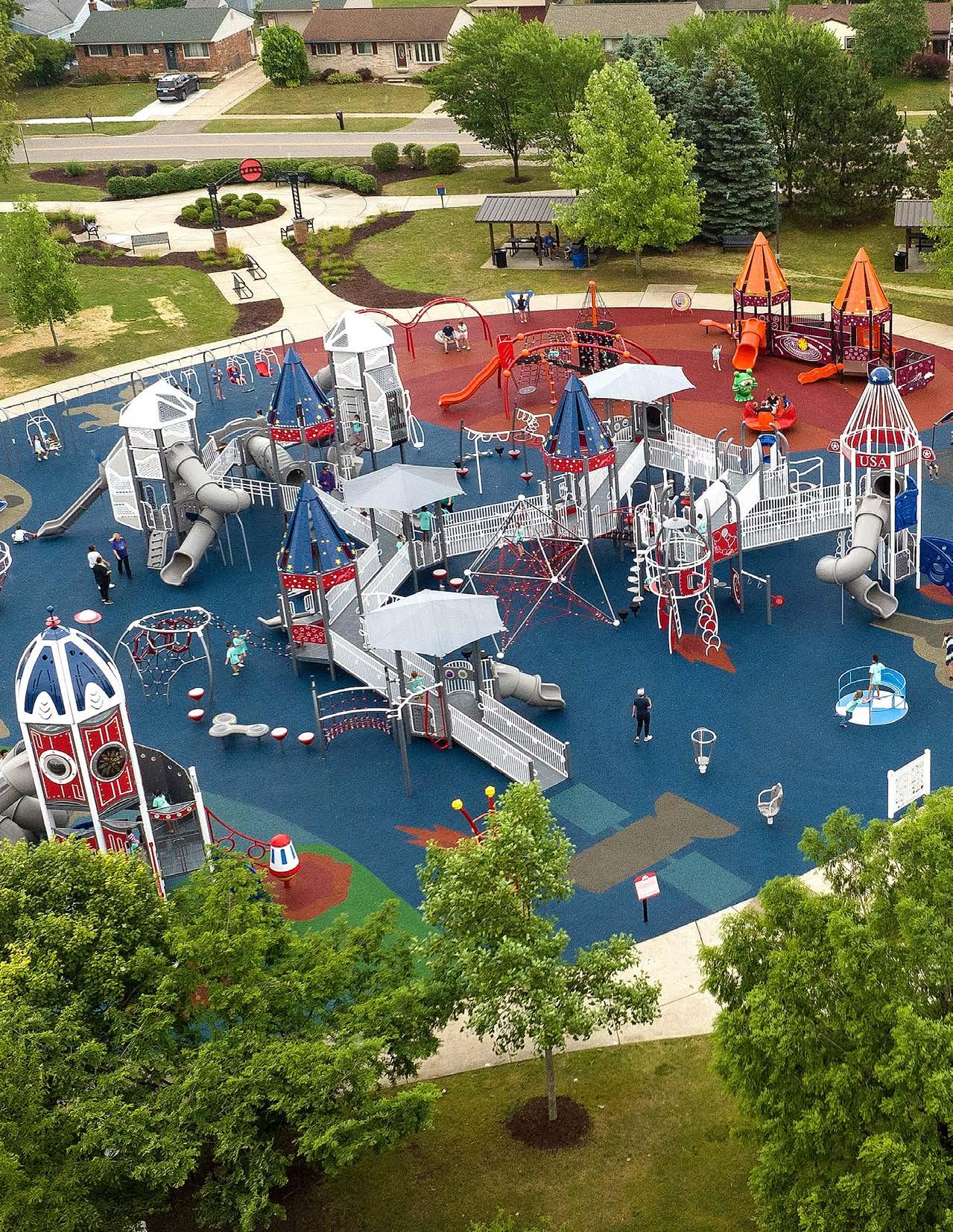
ENCOURAGE REPEAT VISITATIONS
96% of site visitors say they will return again in the new future.
ENCOURAGE FREQUENT VISITATIONS
46% visiting more than once a week.
DEMONSTRATE HEALTH & WELLNESS
98% of site visitors were active.
PROMOTE RECOMMENDED PHYSICAL ACTIVITY
90% of site visitors are active at the site for 30 minutes or longer.
CLAIM VISITOR SATISFACTION
98% of site visitors are satisfied with their visit.
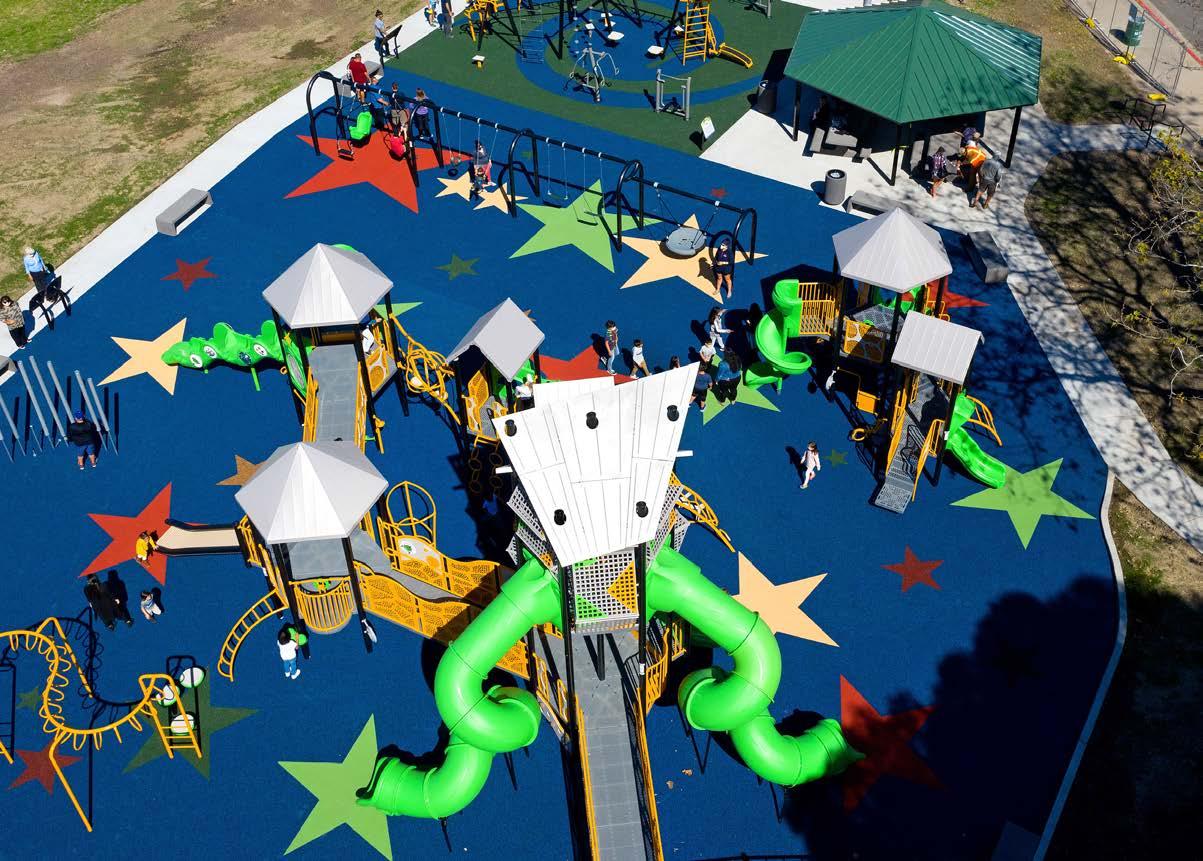
National Demonstration Site Case Example:
Beattie Park | Lompoc, CA
The City of Lompoc is recognized as a great place to live, work, and play. Beattie Park boasts 50 acres and offers fantastic views of the Lompoc Valley. The park features an inclusive playground, picnic area, basketball courts, a multi-purpose field, and an urban forest preserve and trail. The urban forest preserve includes “Recognition Grove” where many local leaders have been recognized with trees planted in their honor or memory for the active role they have played in improving the quality of life in Lompoc Valley.
The City of Lompoc was an awardee of the California Park and Recreation Society’s Statewide Healthy Play & Recreation Initiative. Beattie Park was recognized for implementing best practices for inclusive play, promoting youth fitness, and adult outdoor fitness. Data indicates that Beattie Park is a multigenerational destination, with 31% of visitors reporting three or more age groups in their party. The park attracts large numbers of people, with 47% of site users visiting in groups of 5-10 people and they most often cited visiting the park for
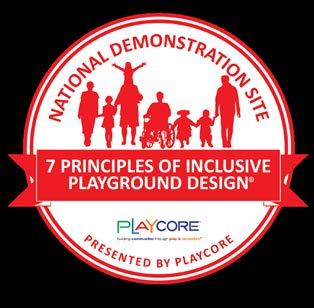
physical and social-emotional health reasons; 53% of site visitors identify as Hispanic, Spanish, or Latino.
Mario Guerrero, Park and Recreation Manager, and his team recognized the value of the data and sentiments collected at the park from user surveys. After reviewing the outcomes in their site-specific impact report, they decided to share the results at Lompoc’s City Council meeting as part of their proclamation for Parks and Recreation Month. This helped make an undeniable case for parks and recreation and resulted in securing funding for more high-quality parks in their community.
Beattie Park Visitor Outcomes
98% are satisified
100% plan to return
86% staying longer than 30 minutes
100% active during visit
52% visiting more than 1x per week
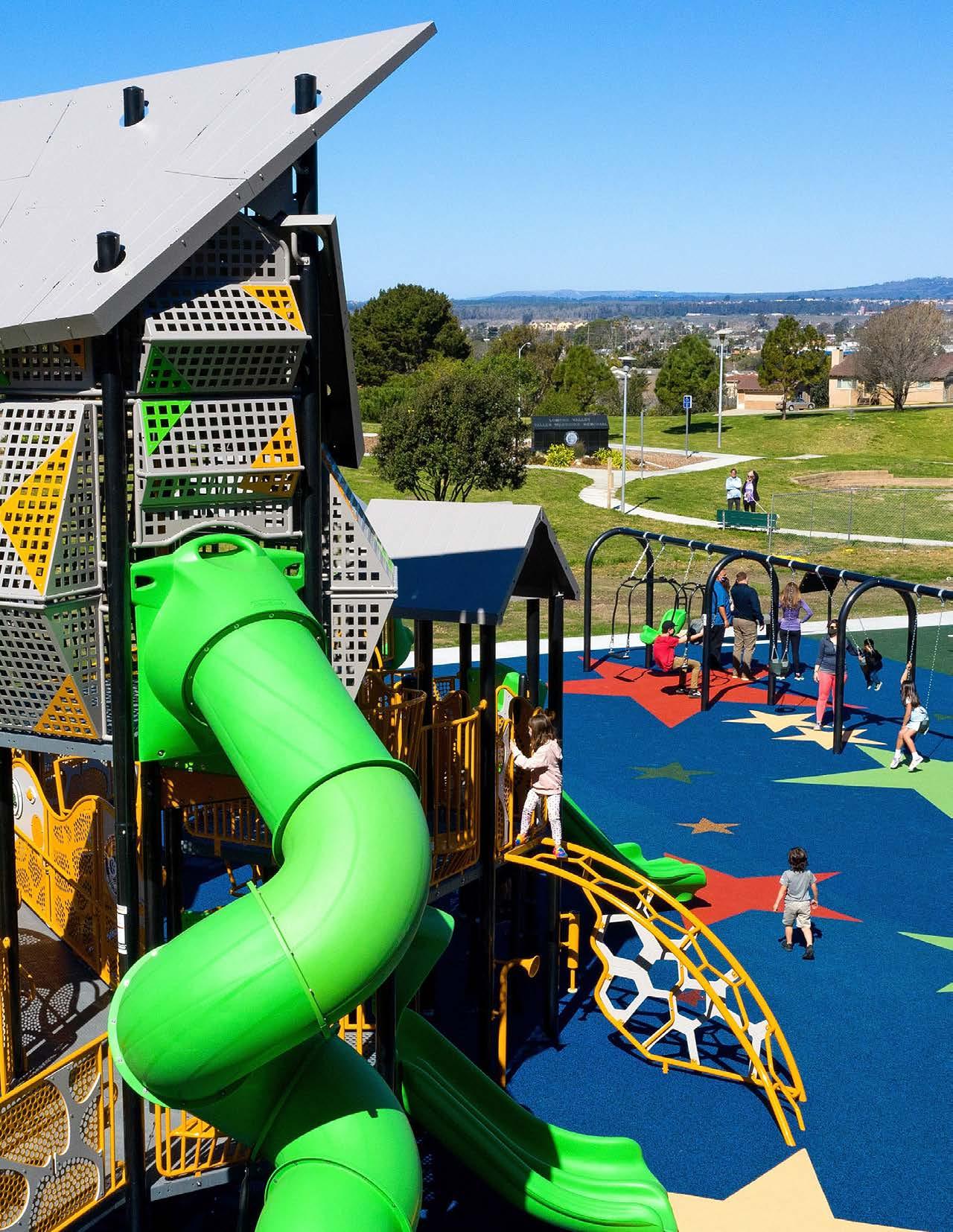
This inclusive playground is a fantastic place to take children of all ages! My daughter can run around and can interact with children of all abilities, teaching her to be more inclusive and self-aware.”
- Park Visitor
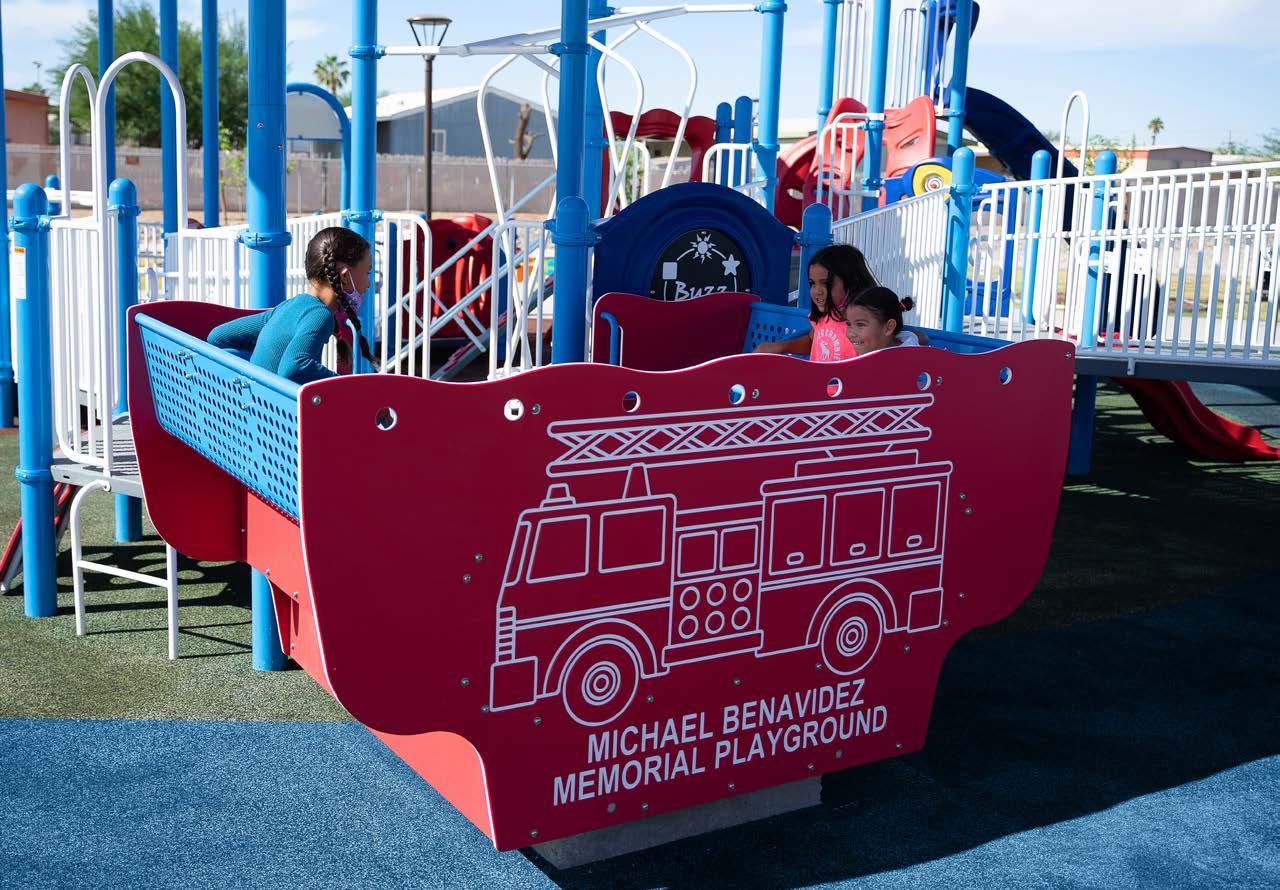

National Demonstration Site
Case Example:
First Responder’s Park | El Centro, CA
Located in the Imperial Valley adjacent to Fire Station No. 3, First Responder’s Park includes the City of El Centro’s first fully inclusive playground as part of a three-acre park destination. It features themed components to express gratitude to first responders, especially to Michael Benavidez who lost his life in the line of duty while serving his community. In addition to the playground, outdoor adult fitness equipment encourages visitors ages 13+ to stay active & healthy.
“I felt that it was necessary to honor these brave men and women who get up every morning or night and serve the community. We wanted to bring something viable to this city for our children and future generations to enjoy,” shared Mayor Edgard Garcia.
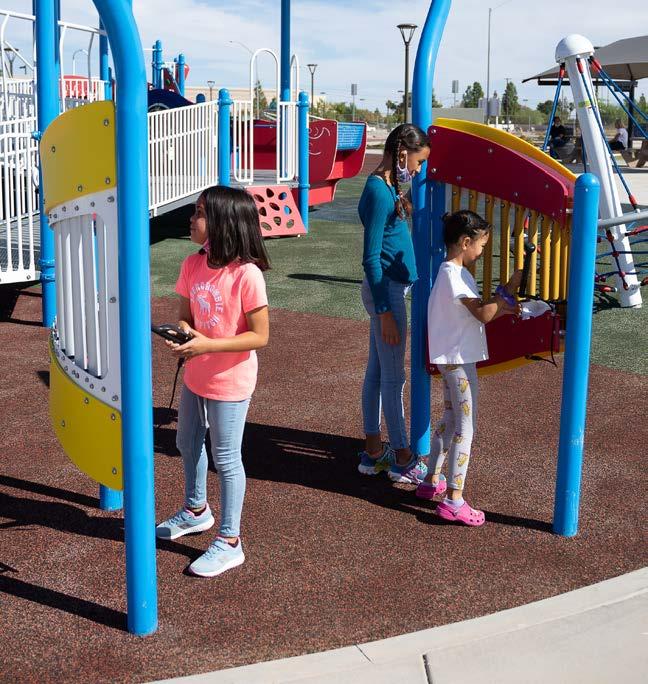
First Responder’s Park Visitor Outcomes
100% are satisified
100% plan to return
90% staying longer than 30 minutes
100% active during visit
61% visiting more than 1x per week
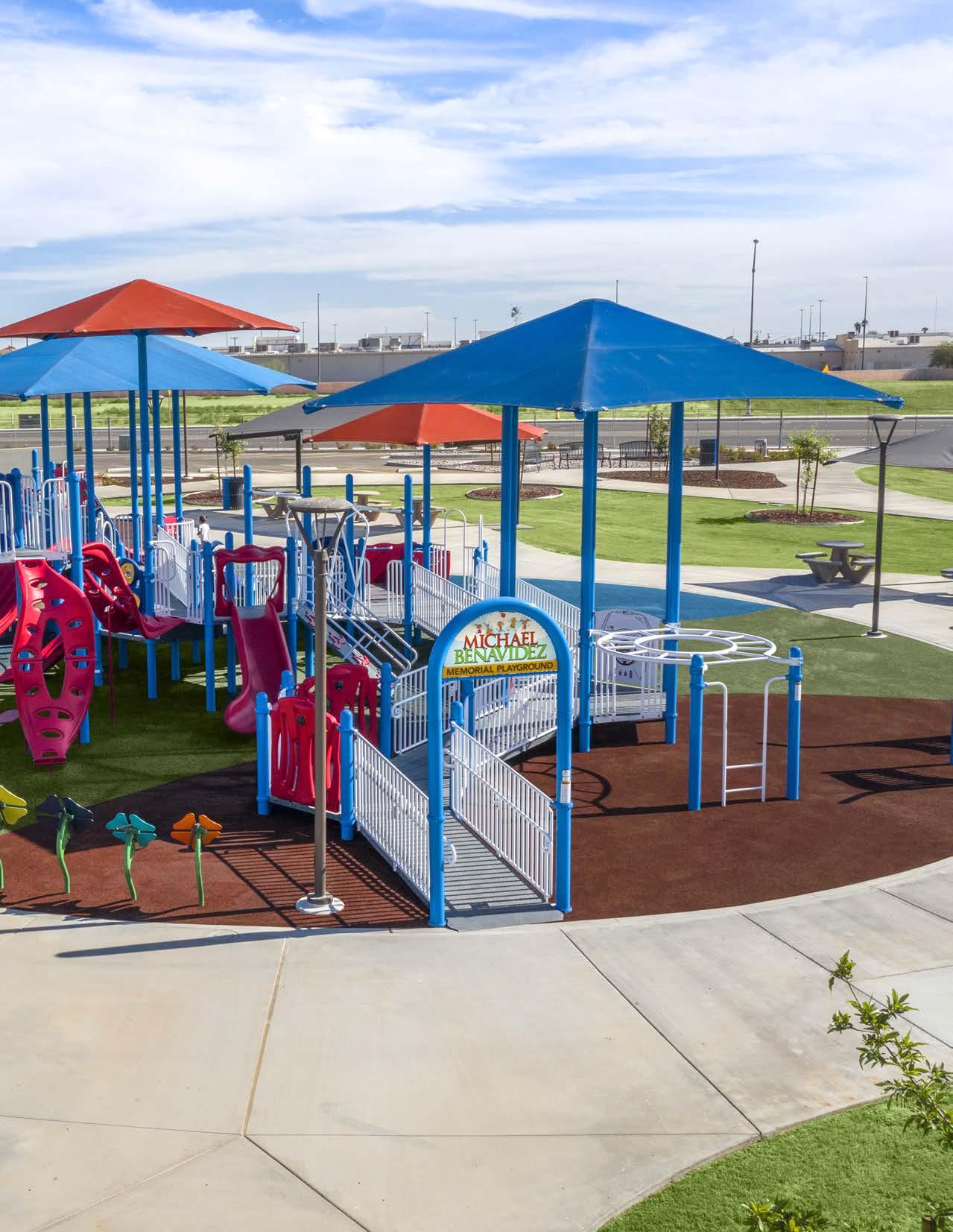
My children were able to interact with kids with disabilities and the lessons and compassion they learned today was remarkable!”
- Park Visitor
Call to Action: Adovcating for Inclusion in Your Community
Want to bring more inclusive play to your community? Wonder how to get started? Need help with inclusive playground design? Curious how others are realizing the impact of their initiatives? Follow the steps below and read on to learn how PlayCore’s Center for Outreach, Research, and Education (CORE) can help align inclusive play and recreation spaces to improved Community Vitality with a variety of scholarly resources and tools, an insatiable desire to document data storytelling to defend and grow inclusive play initiatives, and a massive heart for bringing people of all abilities together in play.
1. Build Your Case
Gather supporting data and build your case across a broad network. Begin by documenting how opportunities to participate in inclusive, equitable play experiences throughout one’s life is a right that enhances the quality of life for children, families, and our greater society. Take steps to understand how disabilities are represented in your community demographic. Seek out what recreation opportunities, if any, are currently available and how they are meeting the diverse needs of all people. You may consider interviewing people of all abilities at this stage to understand how and if they are engaging with existing services and to get feedback on what an inclusive play and recreation environment could mean to the community.
2. Educate and Engage Community Advocates
Once your research is underway, encourage others to advocate and invest in the process. Meet with community stakeholders, including people with and without disabilities, to address specific needs and identify opportunities. Organize your presentation around the evidence-based design best practices in this publication to demonstrate a commitment to high quality environments and as a framework to categorize public feedback. Next, create
an interdisciplinary committee of community stakeholders to help elevate and build momentum for the project. Mobilize partners, champions, and potential funding opportunities. Continue to promote through marketing and events to build momentum, sustain visibility, and demonstrate progress.
3. Turn Research into Practice in Planning, Design, and Use
The 7 Principles of Inclusive Playground Design are a valuable tool to help ensure the space you’ve worked so hard to plan and fund is truly a beacon of inclusive play. Utilize the strategies outlined throughout this book and in the next two sections to ensure your space meets the needs and strategies of diverse people. In addition, thinking strategically about how your inclusive play space can be programmed can greatly influence the design and increase the usage of the space.
4.
Become a National Demonstration Site
Intentionally aligning to scholarly design criteria provided in the 7 Principles of Inclusive Playground Design ensures that your community can maximize the value of your investment by implementing best practice research to activate play and recreation destinations. It can also act as a data storytelling strategy to report and accelerate impact through strategic data gathering, translation, and reporting of both qualitative and quantitative data gathered at the site. Learn how to demonstrate impact through data services and receive site-specific reports to share and showcase impact on community vitality. By mobilizing resources and aligning advocacy efforts, we can raise awareness, break down barriers, foster friendships, unite communities across our nation, and achieve amazing outcomes. PlayCore’s Center for Outreach, Research, and Education (CORE) provides a wealth of resources to promote Community Vitality and to support the implementation of inclusive play projects.
Ready to Get Started?
PlayCore’s Center for Outreach, Research, and Education (CORE) is here to help you execute inclusion best practices. We are committed to investing in validated research, sharing evidence-based resources, and building informed advocacy to help empower communities to create high quality play, recreation, and outdoor spaces. Learn about our four service areas at playcore.com/CORE.
It Starts with the Research
Partnering with an unequaled network of world-renowned scholars, like Dr. Keith Christensen at Utah State University, we develop research that informs design and validates the value of play and recreation across a variety of disciplines and topics. This commitment to data-driven knowledge informs all our services. Learn more about our scholars at playcore.com/research.
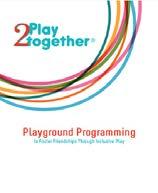
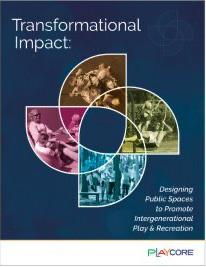
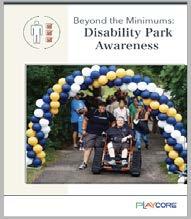


Keith Christensen, RLA, Ph.D.
Uncover Tools You Can Use at the Resource Library
Utilizing research findings, we provide a robust library of resources to help communities implement best practices for planning and design, curriculum and programming, advocacy, and community impact initiatives. Some of our inclusion resources include Beyond the Minimums: Disability Park Awareness, Transformational Impact, and 2Play Together. We also offer a robust list of funders that can help turn dreams into reality. Check them out at playcore.com/resources.


Engage in Learning at the Professional Development Hub
Combining research and resources, we provide tailored learning opportunities and Continuing Education Units (CEUs). In addition to our platform at education.playcore.com, we offer professional development learning opportunities through conferences and a variety of in person events. Discover more at education.playcore.com.
Utilize the Data Service Lab to Measure Impact
We partner with our brands to help communities apply research and design best practices to their projects for high quality environments that are recognized as National Demonstration Sites (NDS). These sites receive recognition and participate in a variety of data services that allow them to measure and showcase the positive impact the site is making on Community Vitality. PlayCore’s National Demonstration Sites exemplify quality, evidence-based practices and provide meaningful ways for community stakeholders to gather data about the sites’ impact on health and wellness outcomes. To learn more, visit playcore.com/nds.
Join us in our mission to build healthy communities through the power of inclusive play & recreation. Together we can create inclusive play spaces that develop the whole child, the whole environment, and ultimately, whole communities.
www.playcore.com/contact
What is Community Vitality?
*waiting to see if y’all have the Community Vitality Framework working file or png files*
CORE is committed to researching and validating the essential roles play and recreation have in impacting a community’s overall health and wellness. The Community Vitality Framework provides a methodology to organize hundreds of data sets and validate a data storytelling approach to position impact. Seven key indicators frame the holistic benefits, and supporting topics and subtopics add additional data detail, and powerful considerations for providing and documenting high-quality play and recreation experiences that develop the whole child, whole environments, and whole communities. CORE’s resources are intentionally aligned to the Framework as a way to organize evidence-based data and community impact through data storytelling. This publication is primarily focused on the Community Vitality benefits of diversity, equity, and inclusion, but also aligns in many ways with each indicator of Community Vitality.
Inclusive play and recreation spaces provide immeasurable benefits. First, they promote social and emotional health in a number of ways. People feel included when they can be successful in an environment that is designed to meet their needs. This self-esteem can lead to healthy social relationships between people, which is associated with a wide range of positive educational and developmental outcomes.43 Additionally, spaces designed with the 7 Principles of Inclusive Playground Design promote physical health & lifestyle behaviors by intentionally helping people of all abilities succeed in physical play to the greatest extent possible, which is desired by all children with and without disabilities. These multifaceted play experiences include the desire for fun, challenge, and intense play, the wish to self-direct play, and the value of playing alone as well as with others.44
The very nature of inclusive play spaces helps promote diversity, equity, and inclusion, and this aspect is a major focus of the design principles found in this publication. All people benefit from play, regardless of age, ability, or other characteristics. While people often associate play with children, consider parents who may have disabilities and older caregivers’ ability to access and use a play environment, and the richness it can add to family experiences and memories.
Inclusive play spaces promote community engagement; public parks and playgrounds serve as community hubs, fostering social interactions, promoting wellness, and enhancing quality of life. Innovative inclusive design, supported by community participation, can be a key component in creating vibrant, inclusive, and well-loved public spaces in communities. Providing this public service demonstrates that a community cares about the people who live, work, and play there, and can contribute to a more vibrant, desirable place to live.
Finally, the environmental and educational benefits associated with inclusion are many, and in some cases interrelated. The natural environment provides learning and appreciation and is a valuable learning resource with benefits such as leadership, team-building, problem-solving, and awareness of the environment.45 Being around diverse peers helps children understand and value the unique aspects of what makes each person different and embrace those differences in the classroom.46 Being around people who are different from us also makes us more creative, more diligent, and harder-working.47 A recent study also demonstrated how academic self-concepts of elementary school children are closely related to their self-esteem and self-perceptions of social integration, irrespective of the classroom setting.48
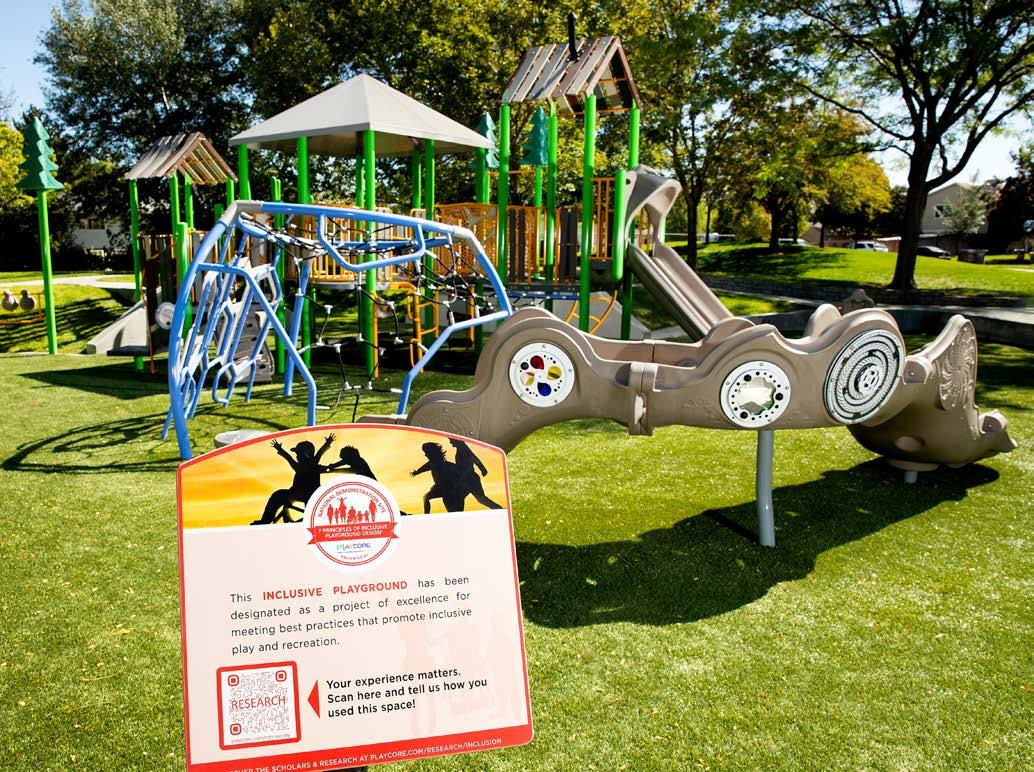
Supporting Research, Resources, and References
Research
• Compared to the general population, research shows that children with physical, sensory, and cognitive disabilities have substantially greater difficulty participating in regular physical activity. Youth with physical disabilities had 4.5 times higher rate of physical inactivity compared to peers without disabilities.49
• Play helps children manage their emotions, learn self-control, address conflict, negotiate, self-advocate, and share in the context of power, space, and ideas.50
• Children with physical disabilities are found to play less and play less well,51 with demonstrated deficits in complex and pretend play
• Learning to explore and interact with objects, people, and the environment through play is difficult for children with physical disabilities.52
• Among children with disabilities, independent of the health conditions associated with their primary disability, children with disabilities have lower levels of cardiorespiratory fitness, lower levels of muscular endurance, and higher rates of obesity than children who are typically developing.53
• Children with physical and developmental disabilities are significantly more likely to be obese or overweight compared to peers without disabilities of the same age.54
• Regular physical activity for children with disabilities has been shown to help in controlling the occurrence of chronic disease, improving overall health and function, and mediating the psychosocial impact of disability on children and their families.55
• Play allows children to develop social skills through interaction in a non-threatening situation; such as planning ahead, roles, positive feedback, confidence, turn-taking, sharing, social and cultural ideas and standards, perspective- taking, empathy, values, and moral ethics 56
• Play allows children to express themselves, interact with the world, and in turn, see how the world interacts with them. This allows children to learn who they are, feel comfortable with their feelings, and to correctly express these feelings in a social context.57
• Children with disabilities are at risk of difficulties establishing peer relations. Often, children with disabilities have deficiencies in social development (Brodin, 2005-54) and smaller repertoires of peer-related social behaviors.58
• Shared thinking involving the coordination of joint activity, which occurs across the social environment of play, is critical to cognitive development 59
• For children with communicative disabilities, these impairments can become less of a challenge through play because play facilitates social interactions not only through speech but also through the activities afforded.60
• The benefits of engaging in active, independent play for children with disabilities are significant in developing self-determination and are very pertinent to the experiences of the child with disabilities.61
• Children engaged in play experience a general reduction in anxiety. 62
• Play helps children deal with trauma and unpleasant situations, perhaps as a result of disabling or chronic health conditions.63
• Increased opportunities for self-determination, through play, increases children’s resilience to stress Whereas decreased play opportunities can lead to self-doubt, reduced self-confidence, and motivation.64
• Ample play opportunities have been shown to increase self-esteem in children.65
• Play is an important mechanism whereby children begin to understand that other children have feelings and emotions as well, which can lead to a person using more positive social behavior (63), contributing to greater instances of positive reciprocal relationships between children with and with out disabilities and thereby greater emotional well-being.
• Children with disabilities report lower levels of happiness and life satisfaction, and much higher rates of mental health problems compared with children without disabilities.66
• The concept of a ‘sensory diet’ suggests that a child needs to receive an appropriate amount and type of sensory stimulation for development.67
• Playground activities and the whole environment need to be simple to understand, as children with intellectual disabilities have been shown to avoid complex play settings fearing they might use it wrong and be teased.68
Resources:
American Society for Testing and Materials- astm.org
Center for Disease Control- cdc.gov
Department of Justice- justice.gov
Disability Etiquette- unitedspinal.org/disability-etiquette
Disability Statistics- disabilitystatistics.org
Institute of Disability Research, Policy & Practice- drpp.usu.edu/about/
International Play Equipment Manufacturers Association- ipema.com
National Center on Accessibility- ncaonline.org
National Council on Disability- ncd.gov/resources
National Recreation and Park Association- nrpa.org
Natural Learning Initiative-naturalearning.org
PlayCore’s Funding Tool- playcore.com/funding
PlayCore’s National Demonstration Site Program- playcore.com/nds
PlayCore’s Professional Development Hub- education.playcore.com
PlayCore’s Resources on Inclusive Play- playcore.com/inclusiveplay
United States Access Board- access-board.gov
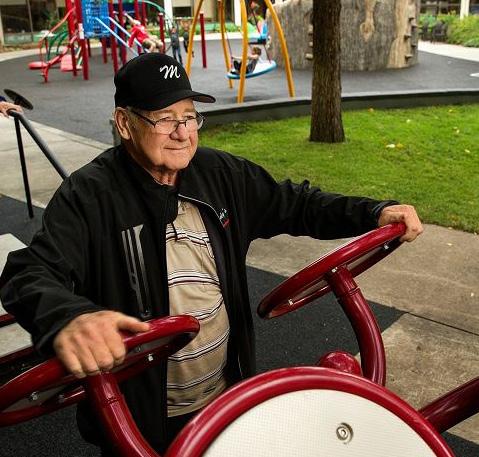
1 The Center for Universal Design (1997). The Principles of Universal Design, Version 2.0. Accessed December 17, 2023 from https://design.ncsu.edu/research/ center-for-universal-design/
2 https://www.cpha.ca/sites/default/files/uploads/ resources/play/play_accessibility_summary_e.pdf
3 https://design.ncsu.edu/research/center-foruniversal-design/
4 Diamond, A. (2007). Interrelated and interdependent. Developmental Science, 10(1), 152–58.
5 Childress, D. C. (2010). Play behaviors of parents and their young children with disabilities. Topics in Early Childhood Special Education, 31, 112-120.
6 Cohen, Julie & Onunaku, Ngozi & Clothier, Steffanie & Poppe, Julie. (2005). Helping Young Children Succeed Strategies to Promote Early Childhood Social and Emotional Development.
7 National Research Council (US) and Institute of Medicine (US) Committee on Integrating the Science of Early Childhood Development. From Neurons to Neighborhoods: The Science of Early Childhood Development. Shonkoff JP, Phillips DA, editors. Washington (DC): National Academies Press (US); 2000.
8 Jarrold, C., Boucher, J., & Smith, P. K. (1996). Generativity defects in pretend play in autism. British Journal of Developmental Psychology, 14(3), 275–300.
9 Arnaiz, Pilar & Segado Vazquez, Francisco & Serrano, Laureano. (2011). Autism and the Built Environment. 10.5772/20200.
10 Jordan, Rita. (2003). Social Play and Autistic Spectrum Disorders A Perspective on Theory, Implications and Educational Approaches. Autism 7 (4): 347–360. Arnaiz, Pilar & Segado Vazquez, Francisco & Serrano, Laureano. (2011). Autism and the Built Environment. 10.5772/20200.
11 Kern, Petra & Aldridge, David. (2006). Using Embedded Music Therapy Interventions to Support Outdoor Play of Young Children with Autism in an Inclusive Community-Based Child Care Program. Journal of music therapy. 43. 270-94.
12 Koegel RL, Firestone PB, Kramme KW, Dunlap G. Increasing spontaneous play by suppressing self stimulation in autistic children. J Appl Behav Anal. 1974 Winter;7(4):521-8.
13 Menear, K.S., Smith, S.C., & Lanier, S. (2006). A multi purpose fitness playground for individuals with autism: Ideas for design and use. Journal of Physical Education, Recreation, and Dance, 77(9), 20-25
14 Kennedy, C. (2014). Sensory diets in outdoor play environments. California Parks & Recreation: 7(3), 8-12.
15 Lynch, S., & Simpson, C. (2004). Sensory processing: Meeting individual needs using the seven senses. Young Exceptional Children, 7(4), 2-9.
16 Williamson, G. & Anzalone, Marie. (2001). Sensory Integration and Self-Regulation in Infants and Toddlers: Helping Very Young Children Interact with Their Environment.
17 Lynch, S. (2000). Sensory processing problems: Often overlooked in assessment. The Dialog, 30(1), 7-10.
18 Dawson G, Watling R. Interventions to facilitate auditory, visual, and motor integration in autism: a review of the evidence. J Autism Dev Disord. 2000 Oct;30(5):415-21. Harrison J, Hare DJ. Brief report: assessment of sensory abnormalities in people with autistic spectrum disorders. J Autism Dev Disord. 2004 Dec;34(6):727-30. Myles, Brenda & Hagiwara, Taku & Dunn, Winnie &
Rinner, Louann & Reese, Matthew & Huggins, Abby & Becker, Stephanie. (2004). Sensory Issues in Children with Asperger Syndrome and Autism. Education and Training in Developmental Disabilities. 39 Volkmar FR, Cohen DJ, Paul R. An evaluation of DSMIII criteria for infantile autism. J Am Acad Child Psychiatry. 1986 Mar;25(2):190-7.
19 Jordan, Rita. (2003). Social Play and Autistic Spectrum Disorders A Perspective on Theory, Implications and Educational Approaches. Autism 7 (4): 347–360. Arnaiz, Pilar & Segado Vazquez, Francisco & Serrano, Laureano. (2011). Autism and the Built Environment. 10.5772/20200
20 Volkmar FR, Cohen DJ, Paul R. An evaluation of DSMIII criteria for infantile autism. J Am Acad Child Psychiatry. 1986 Mar;25(2):190-7.
21 Gillott A, Furniss F, Walter A. Anxiety in high-functioning children with autism. Autism. 2001 Sep;5(3):277-86.
22 Mostafa, Magda. (2008). An Architecture for Autism: Concepts of Design Intervention for the Autistic User. Archnet-IJAR : International Journal of Architectural Research. 2.
23 Lu, Lucy & Petersen, Fiona & Lacroix, Louise & Rousseau, Cécile. (2010). Stimulating creative play in children with autism through sandplay. Arts in Psychotherapy - ART PSYCHOTHER. 37. 56-64.
24 Gaines, K., & Curry, Z. (2011). The Effects of Color on Learning and Behavior. Journal of Family and Consumer Sciences Education.
25 Nicolosi, L., Harryman, E., & Kresheck, J. (2004). Terminology of communication disorders: Speech-language-hearing. Lippincott Williams & Wilkins. The Center for Universal Design (1997).
26 Owen, Leslie. (2023). Three Domains of Learning: Cognitive, Affective, Psychomotor, Accessed December 17, 2023 from https://thesecondprinciple.com /instructional-design/threedomainsoflearning/
27 Bartolotta, T., Shulman, B. (2013). Child development. Language Development: Foundations, Processes, and Clinical Applications. Jones & Bartlett Publishers, 35-53.
28 Banich, M. T. (2009). Executive Function: The Search for an Integrated Account. Current Directions in Psychological Science, 18(2), 89-94.
29 Carr, V., Brown, R. D., Schlembach, S., & Kochanowski, L. (2017). Nature by design: Playscape affordances support the use of executive function in preschoolers. Children, Youth and Environments, 27(2), 25-46.
30 Cook C.J., Howard S.J., Scerif G., Twine R., Kahn K., Norris S.A., Draper C.E. Associations of physical activity and gross motor skills with executive function in preschool children from low-income South African settings. Dev. Sci. 2019;22:e12820.
31 Mundy P, Crowson M. Joint attention and early social communication: implications for research on intervention with autism. J Autism Dev Disord. 1997 Dec;27(6):653-76.
32 Thomas, N., & Smith, C. (2004). Developing Play Skills in Children with Autistic Spectrum Disorders. Educational Psychology in Practice, 20(3), 195–206.
33 Harper CB, Symon JB, Frea WD. Recess is time-in: using peers to improve social skills of children with autism. J Autism Dev Disord. 2008 May;38(5):815-26.
34 Yang TR, Wolfberg PJ, Wu SC, Hwu PY. Supporting children on the autism spectrum in peer play at home and school: piloting the integrated play groups model in Taiwan. Autism. 2003 Dec;7(4):437-53.
35 Bravo A, Schwartz I. Teaching Imitation to Young Children with Autism Spectrum Disorder Using Discrete Trial Training and Contingent Imitation. J Dev Phys Disabil. 2022;34(4):655-672.
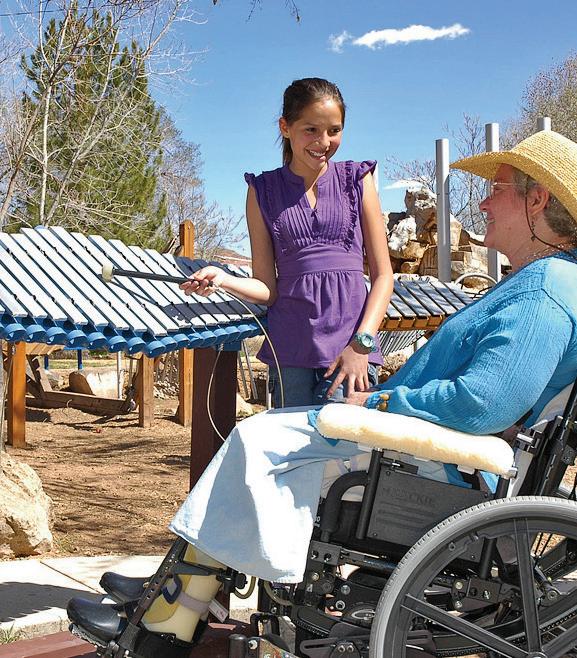
doi: 10.1007/s10882-021-09819-4.
36 The Center for Universal Design (1997). The Principles of Universal Design, Version 2.0. Accessed December 17, 2023 from https://design.ncsu.edu/research/center-foruniversal-design/
37 Lu, Lucy & Petersen, Fiona & Lacroix, Louise & Rousseau, Cécile. (2010). Stimulating creative play in children with autism through sandplay. Arts in Psychotherapy - ART PSYCHOTHER. 37. 56-64.
38 Cooper, D. G. (2003). Promoting disability awareness in preschool. Unpublished doctoral dissertation, Purdue University, W. Lafayette, IN
39 Wolery, M. (1994). Designing inclusive environment for young children with special needs. In M. Wolery & J.S. Wilbers (Eds). Including children with special needs in early childhood programs. National Association of Young Children: Washington, D.C.
40 Schwartz, I.S., Billingsley, F.F. and McBride, B. (1998). Including children with autism in inclusive preschools: Strategies that work. Young Exceptional Children, 2 (1). 19-26.
41 DEC/NAEYC. (2009). Early childhood inclusion: A summary. Chapel Hill: The University of North Carolina. FPG Child Development Institute.
42 https://www.nrpa.org/parks-recreation-magazine/2022/ september/dr.-temple-grandin-on-the-importance-ofoutdoor-play/
43 Arslan, G., Yıldırım, M., Tanhan, A., Kılınç, M. (2023). Social Inclusion to Promote Mental Health and Well-Being of Youths in Schools. In: Boyle, C., Allen, KA. (eds) Research for Inclusive Quality Education. Sustainable Development Goals Series. Springer, Singapore. https://doi.org/10.1007/978-981-16-5908-9_9
44 Morgenthaler, T.; Schulze, C.; Pentland, D.; Lynch, H. Environmental Qualities That Enhance Outdoor Play in Community Playgrounds from the Perspective of Children with and without Disabilities: A Scoping Review. Int. J. Environ. Res. Public Health 2023, 20, 1763. https://doi.org/10.3390/ijerph20031763
45 Brodin, Jane. (2009). Inclusion through access to outdoor education: Learning in Motion (LIM). Journal of Adventure Education and Outdoor Learning. 9. 99-113. 10.1080/14729670903004340.
46 Odom, S., McConnel, S., & Chandler, L. (1993). Acceptability and feasibility of classroom-based social interaction interventions for young children with disabilities. Exceptional Children, 60(3), 226-236.
47 https://med.emory.edu/departments/pathology/ _documents/how-diversity-makes-us-smarter.pdf. Retrieved 11/20/2023
48 Lohbeck, A. Does integration play a role? Academic self-concepts, self-esteem, and self-perceptions of social integration of elementary school children in inclusive and mainstream classes. Soc Psychol Educ 23, 1367–1384 (2020). https://doi.org/10.1007/s11218-020-09586-8
49 Steele C.A., Kalins I.V., Rossen B.E., Biggar D.W., Bortolussi J.A., & Jutai J.W. (2004). Age-related health risk behaviors of adolescents with physical dis abilities. Soz-Praventivmed, 49, 132-141.
50 Garvey, C. (1990). Play. Cambridge: Harvard University Press.
51 Childress, D. C. (2011). Play Behaviors of Parents and Their Young Children With Disabilities. Topics in Early Childhood Special Education, 31(2), 112-120.
52 Martin, S. (2014). Play in children with motor disabilities. Dissertation; University of Kentucky.
53 Murphy, N. A., & Carbone, P. S. (2008). Promoting the participation of children with disabilities in sports,
recreation, and physical activities. Pediatrics, 121(5), 1057- 1061.
54 Rimmer, J.H. & Rowland, J.A. (2008). Physical activity for youth with disabilities: A critical need in an underserved population. Developmental Neurorehabilitation, 11(2), 141-148
55 Prellwitz, M., & Skär, L. (2007). Usability of playgrounds for children with different abilities. Occupational Therapy International, 14(3), 144-155.
56 Prellwitz, M., & Skär, L. (2007). Usability of playgrounds for children with different abilities. Occupational Therapy International, 14(3), 144-155. Isenberg, J. P. & Quisenberry, N. (2002). A position paper of the Association for Childhood Education International— PLAY: Essential for all children. Childhood Education 79(1), 33–39.
Barnett, L. (1990). Developmental benefits of play for children. Journal of Leisure Research, 22(2), 138-153. Selman, R. (1976). Social-cognitive understanding. A guide to educational and clinical practice. In T. Lickona, Moral Development and Behavior. Theory, Research, and Social Issues, 299-316. New York: Holt, Rinehart, & Winston.
Garvey, C. (1990). Play. Cambridge: Harvard University Press.
Hildebrand, V. (1994). Guiding Young Children (5th Ed.). New York: Macmillan College Publishing Company. Carmichael, K. (1994). Play therapy for children with physical disabilities. Journal of Rehabilitation, 60(3), 51-53.
57 Isenberg, J. P. & Quisenberry, N. (2002). A position paper of the Association for Childhood Education International— PLAY: Essential for all children. Childhood Education 79(1), 33–39.
58 Guralnick, M. (1986). The peer relations of young handicapped and nonhandicapped children. In P. Strain, M. Guralnick, & H. Walker (Eds.), Children’s social behavior: Development, assessment, and modification,93-140. Orlando, FL: Academic.
59 Tudge, J., & Rogoff, B. (1999). Peer influences on cognitive development: Piagetian and Vygotskian perspectives. Lev Vygotsky: Critical Assessments, 3, 32-56.
60 Semrud-Clikeman, M. (2007). Social competence in children. New York, NY: Springer.
61 Woolley, H., Armitage, M., Bishop, J., Curtis, M., & Ginsborg, J. (2006). Going outside together: Good practice with respect to the inclusion of disabled children in primary school playgrounds. Children’s Geographies, 4(3), 303-318.
62 Barnett, L. (1990). Developmental benefits of play for children. Journal of Leisure Research, 22(2), 138-153
63 Garvey, C. (1990). Play. Cambridge: Harvard University Press.
64 McCune, L., & Zanes, M. (2001). Learning, attention, and play. In S. Golbeck, Psychological Perspectives on Early Childhood Education,92-106. Mahwah, NJ: Lawrence Erlbaum.
65 Ekeland, E., Heian, F., & Hagen, K. B. (2005). Can exercise improve self-esteem in children and young people? A systematic review of randomized controlled trials. British Journal of Sports Medicine, 39(11), 792-798.
66 McDougall, J., DeWit, D. J., Nichols, M., Miller, L., & Wright, F.V. (2016). Three-year trajectories of global perceived quality of life for youth with chronic health conditions. Quality of Life Research, 1-15. Savage, A., McConnell, D., Emerson, E., & Llewellyn, G. (2014). Disability-based inequity in youth subjective well-being: Current findings and future directions. Dis ability & Society, 29(6), 877-892.
67 Kinnealey, M., Oliver, B., & Wilbarger, P. (1995). A phenomenological study of sensory defensiveness in adults. The American Journal of Occupational Therapy, 49(5), 444-451.
68 Prellwitz, M. (2007). Playground accessibility and usability for children with disabilities. Doctoral Thesis, Lulea University of Technology, Lulea, Sweden. Willenberg, L. J., Ashbolt, R., Holland, D., Gibbs, L., Mac Dougall, C., Garrard, J., Green, J. B., & Waters, E. (2008). Increasing school playground physical activity: A mixed methods study combining environmental measures and children’s perspectives. Journal of Science and Medicine in Sport, 13(2), 210-216.
